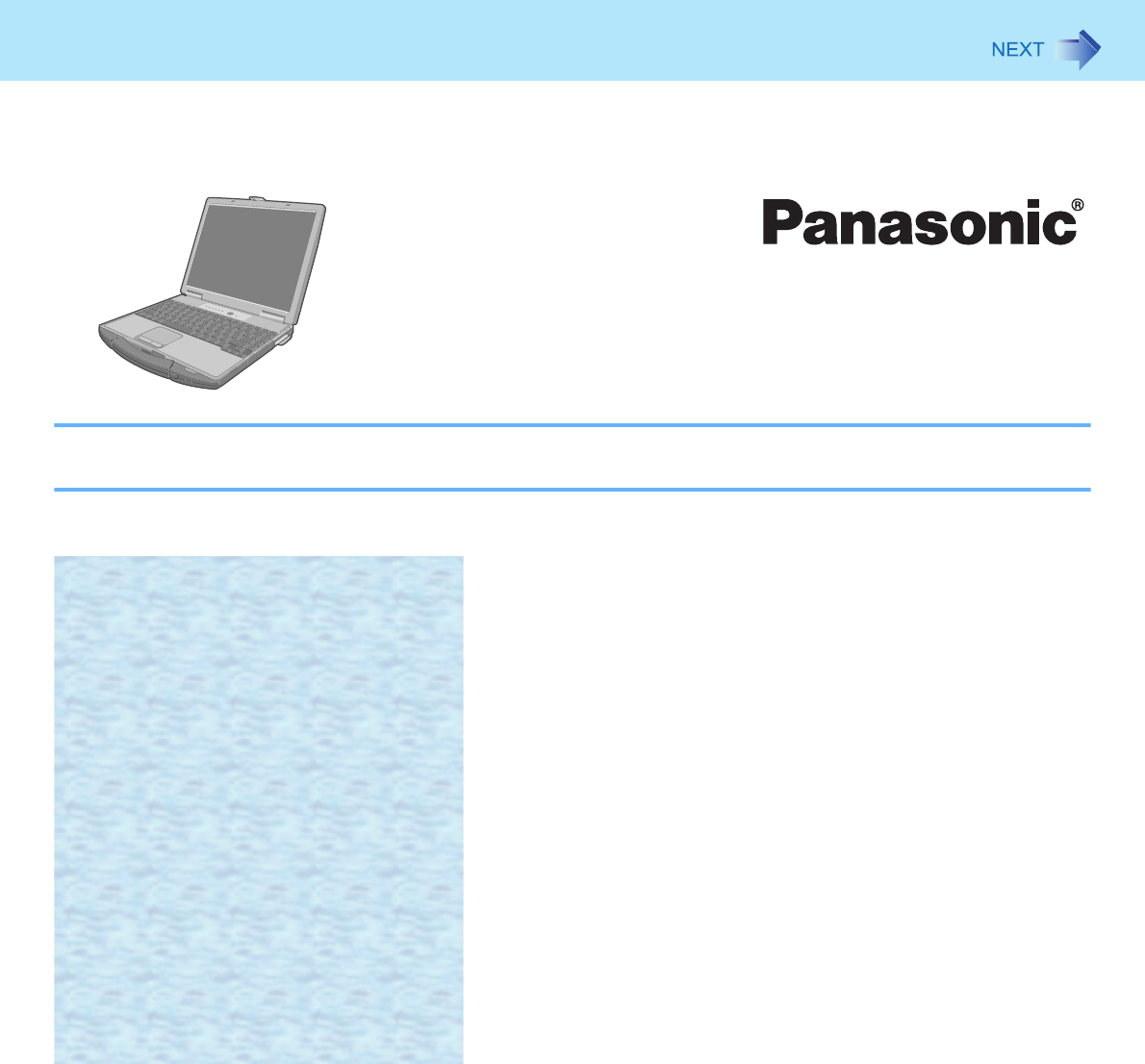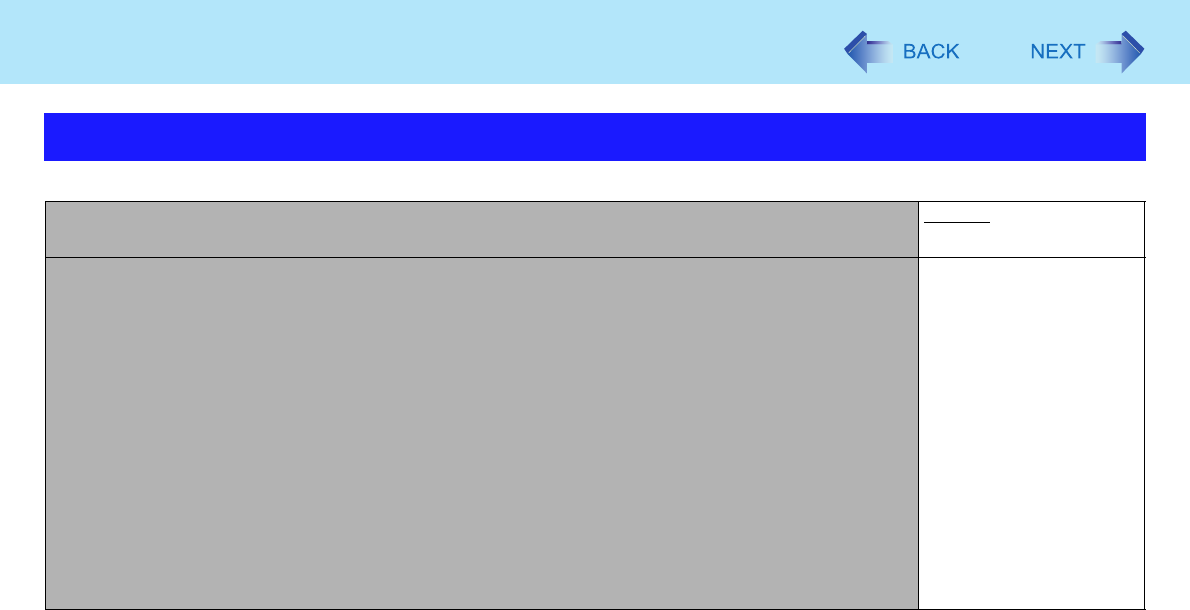Panasonic of North America 9TGCF-743 Notebook PC w/ Cellular/PCS CDMA, WLAN & Bluetooth User Manual Reference Manual
Panasonic Corporation of North America Notebook PC w/ Cellular/PCS CDMA, WLAN & Bluetooth Reference Manual
Contents
Users Manual
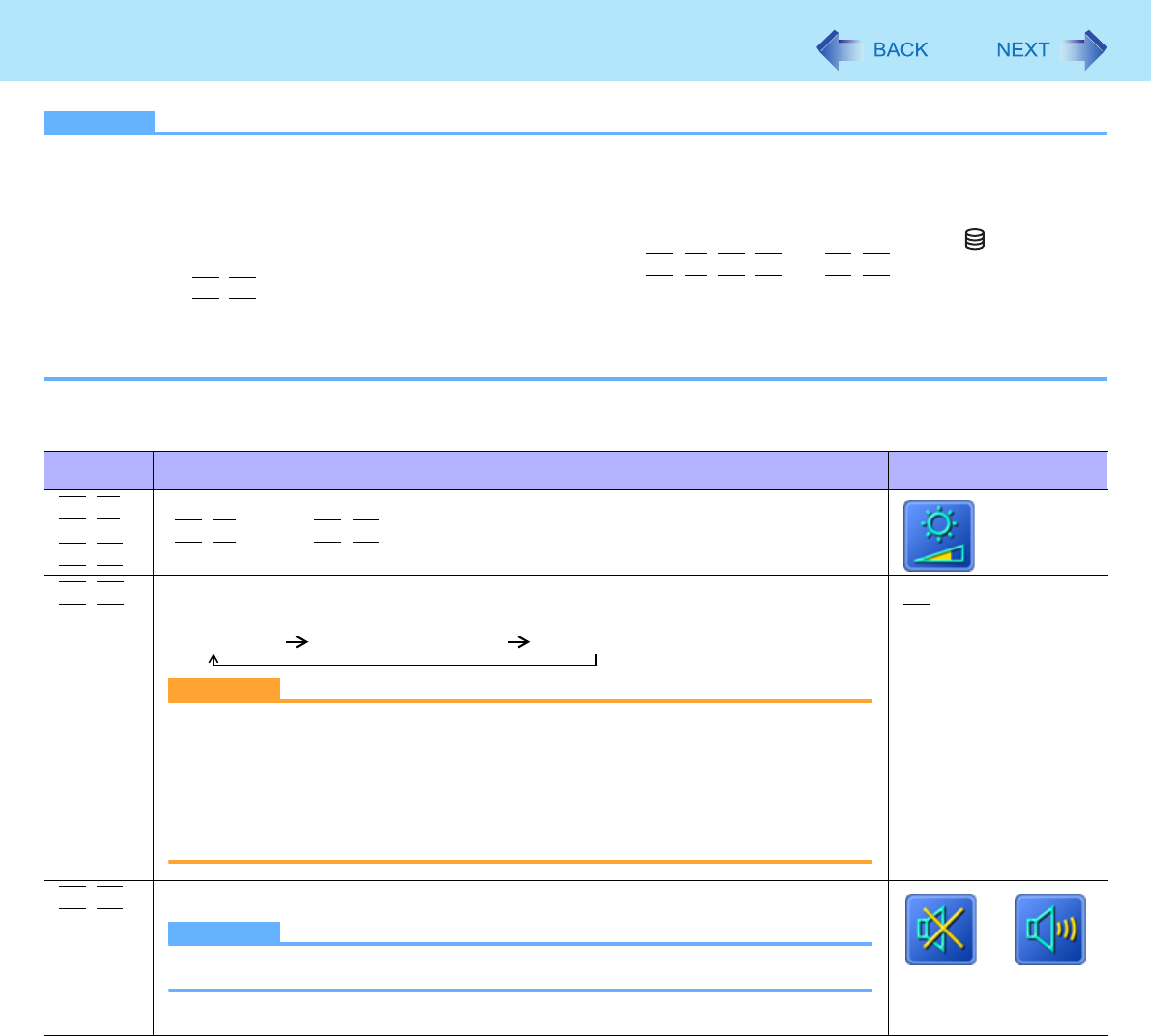
2
Key Combinations
NOTE
zDo not repeatedly press the keys in quick succession.
zDo not use the key combinations together with touch pad (external mouse), touchscreen (only for model with touch-
screen) or other key operations.
zDo not use the key combinations before you log on to Windows. Wait until the hard disk drive indicator turns off.
On the Setup Utility screen, you can use the key combinations of
Fn
+
F1
,
Fn
+
F2
and
Fn
+
F3
. By using the key com-
binations of
Fn
+
F3
, the display is switched between the internal LCD and the external display.
zThe key combinations may not work with some applications.
zThe popup menu icon appears after logging on to Windows. It may not appear in some application conditions (e.g.,
when [Command Prompt] is set to “Full Screen”).
Key Function Popup menu icon
Fn
+
F1
Fn
+
F2
LCD brightness
(
Fn
+
F1
= down /
Fn
+
F2
= up)
Fn
+
F3
Display switching (Îpage 47)
(When an external display is connected)
Internal LCD Simultaneous display External display
CAUTION
zDo not press any keys until the display has finished switching.
zDo not use this function:
• When an external display is not connected.
• When playing motion video such as DVD or MPEG.
• When using the Extended Desktop.
• When showing a game screen such as pinball.
Fn
+
F4
Speaker on/off
NOTE
zBeeps do not sound if you turn off the speaker sound.
OFF
(MUTE)
ON
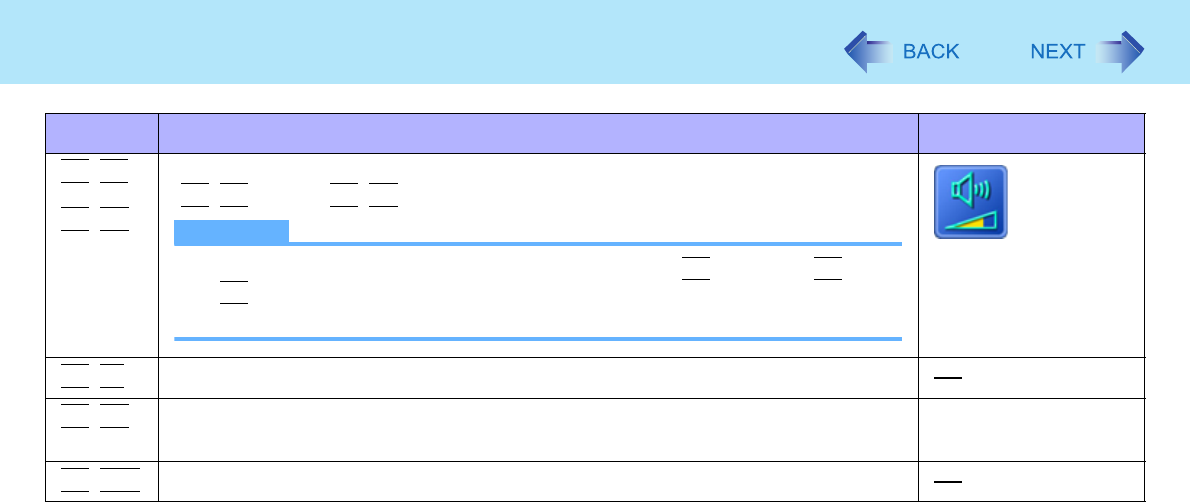
3
Key Combinations
Fn
+
F5
Fn
+
F6
Volume
(
Fn
+
F5
= down /
Fn
+
F6
= up)
NOTE
zWhen fine-tuning the sound volume, press and hold
Fn
, and press
F5
or
F6
intermittently.
zThis does not work on beeps or speakers connected to the USB port.
Fn
+
F7
Activate standby (Îpage 7)
Fn
+
F9
Remaining battery level
(When the battery pack is inserted in the computer)
(Îpage 13)
Fn
+
F10
Activate hibernation (Îpage 7)
Key Function Popup menu icon
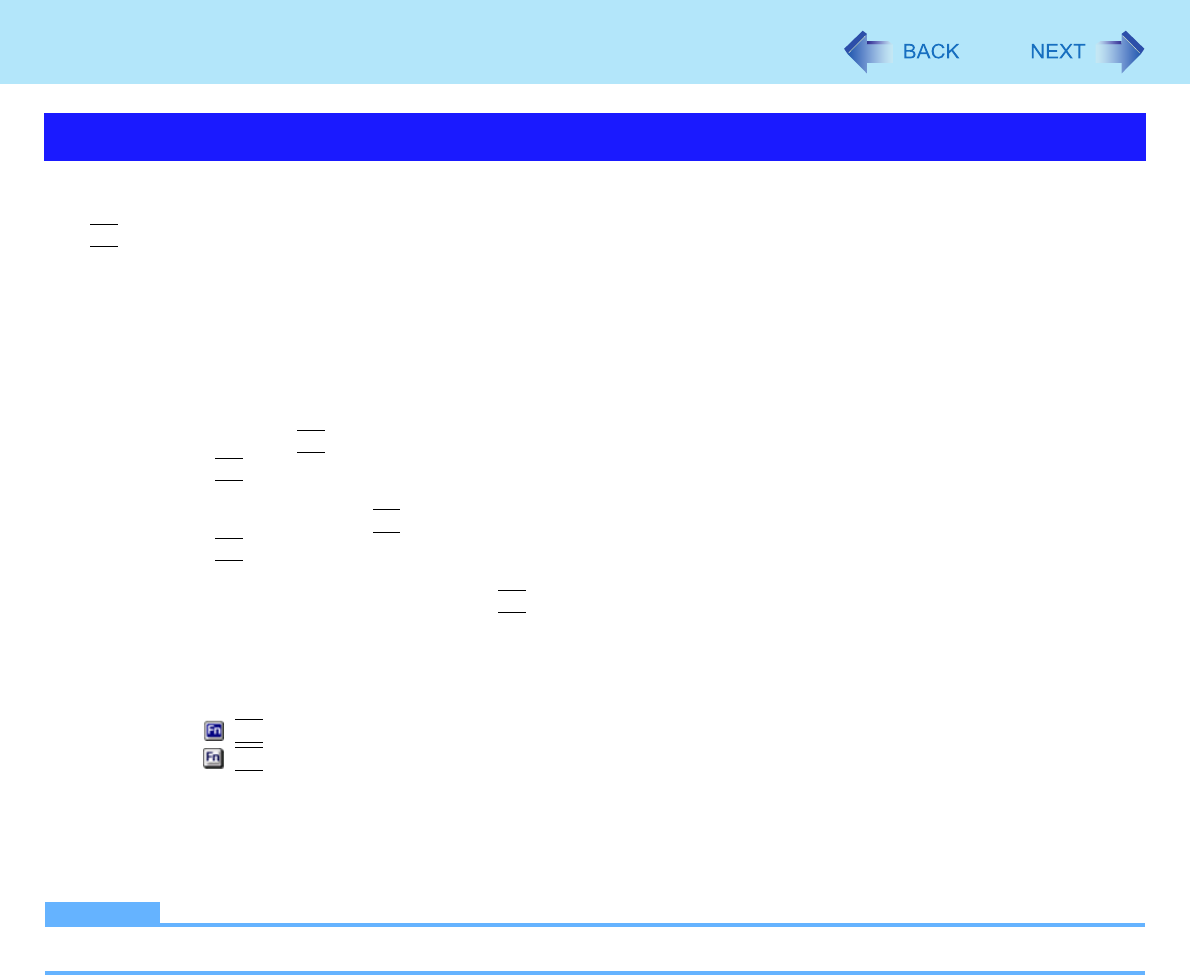
4
Key Combinations
You can make two settings:
•Fn key lock
Fn
is locked (pressed-down) until you press another key. Use this when pressing difficult key combinations.
• Popup menu icon on/off
1Start up the Hotkey Settings.
Click [start] - [All Programs] - [Panasonic] - [Hotkey Settings].
2Make the settings.
[Use Fn key lock]
zWhen using an
Fn
key combination
APress
Fn
once. (Locked)
BPress another key. (Lock released)
zWhen using successive
Fn
key combinations
APress
Fn
twice. (Locked)
BPress another key.
Fn key remains locked until you press
Fn
again.
[Notification]
[Make sounds when Fn key is pressed]*1
[Show status on screen]: Displays the Fn key status on the notification area.
•:
Fn
is locked.
•:
Fn
is not locked.
[Disable popup]
The popup menu icon will not be displayed.
3Click [OK].
NOTE
zYou can have different settings for each user.
*1 If the speakers are muted, beeps do not sound.
Hotkey Settings
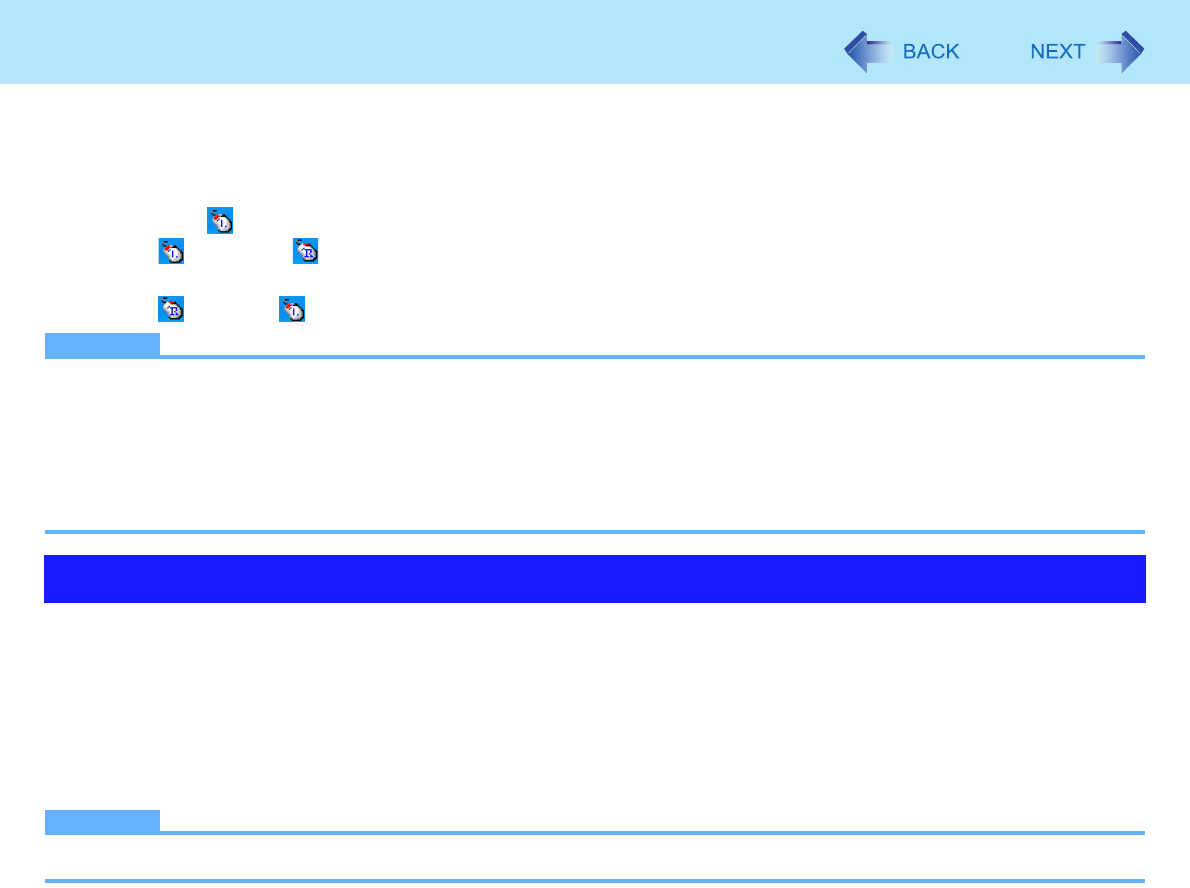
5
Touchscreen
<Only for model with touchscreen>
You can use the touchscreen function to perform the same operation as the touch pad and mouse. Touch the screen surface
with the stylus (included).
zTo right-click
AClick on the notification area.
changes to .
BClick the object you want to right-click.
returns to .
NOTE
zYou need to make the following setting for each user.
AClick [start] - [All Programs] - [Fujitsu Touch Panel (USB)] - [Touch Panel Configuration].
BSelect the settings, and then click [OK].
zDo not add a check mark to [Delete Cursor] since the display may be distorted.
zThe touchscreen function does not work in the Setup Utility, in the full screen of [Command Prompt] or in Recover Pro
(Îpage 75).
1Run [Touch Screen Calibration Utility].
Click [start] - [All programs] - [Fujitsu Touch Panel (USB)] - [Touch Screen Calibration Utility].
2Using the stylus, touch each of the 12 “+” target marks one by one until it blinks, and then
click [Calibration].
3Click [Save & Exit].
NOTE
zPerform the touchscreen calibration for each user.
Touchscreen Calibration
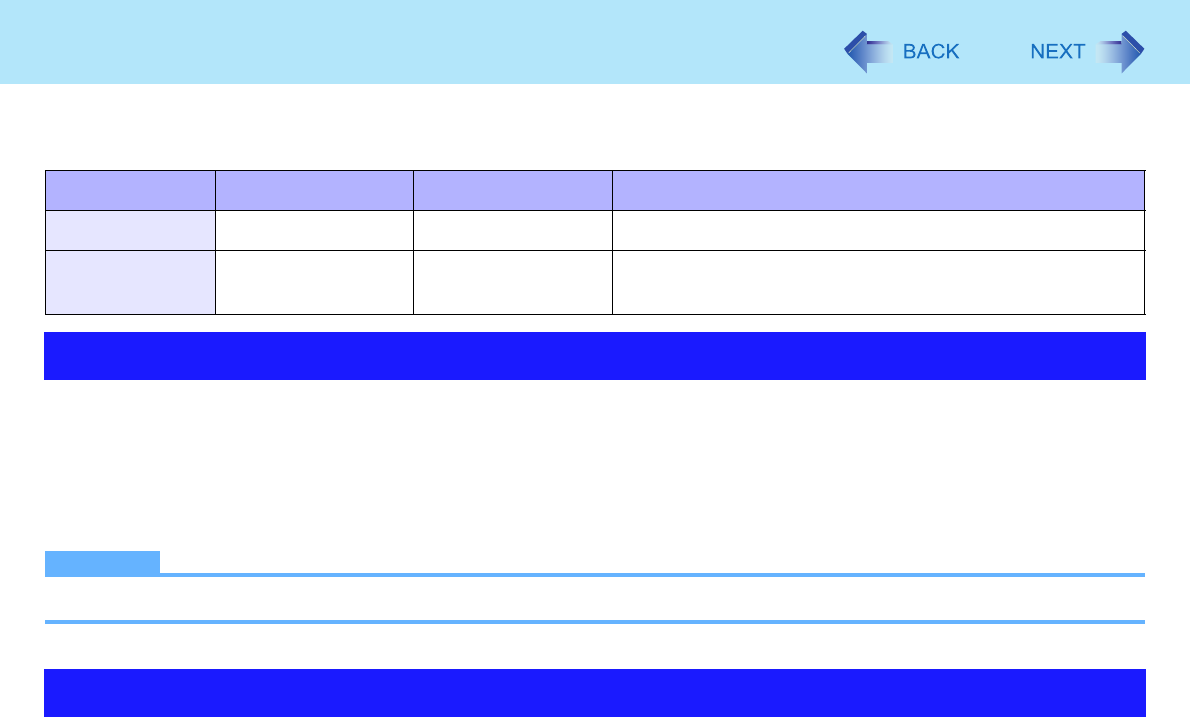
6
Standby or Hibernation Functions
The standby or hibernation functions allow you to shut off the computer without closing programs and documents. You can
quickly return to the programs and documents that you were working on before standby or hibernation.
1Click [start] - [Control Panel] - [Performance and Maintenance] - [Power Options] -
[Advanced].
2Select [Stand by] or [Hibernate] for [When I close the lid of my portable computer:] /
[When I press the power button on my computer:], and then click [OK].
NOTE
zYou do not need to make the setting if you use the Windows menu to enter standby or hibernation.
zConnect the AC adaptor if the computer will be in standby mode for a long period of time. If you cannot use the AC adap-
tor, use hibernation instead.
zUsing standby or hibernation repeatedly may cause malfunction of the computer. To stabilize computer operation, restart
Windows regularly (about once a week) without using standby or hibernation.
zSave the necessary data.
zClose files you have opened from removable disk and network drive.
zThe password you set in the Setup Utility is not requested at resuming. You can use the Windows password for security in
standby or hibernation.
AClick [start] - [Control Panel] - [User Accounts], and select the account.
BClick [Create a password] and set the password.
CClick [start] - [Control Panel] - [Performance and Maintenance] - [Power Options] - [Advanced], and add the
check mark in [Prompt for password when computer resumes from standby].
zDo not enter standby or hibernation in the following condition, otherwise the data or file may be corrupted, standby/hiber-
nation may not work, or malfunction may occur in the computer or the peripheral devices.
Function Data is saved to Recovery time Power supply
Standby Memory Short Required. (If power is not supplied, all data will be lost.)
Hibernation Hard disk Rather long Not required. (However power is slightly consumed to
keep the hibernation.)
Setting Standby or Hibernation
Precautions
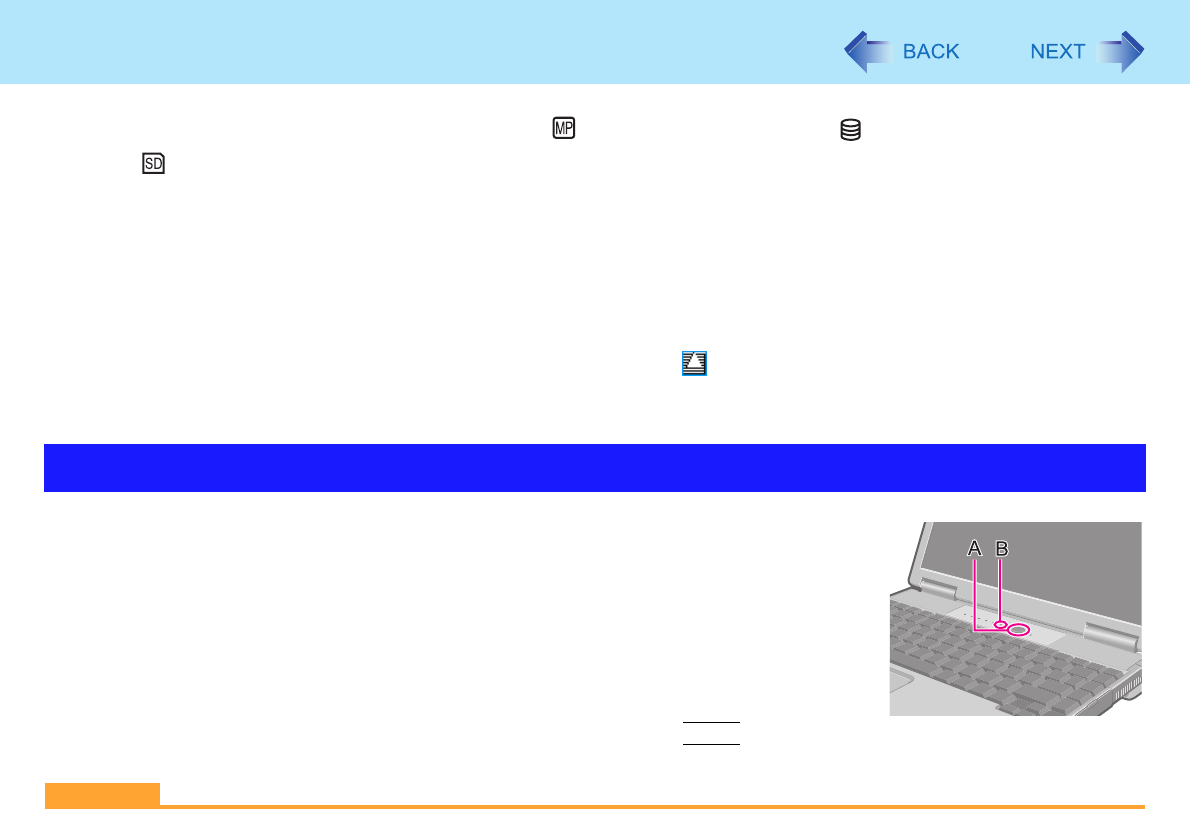
7
Standby or Hibernation Functions
• When any of the multimedia pocket device indicator , the hard disk drive indicator and the SD Memory Card indi-
cator is on.
• When playing/recording audio files or displaying motion video such as MPEG files.
• When playing a DVD-Video.
• When writing to a disk.
• When using communication software or network function.
• When using a PC Card.
(If the card fails to work normally, restart the computer.)
• When an external mouse is connected to the serial port.
zIf a disc formatted with B’s CLiP is inserted into the DVD drive (while is displayed on the notification area), the com-
puter cannot enter standby or hibernation. Eject the disc beforehand.
zThe computer does not enter standby or hibernation immediately after resuming. Wait approximately one minute.
To enter standby or hibernation
1Close the display, or press the power switch (A) until a beep*1
sounds.
Standby: The power indicator (B) blinks green.
Hibernation: The power indicator (B) goes off.
zYou can alternatively use the Windows menu to enter standby or hibernation. To
enter standby, click [start] - [Turn Off Computer] - [Stand By]. To enter hiberna-
tion, click [start] - [Turn Off Computer], then press and hold
Shift
and click
[Hibernate].
CAUTION
While the computer is entering standby or hibernation
zDo not:
• Touch the keyboard, touch pad, touchscreen (only for model with touchscreen), or power switch.
• Use an external mouse or other peripheral device.
• Connect or disconnect the AC adaptor.
• Close or open the display.
Wait until the power indicator blinks green (standby) or goes off (hibernation).
zIt may take one or two minutes to enter standby or hibernation.
zAt the beep*1, immediately release the power switch. If you press and hold the power switch for longer than four sec-
onds, the computer will forcibly shut down and unsaved data will be lost even if you have set [Shut down] in [When I
press the power button on my computer:] (Îpage 6 “Setting Standby or Hibernation”).
Entering/Resuming from Standby or Hibernation
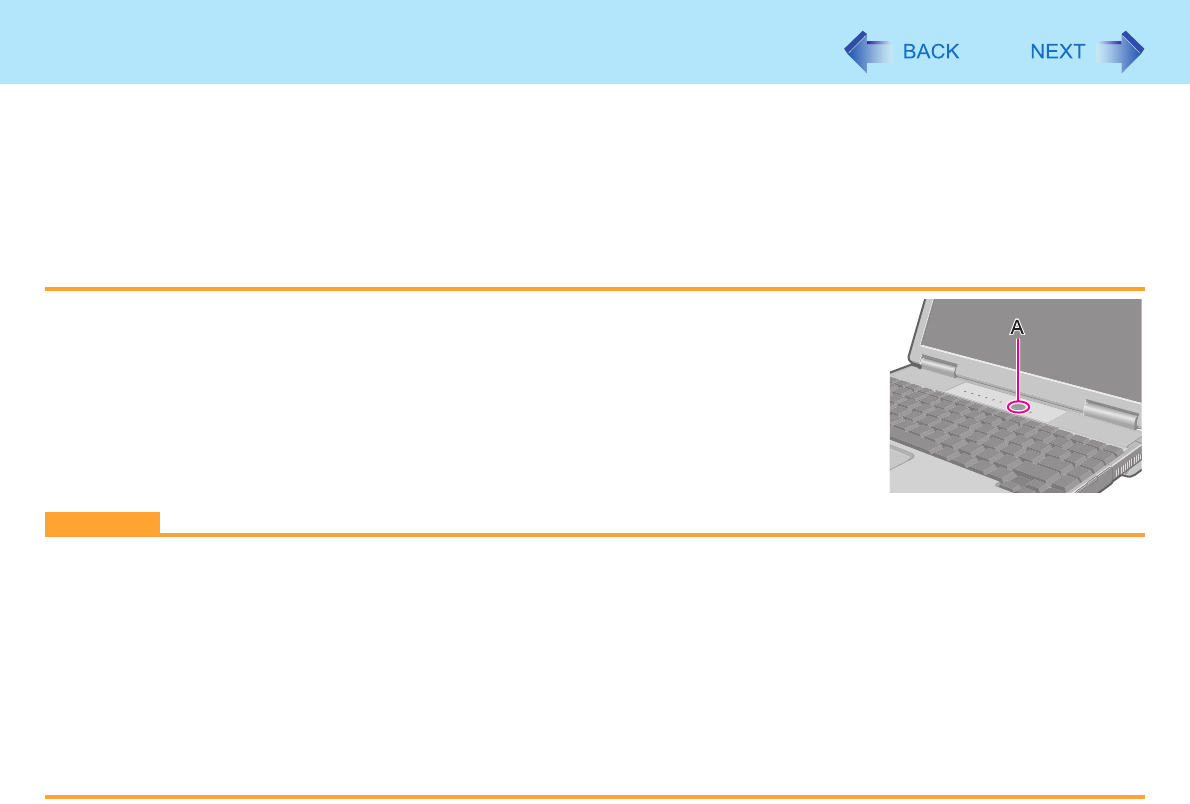
8
Standby or Hibernation Functions
*1 If the speakers are muted, beeps do not sound.
In standby or hibernation
zDo not attach or remove a multimedia pocket device and peripheral device. Doing so may cause malfunction.
zPower is consumed in standby mode. Power consumption may increase when a PC Card is inserted. When power is
exhausted, the data retained in memory will be lost. Connect the AC adaptor when using the standby function.
zDo not turn on/off the wireless switch.
To resume from standby or hibernation
1Open the display, or press the power switch (A).
zWhen [Stand by] or [Hibernation] is selected as the setting for [When I close the
lid of my portable computer] (Îpage 6), you can resume operation opening the
display.
CAUTION
zDo not perform the following operations until resuming is complete. After the display has resumed, wait approximately
30 seconds (normally) or 60 seconds (when the computer is on a network).
• Touch the keyboard (except for password input), touch pad, touchscreen (only for model with touchscreen), or power
switch.
• Use an external mouse or other peripheral device.
• Connect or disconnect the AC adaptor.
• Close or open the display.
• Shut down or restart Windows.
• Enter standby or hibernation.
• Turn on/off the wireless switch.
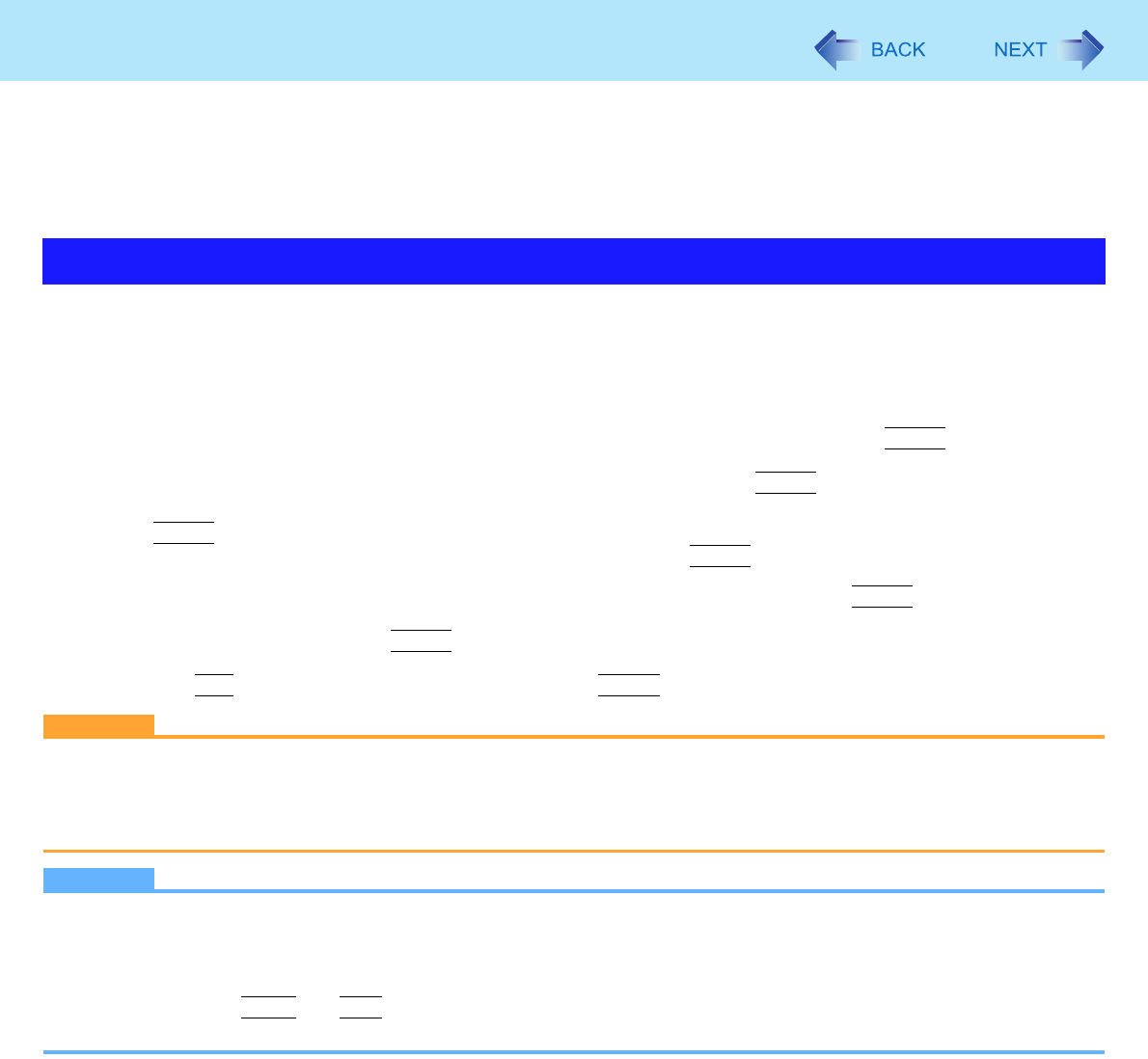
9
Security Measures
Use these features to protect your data.
zOther security measures
• SD Security (Îpage 38)
• Embedded Security (TPM) (Îpage 68): For further information, refer to the Installation Manual of “Trusted Platform
Module (TPM)”.
Set the Supervisor Password before setting the User Password.
1Start up the Setup Utility (Îpage 64).
2Select [Security].
3Select [Set Supervisor Password] or [Set User Password], and press
Enter
.
4Enter your password in [Enter New Password] and press
Enter
.
zWhen the password has been set, you need to enter your password in [Enter Current Password] and press
Enter
.
zTo disable the password, leave the input field empty and press
Enter
.
5Enter your password again in [Confirm New Password] and press
Enter
.
6In [Setup Notice], press
Enter
.
7Press
F10
, and then select [Yes] and press
Enter
.
CAUTION
zDo not forget your password. If you forget your Supervisor Password, you will not be able to use your computer. Con-
tact Panasonic Technical Support.
zWhen running the Setup Utility, do not leave and go away from your computer even for a short time, since other people
may set or change the password.
NOTE
zThe password will not be displayed on the screen.
zYou can use up to 32 alphanumeric characters (including spaces).
• The case (upper/lower) is ignored.
• To input numbers for the password, you can use the numbered keys on the keyboard.
• You cannot use
Shift
and
Ctrl
to input a password.
zDisabling the Supervisor Password also disables the User Password.
Setting the Supervisor Password/User Password
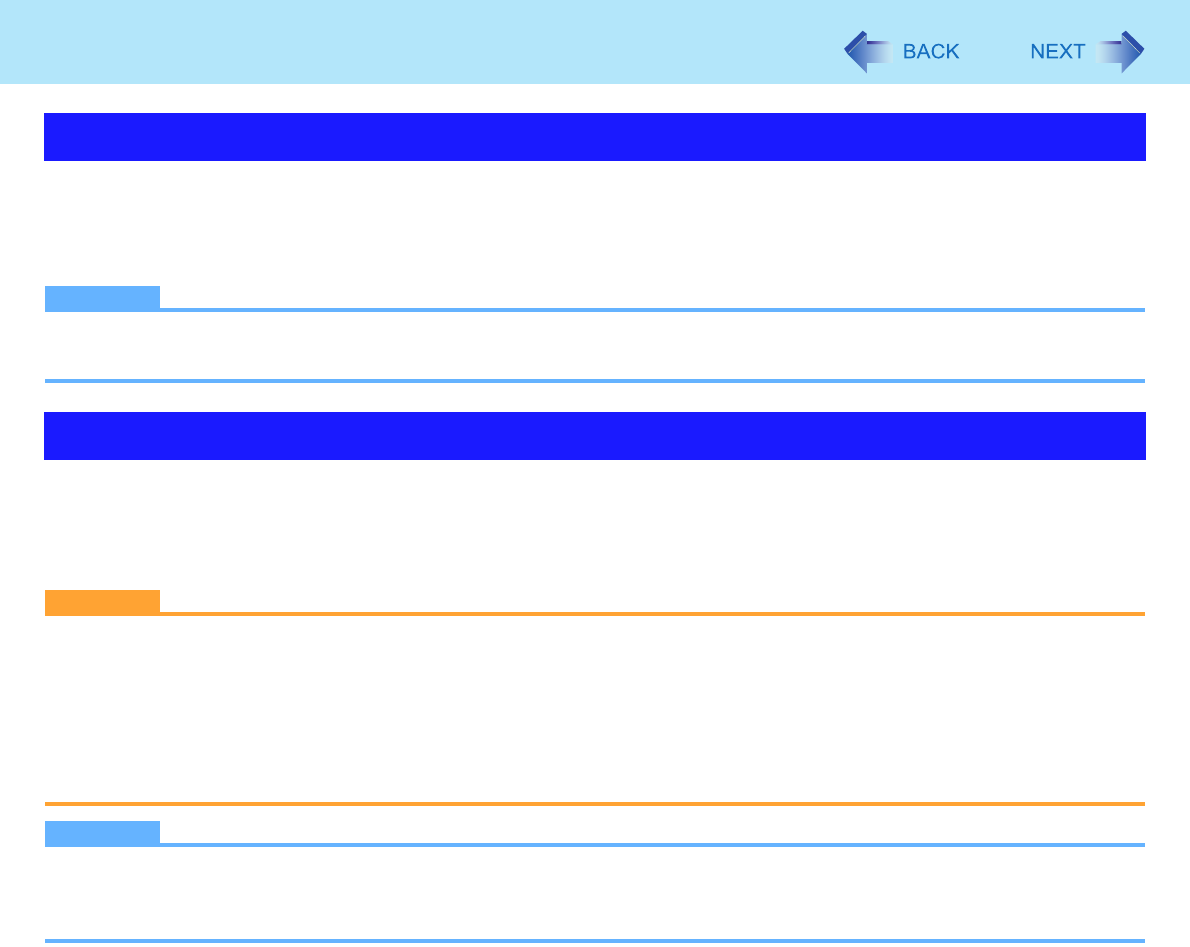
10
Security Measures
You can set a start-up password to protect your computer from unauthorized use.
1Set the password (Îpage 9), and select [Enable] in [Password on boot] in the [Security]
menu of the Setup Utility (Îpage 68).
NOTE
zIf the Supervisor Password or User Password has been set, the password input screen will be displayed on starting-up
of the Setup Utility even though [Password on boot] is set to [Disable].
The hard disk lock function protects the hard disk data from being read or written when the hard disk is attached to another
computer. The data can be read/written when the hard disk is returned to the original computer.
1Select [Enable] in [Hard Disk Lock] in the [Security] menu of the Setup Utility (Îpage 68).
CAUTION
zFor the data being read/written on the original computer, the Setup Utility settings must be the same as when the hard
disk was removed.
zYou cannot use the hard disk lock function without setting the Supervisor Password. Set the Supervisor Password
beforehand (Îpage 9).
zWhen you have your hard disk drive repaired
• Contact Panasonic Technical Support.
• Before sending back the hard disk drive, be sure to set the [Hard Disk Lock] to [Disable].
NOTE
zThe hard disk lock function works with the built-in hard disk. It does not work with the external hard disk.
zWe recommend you to set [Password on boot] to [Enable] to ensure security though it is not required to enable the
hard disk lock. (Note that the hard disk lock does not guarantee complete protection of the data.)
Preventing Your Computer from Unauthorized Use
Preventing Your Hard Disk Data from Being Read or Written

11
Security Measures
Disable DVD drive operation to prevent the drive from being read/written and from being used to start the computer. You can
protect your data from unauthorized access or accidental overwriting.
1Select [Disable] in [DVD Operation] in the [Security] menu of the Setup Utility (Îpage
68).
NOTE
zThis does not work for USB DVD drive.
Disabling DVD Drive
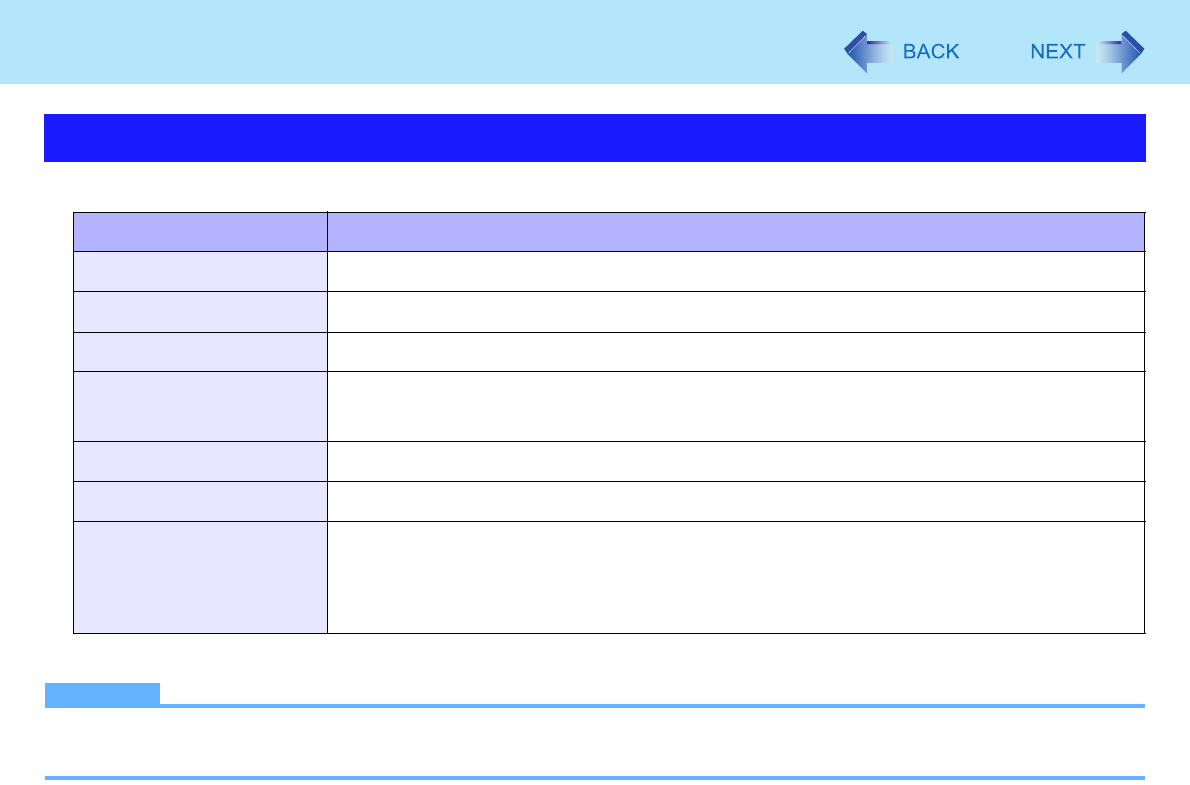
12
Battery Power
*1 In high temperature mode, the 100% battery level is equivalent to 80% level of the normal temperature mode.
NOTE
zOnce the battery is fully charged, the computer performs recharging only when the battery level becomes less than
approximately 95%, so overcharging is avoided.
Battery Indicator
Battery indicator Battery status
Not lit The battery pack is not inserted or not being charged.
Orange Charging is in progress.
Green The battery is fully-charged.
Blinking green In high temperature mode, the battery pack is discharging the power to 80%*1 of normal
temperature mode (Îpage 14). Do not remove the battery pack in this status.
Red The remaining battery is approximately 9% or less.
Blinking red The battery pack or the charging circuit is not operating properly.
Blinking orange The battery cannot be charged temporarily due to the following reasons:
• Its internal temperature is out of the acceptable range.
• The power supply is not enough because software applications or peripheral
devices are consuming a large amount of power.
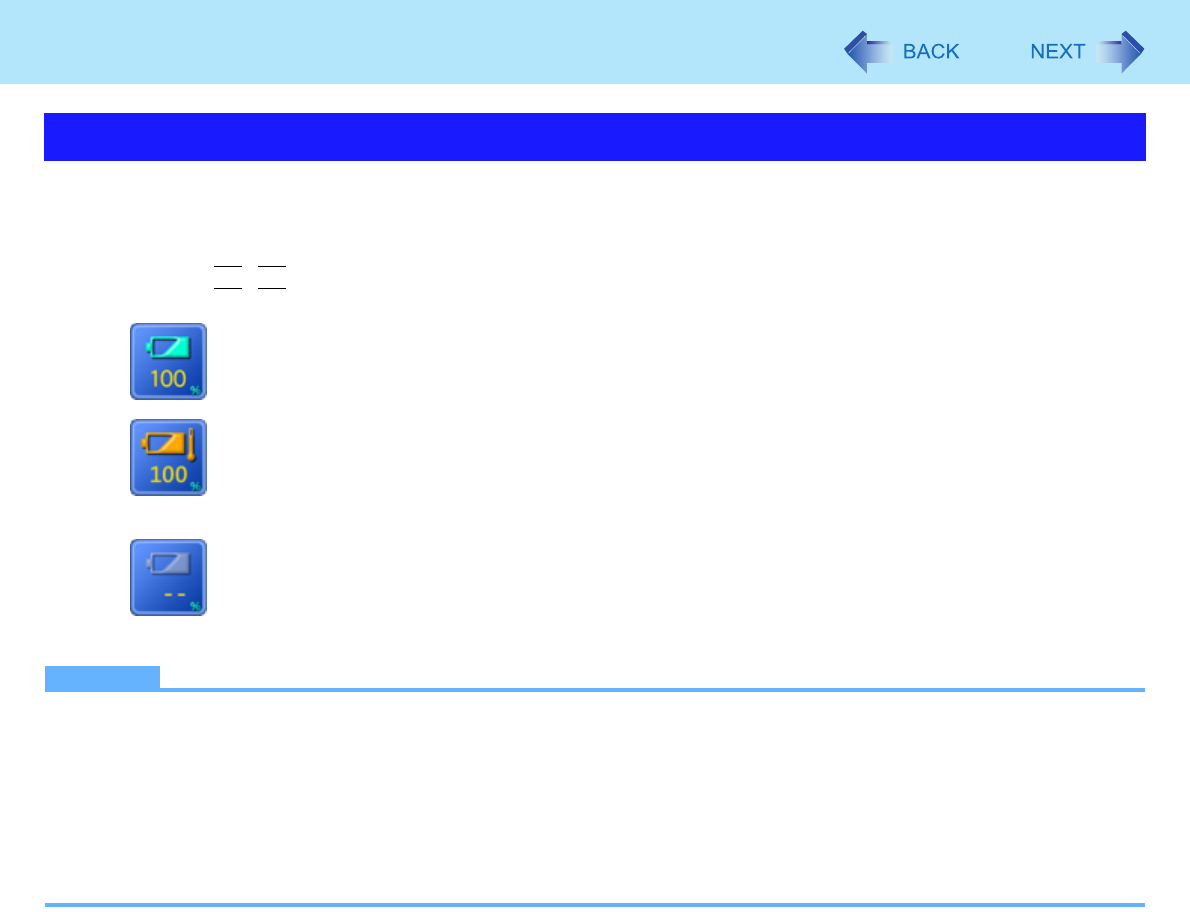
13
Battery Power
You can check the remaining battery charge on the screen.
(After logging on to Windows)
1Press
Fn
+
F9
.
zWhen the battery pack is inserted (example)
: Normal temperature mode (Îpage 14)
: High temperature mode (Îpage 14)
zWhen the battery pack is not inserted
NOTE
zThe battery display may not correspond to the actual remaining battery charge in the cases as below. To correct the
display, perform the Battery Recalibration (Îpage 16).
• The battery indicator remains red.
• The indicator lights orange and the display shows 99% for a long time.
• Low battery warning appears soon after a short time of use.
This can occur when the computer is in standby mode for a long time without power supply from the AC adaptor.
zThe battery display may not be the same as that of notification area or of [Power Meter] in [Power Options Properties].
This is not a malfunction.
Checking the Remaining Battery Charge

14
Battery Power
High temperature mode
The high temperature mode can prevent the battery from deteriorating when the computer is used in high-temperature envi-
ronment or used for a long time with its battery fully charged.
Select [Auto] (default) or [High Temperature] in [Environment] of the [Main] menu of the Setup Utility (Îpage 66).
NOTE
zNote that a level corresponding to a 100% charge for high temperature mode is approximately equivalent to an 80%
charge level for normal temperature mode.
zAfter switching from [Normal Temperature] to [High Temperature] or vice versa, the remaining battery capacity will not
be displayed correctly until the battery pack is completely discharged or fully charged.
zIn the [Auto] mode:
Once the computer has automatically switched from the normal temperature mode to the high temperature mode, the
computer will not switch back to the normal temperature mode until the battery has been used and recharged to a total
charge level of about five times as much as that of the fully-charged state. This is to avoid battery deterioration.
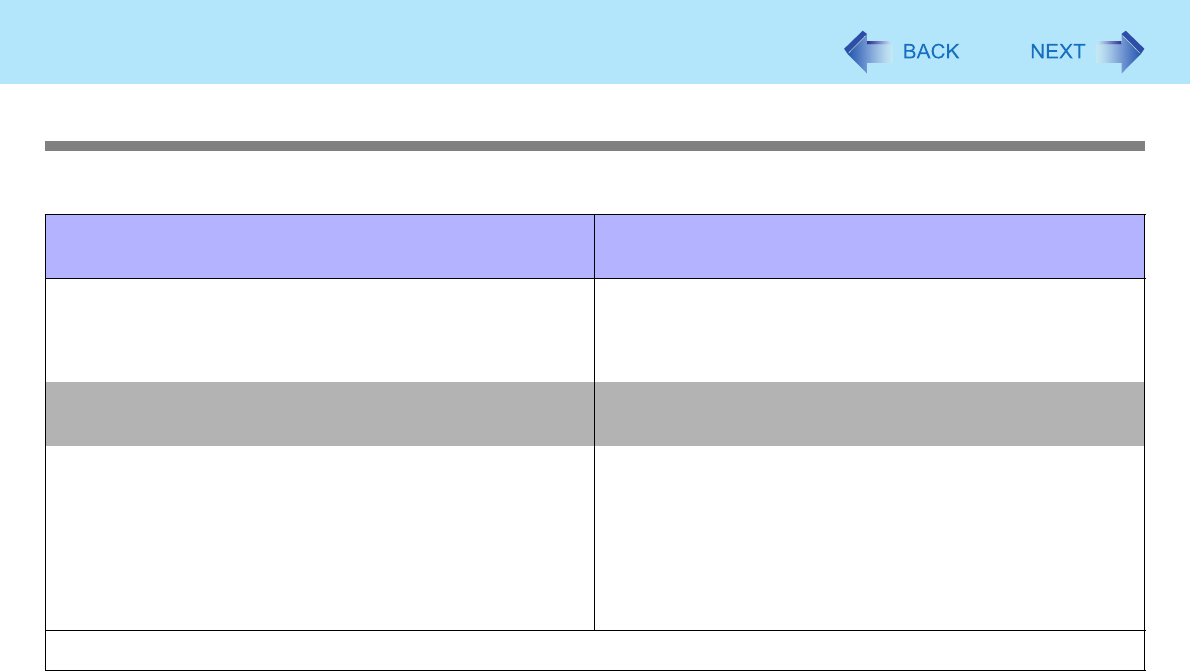
15
Battery Power
Computer behavior with low battery
The default settings are as follows.
When the battery level becomes 10%
[Low battery alarm]
When the battery level becomes 5%
[Critical battery alarm]
zDisplays a message that the battery level is low. zDisplays a message that the battery level is low, and
then the computer enters hibernation.
↓↓
Charge the battery. Connect the AC adaptor or replace the battery to start up
the computer.
zConnect the AC adaptor immediately. If you do not
have the AC adaptor, exit the running programs and
Windows, then confirm that the power indicator is off.
zIf you have a fully charged spare battery, turn off the
computer, replace the battery and turn the computer on
again.
zConnect the AC adaptor and charge the battery.
zIf you have a fully charged spare battery, replace the
battery and turn the computer on again.
When the computer enters hibernation with the battery
down and you resume the operation without charging
the battery, Windows may not start up normally or the
alarm function may not operate normally from then on.
Do not replace the battery pack when the computer is in standby mode.
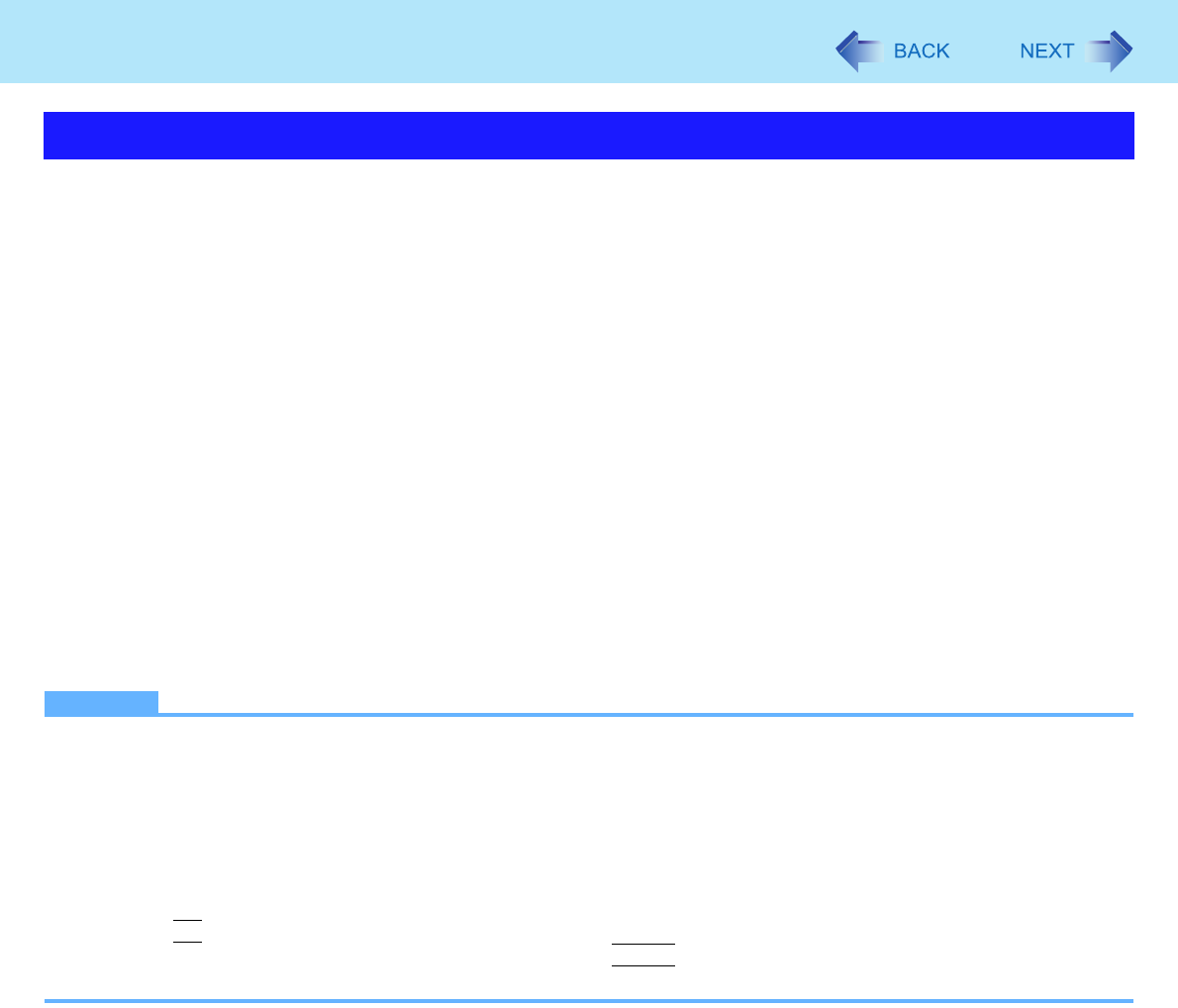
16
Battery Power
The “Battery Recalibration” function measures and memorizes the battery capacity. To correct the battery display, use this
function to fill the battery and then discharge it completely. Perform the procedure at least once immediately after purchasing
the computer. Normally the interval of battery recalibration is three months. The battery display may not be correct when the
battery pack deteriorates after a long time use. In this case, perform the procedure again.
1Connect the AC adaptor.
2Close all the applications.
3Perform “Battery Recalibration”.
AClick [start] - [All Programs] - [Panasonic] - [Battery Recalibration].
BWhen the confirmation message appears, click [Start].
zFrequent recalibration of the battery can degrade the battery. A caution message appears when the battery
recalibration is performed at the shorter interval than approximately a month. In this case, cancel the battery
recalibration.
CWhen the message requests shut down of Windows, click [Yes].
The battery recalibration starts.
After the battery pack is fully charged, discharging starts. When the discharging is completed, the power goes off
automatically.
After the battery recalibration is finished, normal charging starts.
NOTE
zThe temperature range should be 10°C to 30°C {50°F to 86°F}.
zThe battery recalibration may take a long time due to the large battery capacity. This is not a malfunction.
• Full charge: Approximately 4.5 hours
• Complete discharge: Approximately 5 hours
zIf the computer is turned off during the battery recalibration (e.g., due to power failure, or accidental removal of the AC
adaptor and battery pack), the battery recalibration will not be completed.
zYou can also perform the battery recalibration with the following procedure.
ARestart the computer.
BPress
F9
while the [Panasonic] boot screen is displayed just after the computer starts the startup procedure.
CWhen the remaining battery capacity is displayed, press
Enter
.
DFollow the on-screen instructions.
Correcting the Battery Display (Battery Recalibration)
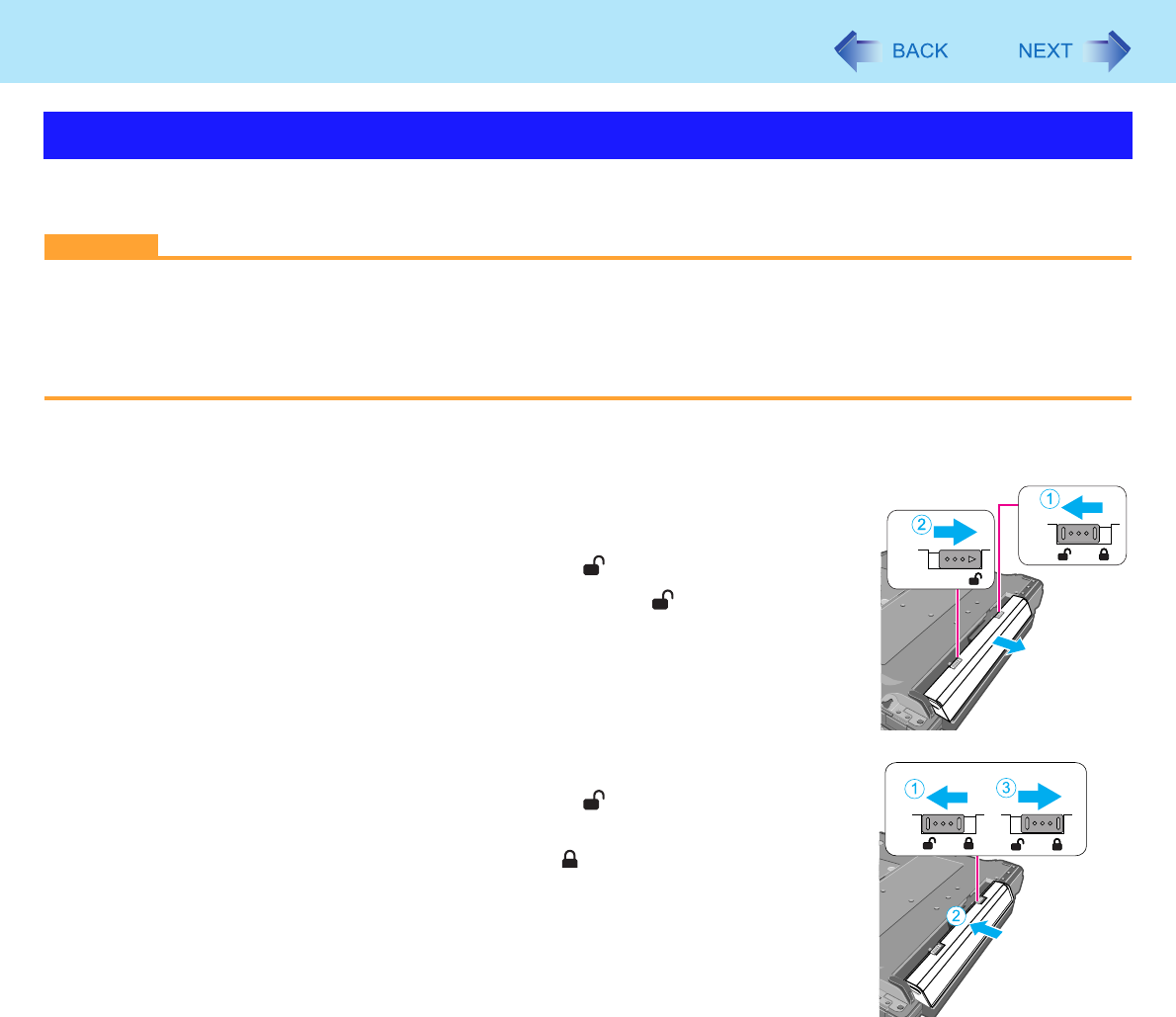
17
Battery Power
The battery pack (CF-VZSU43AU) is a consumable item so the replacement will be necessary. If the battery operation time
becomes noticeably short and not recovered even after recalibrating the battery, replace with a new battery.
CAUTION
zThe battery pack is not charged when you first purchase it. Be sure to charge it before using for the first time. Charging
starts automatically when the AC adaptor is connected to the computer.
zUse only the specified battery pack with your computer.
zIn the standby mode, do not remove/replace the battery pack. Otherwise your data will be lost and the computer may
be damaged.
1Turn off the computer.
zDo not use the standby function.
2Remove/Insert the battery pack.
zTo remove
ASlide the right latch (A) to the unlocked position ( ).
BSlide and hold the left latch (B) to the unlocked position ( ), and hold the cen-
ter of the battery pack and push out in parallel with the bottom surface of the
computer.
zTo insert
ASlide the right latch (A) to the unlocked position ( ).
BInsert the battery pack in the correct direction until it securely fits the connector.
CSlide the right latch (A) to the locked position ( ).
Replacing the Battery Pack
A
B
A
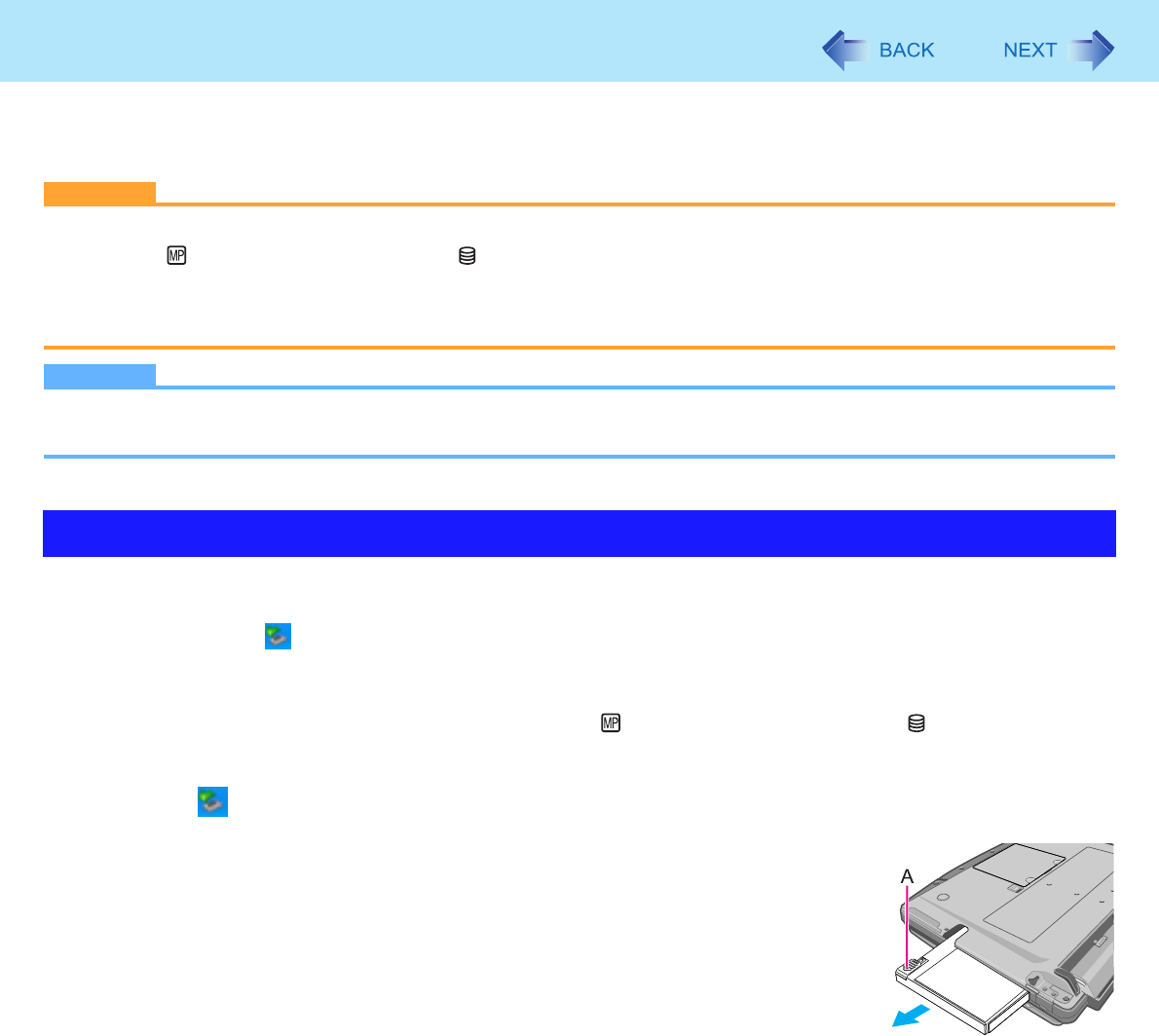
19
Multimedia Pocket
You can attach the following devices. (refer to recent catalogs and other sources for information about the products available)
zDVD-ROM & CD-R/RW drive
zDVD MULTI drive
CAUTION
zDo not insert/remove the multimedia pocket device in standby or hibernation, or when the multimedia pocket device
indicator or the hard disk drive indicator is on.
zDo not leave a disc formatted with B’s CLiP in the multimedia pocket device because the computer cannot enter
standby/hibernation even if you selected [Stand by] or [Hibernate] in [When I close the lid of my portable computer:]
(Îpage 6 “Setting Standby or Hibernation”).
NOTE
zRefer to the catalogs etc. for the latest information about optional devices.
zRead the instruction manuals of the devices carefully.
1Disable the multimedia pocket device function.
ADouble-click on the notification area.
BSelect the multimedia pocket device and then click [Stop].
CFollow the on-screen instructions.
DConfirm that the multimedia pocket device indicator and the hard disk drive indicator indicators are not lit.
zThis step is not necessary when;
• Removing the device after turning off the computer.
• is not displayed.
• The device does not appear in the list in step B.
2Press and hold the release button (A), and slide the device out
of the multimedia pocket.
Replacing the Multimedia Pocket Device
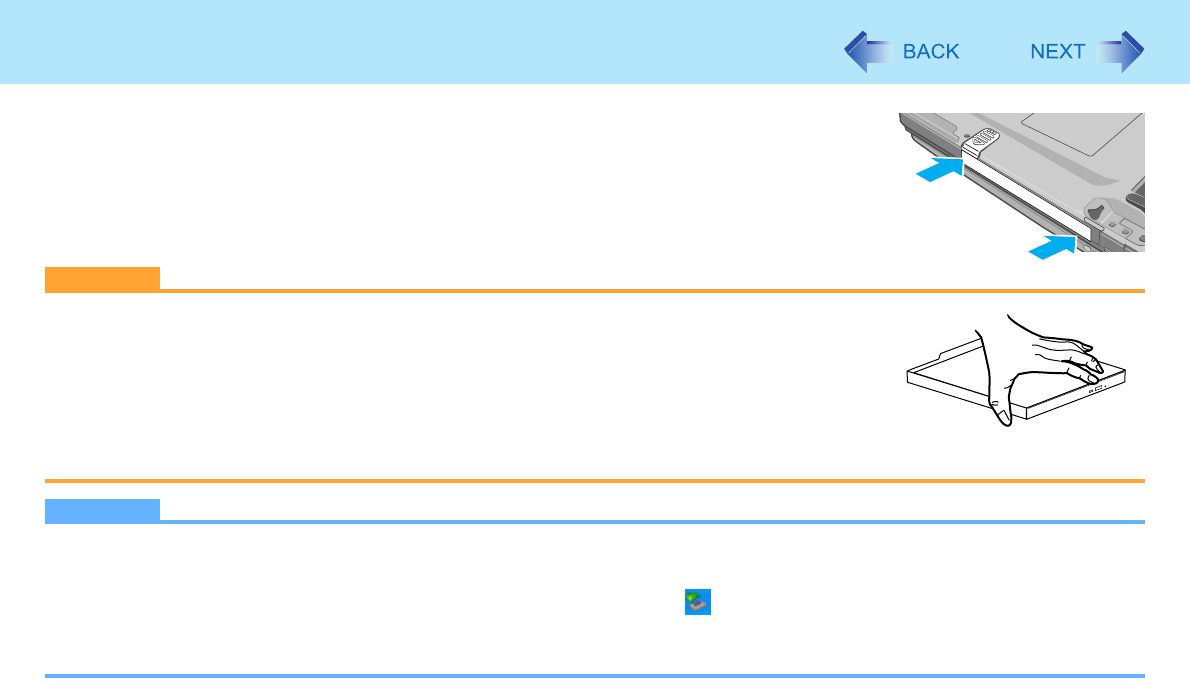
20
Multimedia Pocket
3Carefully insert the device into the multimedia pocket by push-
ing both corners until it surely fits in the slot.
zThe computer must be on when inserting the device.
zInsert the device with the label side up.
CAUTION
zHold the device on its both sides. Otherwise the device may be damaged.
zDo not apply excessive force when raising the slot side upward and inserting the
device.
NOTE
zThe procedure to disable the multimedia pocket device is not necessary when you remove the device after turning off
the computer.
zYou can see that the device is recognized or not by double-clicking on the notification area, or checking the [Infor-
mation] menu in the Setup Utility (Îpage 65). If the device is not recognized (or if the media cannot be accessed),
turn off the computer and reinsert the device.
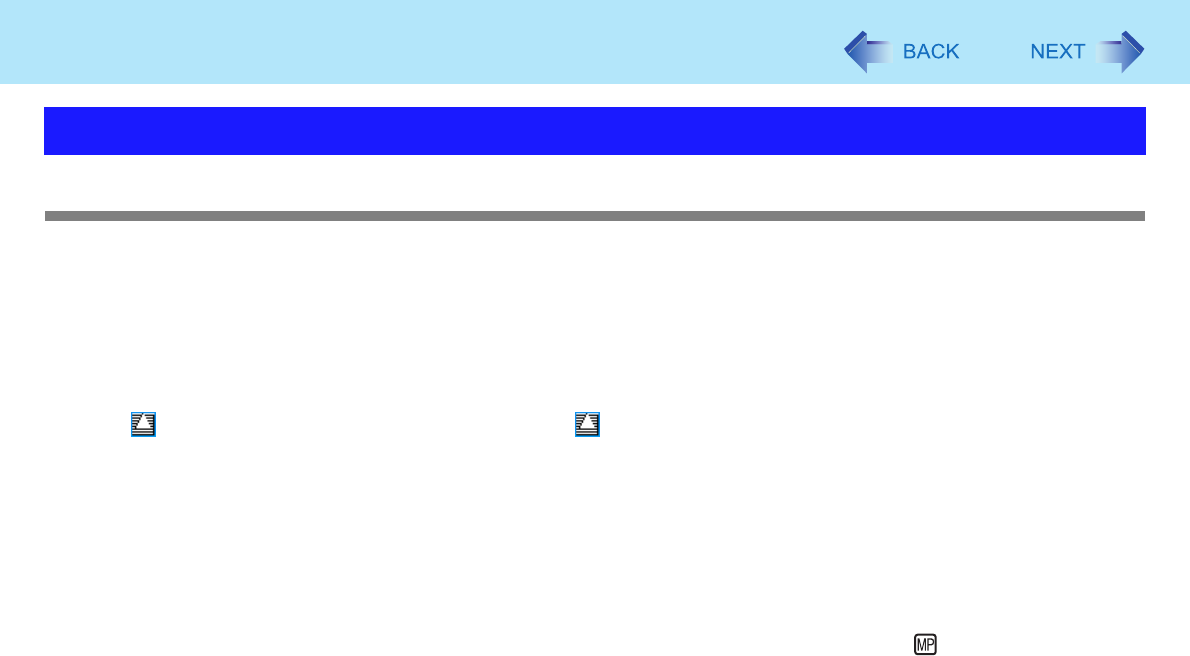
21
DVD Drive
DVD drive handling care
zDo not expose the DVD drive to excessive smoke that may leave a residue, e.g., oil smoke, or tobacco smoke. Doing so
can shorten the life of the drive lens.
zWe recommend cleaning the drive lens with an air puffer used for camera lenses.
(Do not use any spray-type of lens cleaning products.)
When opening/closing the tray
zWhen the computer is on, use the eject button (Îpage 26) or eject through Windows.
zWhen is displayed on the notification area, right-click and click [Eject] to eject a disc.
Eject discs only as described above.
zWhen inserting or removing a disc, be careful not to touch the lens of the drive.
zDo not leave the tray open and do not touch the lens.
The lens and disc can become dusty in some conditions. It may cause malfunction in reading or writing.
zDo not apply excessive force to the tray in the open position.
zNever insert a foreign object such as a paper clip into the DVD drive.
Doing so may cause malfunction.
zDo not place items other than discs on the tray.
zDo not access the drive until after the tray is closed and the multimedia pocket device indicator is off.
While the DVD drive is being accessed
zDo not open the DVD drive or move the computer while the DVD drive is being accessed.
Doing so could cause the disc to shift position and this may damage the disc, or cause the DVD drive to malfunction.
In addition, after running an application involving access to a disc, close the application before opening the DVD drive.
Handling Precautions
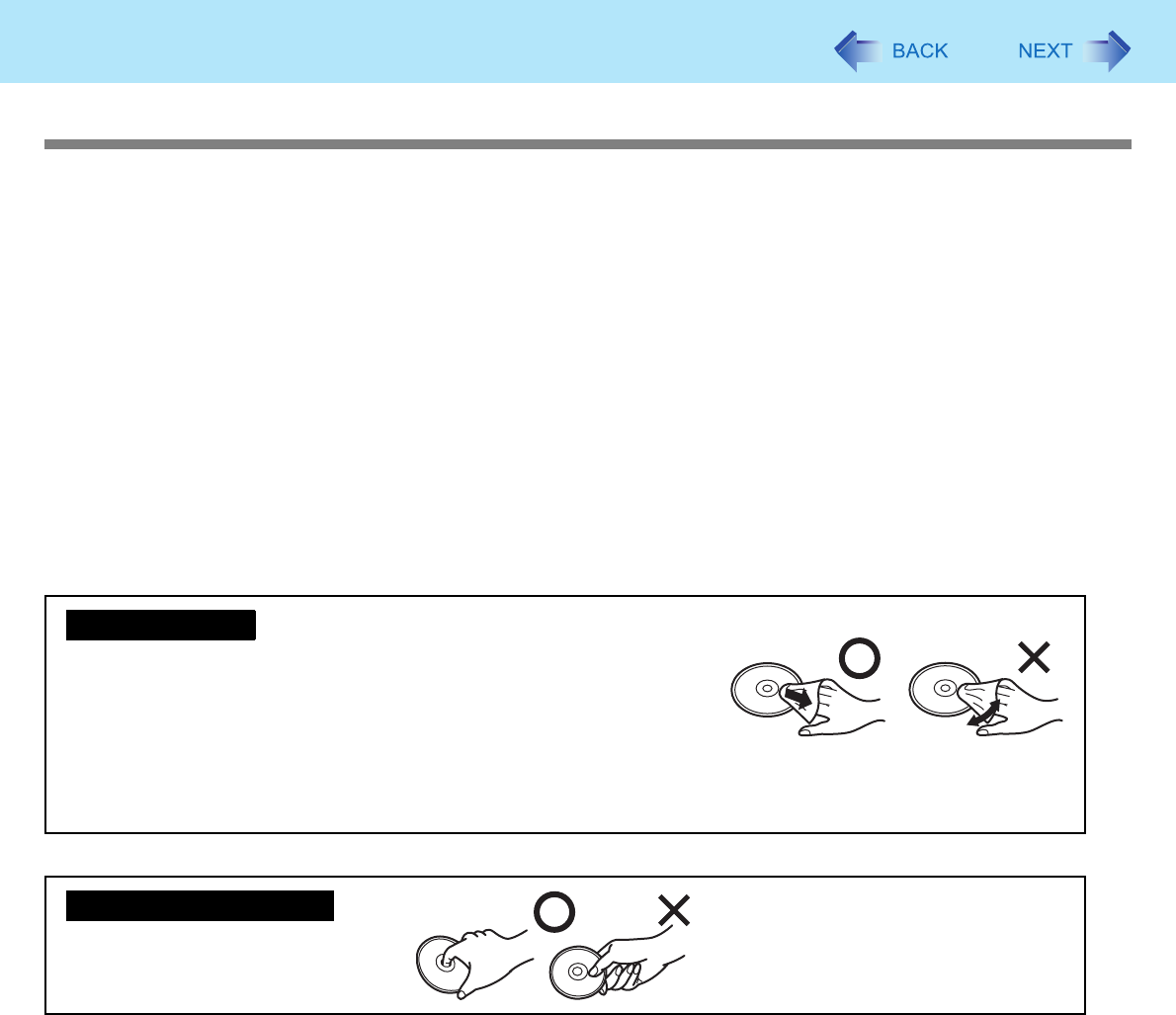
22
DVD Drive
Disc handling care
zDo not use deformed, warped, or irregularly shaped discs.
Reading of disc may not be possible depending on the disc conditions (cracks, dirt, modification, data recording quality,
copy protection, recording equipment/software that was used to create the disc, etc.)
zBefore using a disc, carefully read the operating/handling instructions and package of the disc.
zIf the discs are not handled appropriately, they may become dirty or scratched. Furthermore the writing speed may get
slower and the data may not be correctly written on or read from the disc. Other damage may cause a drive failure.
zNote the following precautions.
• Do not touch the disc surface (the side with no printing).
• Keep the disc surface clean and free from dirt, dust, fingerprints and scratches.
• Do not write on the surface of the disc with a ballpoint pen or other writing instrument.
• Do not attach stickers to discs.
• Do not drop, bend, or place heavy objects on top of discs.
• Do not place or store discs in locations exposed to heat, direct sunlight, humidity or dust.
• If a disc is brought from a cold to a warm location, condensation may form on the disc. For read-only discs, wipe off the
condensation using a soft, dry, lint-free cloth before using the disc. For recordable/rewritable discs, wait until the conden-
sation dries.
• When not using discs, keep them in their protective cases or cartridges.
<For read-only discs>
Wipe discs with a dry, soft cloth from the center toward the edge.
If discs get very dirty, wipe with a moist, soft cloth from the center toward
the edge, then wipe again with a dry cloth to take up remaining moisture.
<For recordable/rewritable discs>
Use the Panasonic disc cleaner to clean these discs.
Do not use a cloth, CD cleaners or any other such cleaners under any circumstances.
To clean discs
How to hold a disc
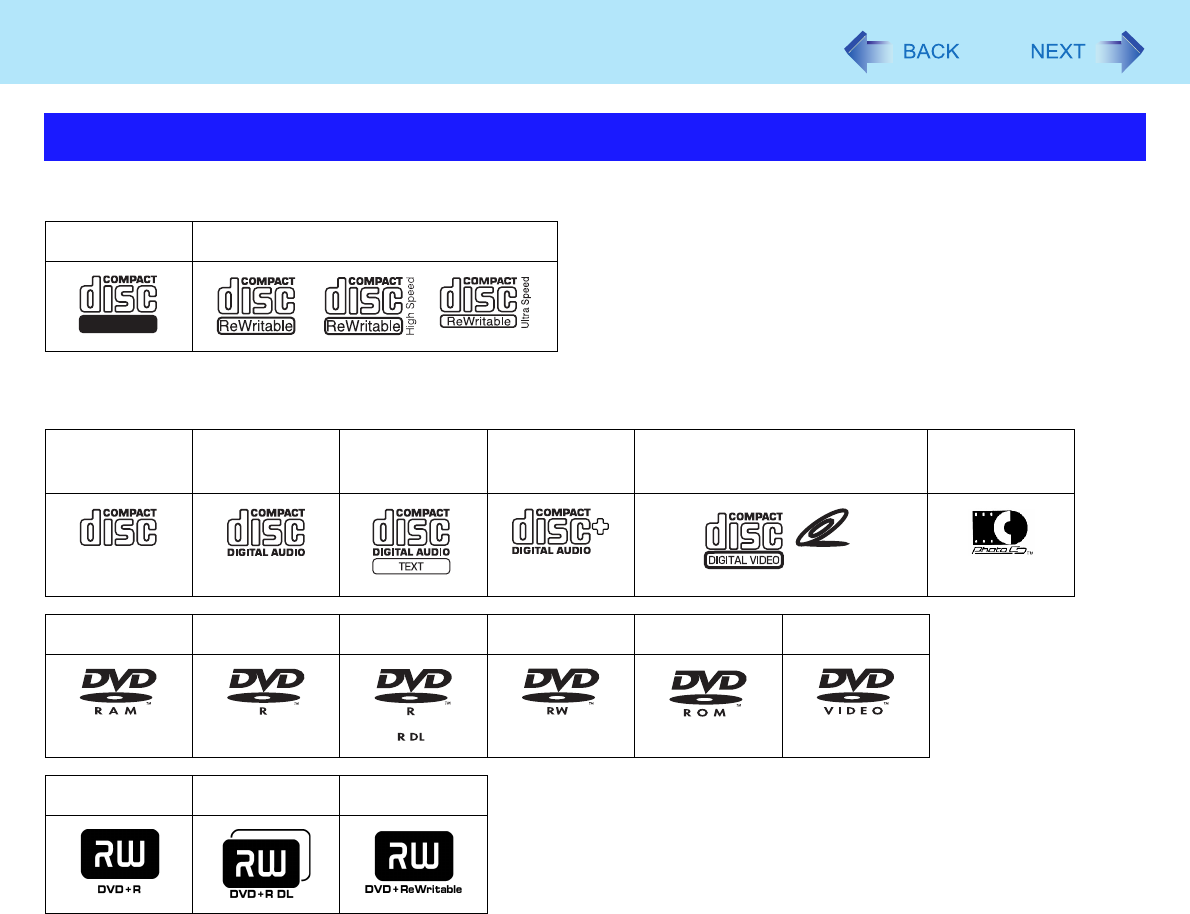
23
DVD Drive
zYou can read from/write to the following discs.
zYou can read from the following discs.
*1 You can write to the disc using a DVD MULTI drive.
*2 DVD-RAM: Only non-cartridge type or removable cartridge type can be used.
*3 Does not support DVD-RW Ver.1.0.
Disc Information
CD-R CD-RW
CD-ROM CD DIGITAL
AUDIO
CD TEXT CD-EXTRA Video CD Photo CD
DVD-RAM*1*2 DVD-R*1 DVD-R DL DVD-RW*1*3 DVD-ROM DVD-Video
+R*1 +R DL*1 +RW*1
Recordable
VIDEO CD

24
DVD Drive
Recommended discs for writing
DVD discs you can use for writing
*4 Use the 2.4X-SPEED discs for writing.
The drive is not compatible with writing to the 8X-SPEED discs (including the 2.4-8X-SPEED discs).
• CD-R
HITACHI MAXELL, Ltd.
MITSUBISHI KAGAKU MEDIA CO., Ltd.
TAIYO YUDEN Co., Ltd.
• CD-RW/High-Speed CD-RW
MITSUBISHI KAGAKU MEDIA CO., Ltd.
RICOH Co., Ltd.
• Ultra-Speed CD-RW
MITSUBISHI KAGAKU MEDIA CO., Ltd.
<Only for model with a DVD MULTI drive>
•DVD-R
Matsushita Electric Industrial Co., Ltd.
MITSUBISHI KAGAKU MEDIA CO., Ltd.
TAIYO YUDEN Co., Ltd.
•DVD-RW
MITSUBISHI KAGAKU MEDIA CO., Ltd.
Victor Company of Japan, Limited
• DVD-RAM
Matsushita Electric Industrial Co., Ltd.
HITACHI MAXELL, Ltd.
•+R / +RW
MITSUBISHI KAGAKU MEDIA CO., Ltd.
RICOH Co., Ltd.
• +R DL
MITSUBISHI KAGAKU MEDIA CO., Ltd.
<Only for model with a DVD MULTI drive>
• DVD-R for General
1X-SPEED (4.7 GB)
1–2X-SPEED (4.7 GB)
1–4X-SPEED (4.7 GB)
1–8X-SPEED (4.7 GB)
1–16X-SPEED (4.7 GB)
•DVD-RW
1X-SPEED (4.7 GB/9.4 GB)
1–2X-SPEED (4.7 GB/9.4 GB)
2–4X-SPEED (4.7 GB/9.4 GB)
2–6X-SPEED (4.7 GB/9.4 GB)
• DVD-RAM
2X-SPEED (4.7 GB/9.4 GB)
2–3X-SPEED (4.7 GB/9.4 GB)
2–5X-SPEED (4.7 GB/9.4 GB)
•+R
1–2.4X-SPEED (4.7 GB)
1–4X-SPEED (4.7 GB)
1–8X-SPEED (4.7 GB)
1–16X-SPEED (4.7 GB)
• +R DL
2.4X-SPEED (8.5 GB)*4
•+RW
1–2.4X-SPEED (4.7 GB)
1–4X-SPEED (4.7 GB)

25
DVD Drive
Using DVD Media
To play DVD-Video or MPEG2 files, you need to use DVD playback software such as WinDVD (Îpage 28).
Region code setting
DVD-Video are allocated to region codes according to where they are sold. To play a DVD-Video, the player’s software and
the drive must have the corresponding region code.
e.g.,
For U.S.A. and Canada: “1”
For Europe: “2”
zThe region code of the drive is not set at purchase. The operation depends on the DVD-Video that is first played.
•DVD-Video with a specific region code:
The drive will automatically be set at the same region code as the DVD-Video.
•DVD-Video with multiple region codes:
[Confirm Region] appears. Select the region code and click [OK]. Play now begins.
CAUTION
zYou can change the region code setting up to five times including the initial setting. Be extremely careful because you
cannot change the region code anymore after the fifth change, even if you reinstalled the operating system.
zAny problem resulting from illegal changing or altering of the region code is the user’s responsibility.
NOTE
z[Confirm Region] appears when the DVD-Video has only one region code and the drive is set for another region code.
([Confirm Region] may not appear with some DVD-Video discs. To check the current region code and the number of
remaining times of changing the code, right-click on the WinDVD screen and click [Setup] - [Region].)
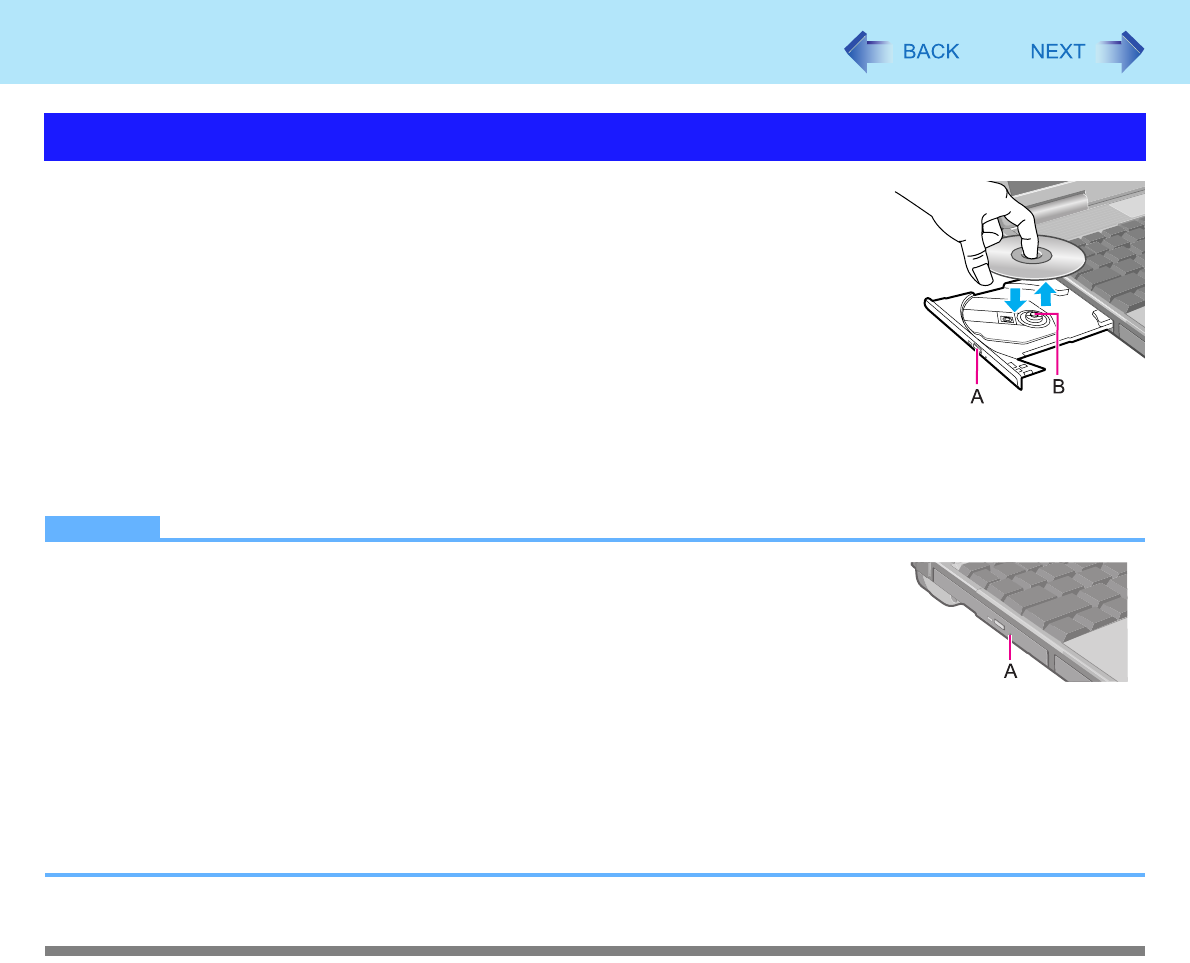
26
DVD Drive
1Turn on the computer.
2Press the eject button (A) and slowly pull out the tray.
3Insert/Remove the disc.
zTo insert
Set the disc with the label side up and press the center of the disc until it clicks
in place.
zTo remove
Press on the center spindle (B) and carefully lift up the edge of the disc.
4Close the tray.
Do not press the eject button.
NOTE
zTo remove a disc when the computer is powered off, insert a pointed object (e.g., the
bent-out tip of a paper clip, or the tip of a pencil or ballpoint pen) into the emergency
hole (A). Pushing it to the end allows the tray to come out. (The position of the emer-
gency hole depends on the drive.)
zIf the vibration of the DVD drive is excessive, check the disc. If the disc is normal and
is inserted correctly, set [DVD Drive Speed] to [Low] in the [Main] menu of the Setup
Utility (Îpage 66).
When using B’s Recorder, select writing speed [8x] or less to minimize vibration.
zFor AutoPlay CD:
• If an AutoPlay CD does not start after the computer resumes from standby or hibernation, remove the disc from the
drive and then reinsert it after waiting 15 seconds.
• An AutoPlay CD may start during file access depending on the status of the disc.
zWhen playing back video from a disc, playback may not be smooth in some conditions.
Power-saving mode
If the DVD drive is not accessed for 30 seconds, the drive motor will automatically be shut down to reduce the power con-
sumption. When the DVD drive is accessed again, the drive motor is turned on. In this case, reading of the disc data will take
approximately 30 seconds.
Setting a Disc

27
DVD Drive
<Only for model with a DVD-ROM & CD-R/RW drive>
zConnect the AC adaptor if writing operation takes a long time. If the battery level becomes low and the power is not sup-
plied, writing operation may not be completed.
zYou need to use writing software to write to discs. (“B’s Recorder” and “B’s CLiP” Îpage 30)
Ensure the disc is compatible with the selected writing speed.
zThe quality of written data depends on the disc.
<Only for model with a DVD MULTI drive>
zIf a DVD MULTI drive has already been set at the time of initial startup of the computer, you do not need to install the DVD-
RAM Driver. You can write to a DVD-RAM disc without installation. If you purchase a DVD MULTI drive after the initial star-
tup of the computer, install the DVD-RAM Driver according to the operating instructions supplied with the drive.
DVD-ROM & CD-R/RW Drive
DVD MULTI Drive
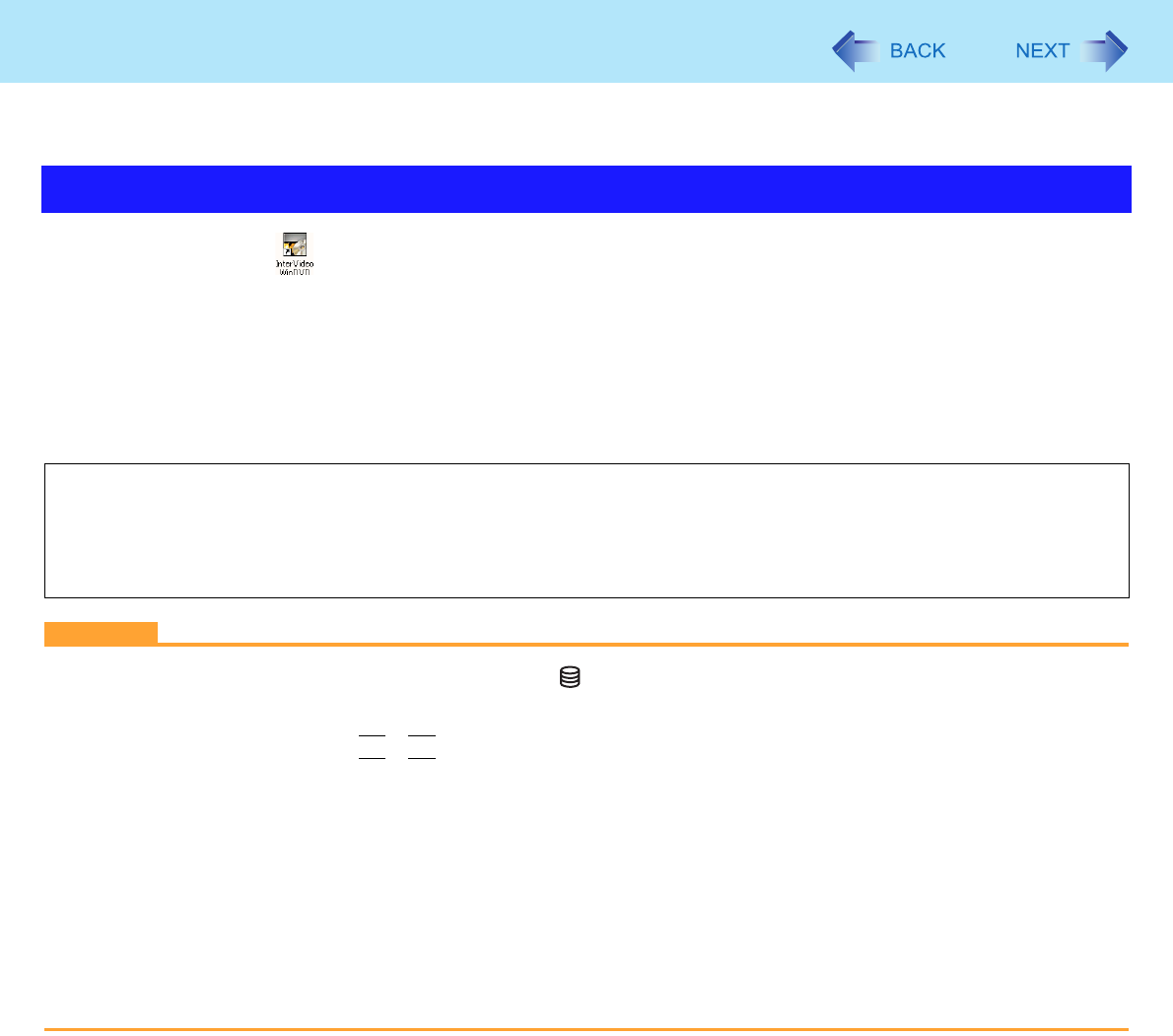
28
WinDVD
WinDVD is a software application for DVD playback. For further information, refer to the software’s online manual.
zDVD-Audio cannot be played back using WinDVD.
1Double-click on the desktop.
zAlternatively click [start] - [All Programs] - [InterVideo WinDVD] - [InterVideo WinDVD].
To access the online manual
After starting WinDVD, perform either of the following procedures.
zClick “?” on the WinDVD control panel.
zRight-click on the WinDVD screen and click [Help].
CAUTION
zDo not start WinDVD while the hard disk drive indicator is blinking immediately after the computer is turned on.
zWhile WinDVD is running, do not:
• Enter standby or hibernation.
• Switch the display by pressing
Fn
+
F3
.
zDuring video playback, do not:
• Eject the disc.
• Use other applications or the Command Prompt.
• Change the settings of the screen properties.
zDo not install another player software together with WinDVD.
Doing so may interfere with smooth playback. Some DVD-Video discs contain the player software and start installing. In
this case, cancel the installation as soon as possible. If you accidentally installed another player software and find a prob-
lem in playback, try either of the following procedures.
• Uninstall the player software by clicking [start] - [Control Panel] - [Add or Remove Programs].
(Refer to the instruction manual for the name of player software.)
• Set WinDVD as the playback software if you can select the option in the player software settings.
Running WinDVD
SUPPORT INFORMATION
If WinDVD does not operate properly, we recommend carefully reading the online help file first for problems with the oper-
ating environment or operations.
If you still cannot troubleshoot the problem, enter the required information in the inquiry form on the InterVideo, Inc. home-
page (http://www.intervideo.com/), and submit the form.

29
WinDVD
zPlayback may not be possible depending on the DVD recorder or the discs.
zYou must finalize*1 DVD-R, DVD-R DL, DVD-RW, +R, +R DL, and +RW before playback. For further information, refer to
the instruction manual of the DVD recorder.
zYou cannot play discs protected with copyright management technologies such as CPPM (Content Protection for Prere-
corded Media) and CPRM (Content Protection for Recordable Media).
*1 A process that enables the playback of the discs on other DVD players, etc.
DVD Discs Created Using a DVD Recorder
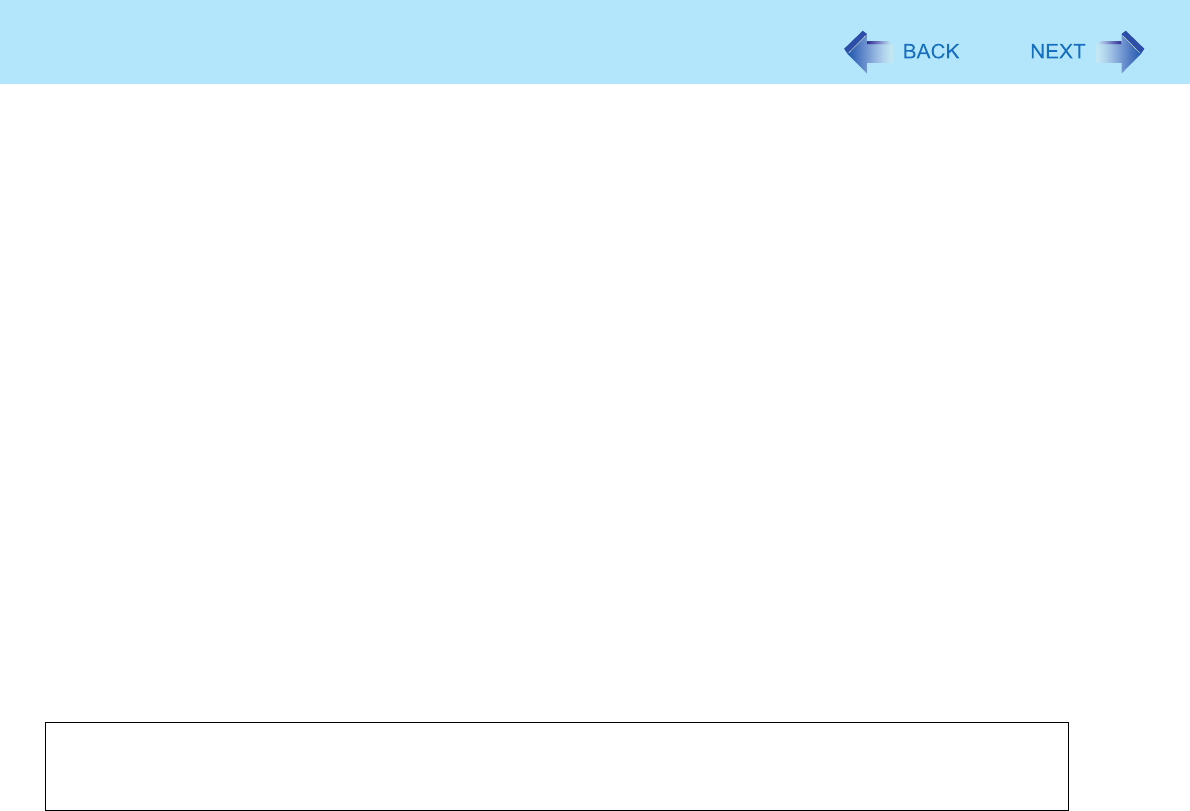
30
B’s Recorder/B’s CLiP
“B’s Recorder” and “B’s CLiP” are CD/DVD recording software applications developed by B.H.A Corporation.
zB’s Recorder:
Enables you to create data/music/video CDs and to copy CDs.
zB’s CLiP:
Enables you to copy or erase files and folders.
For further information, refer to the software’s online manual (Îpage 32).
Applicable Media
zCD-R*1
zCD-RW
(Only for model with a DVD MULTI drive)
zDVD-RAM*1*2
zDVD-R*1
zDVD-RW*3
z+R*1
z+R DL*1
z+RW
*1 You can use on B’s Recorder only, and cannot read from or write to the disc using B’s CLiP.
*2 If you write to DVD-RAM using B’s Recorder, the DVD-RAM will become “read only” disc.
To write to such a DVD-RAM disc using an application other than B’s Recorder, physical formatting is required.
*3 You cannot read from or write to DVD-RW created using DVD recorders.
About Copies
When you write to discs or back up software, ensure that you do not infringe upon any copyrights.
It is illegal to copy audio CDs for non-personal use.
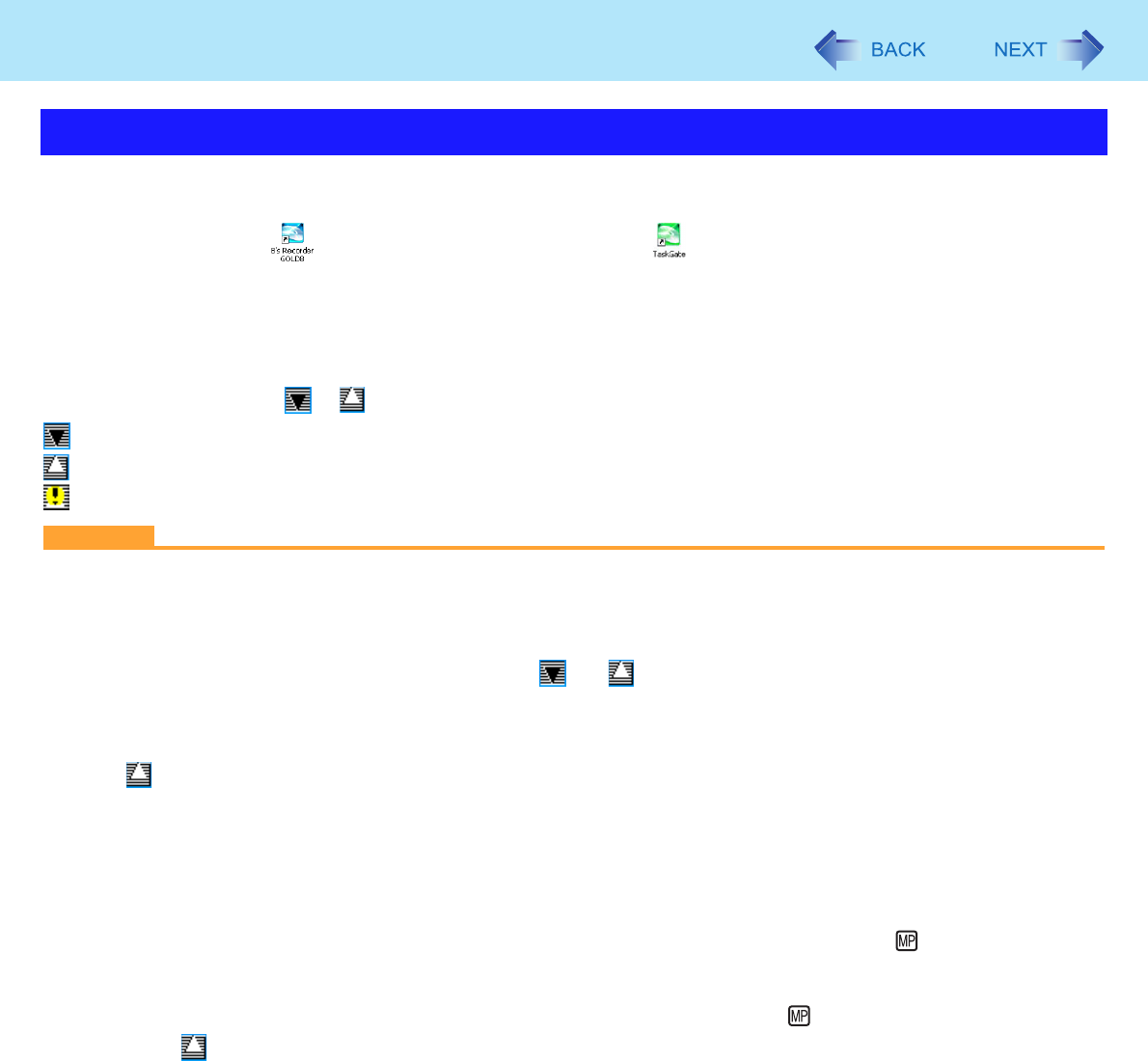
31
B’s Recorder/B’s CLiP
B’s Recorder
1Double-click (B’s Recorder main window) / (launcher window) on the desktop.
zAlternatively you can click [start] - [All Programs] - [B.H.A] - [B’s Recorder GOLD8 BASIC] - [B’s Recorder
GOLD8] (B’s Recorder main window) / [TaskGate] (launcher window).
B’s CLiP
You can use B’s CLiP when or is displayed on the notification area.
: No disc is inserted or the inserted disc is not formatted using B’s CLiP.
: The inserted disc has been formatted using B’s CLiP.
: The drive is not connected.
CAUTION
B’s Recorder
zBe sure to shut down B’s Recorder before you log off Windows.
Otherwise B’s Recorder may not start normally when you log on to Windows next time. In this case, restart the computer.
B’s CLiP
zB’s CLiP is not compatible with fast user switching (the and icons disappear from the notification area). If you want
to continue using B’s CLiP after switching users, log off all users, and then relog on to Windows.
zDo not remove the media immediately after reading or writing, or just after the Windows reading/writing message disap-
pears.
zWhen is displayed on the notification area, the computer will not enter standby automatically.
zDo not add the check mark for [Enable CD recording on this drive] in [Properties] - [Recording] of the DVD drive, otherwise
you cannot write to the disc using B’s CLiP.
<Only for model with a DVD MULTI drive>
zYou can format DVD-RW discs in UDF1.5/UDF2.0/UDF2.01 format on this computer. However, you cannot use the discs
on DVD recorders.
zFormatting +RW discs on B’s CLiP may seem to finish in a very short time. However the “background formatting” is per-
formed to format the non-formatted segments. Therefore, the multimedia pocket device indicator is on.
Note the following during background formatting.
• You can read from or write to a disc.
• You can remove the disc even while the multimedia pocket device status indicator is on.
Right-click on the notification area and click [Eject] to remove the disc.
Running B’s Recorder/B’s CLiP

32
B’s Recorder/B’s CLiP
• If the disc is removed before completely formatted, the background formatting will restart when the disc is returned to the
drive. Background formatting will continue until the formatting is complete.
• To carry the computer, right-click on the notification area and click [Eject] to remove the disc.
To access the online manual
B’s Recorder
AClick [start] - [All Programs] - [B.H.A] - [B’s Recorder GOLD8 BASIC] - [DOC] - [User Manual] (user’s manual)
/ [TaskGate] (TaskGate manual).
B’s CLiP
AClick [start] - [All Programs] - [B.H.A] - [B’s CLiP] - [User’s Manual].
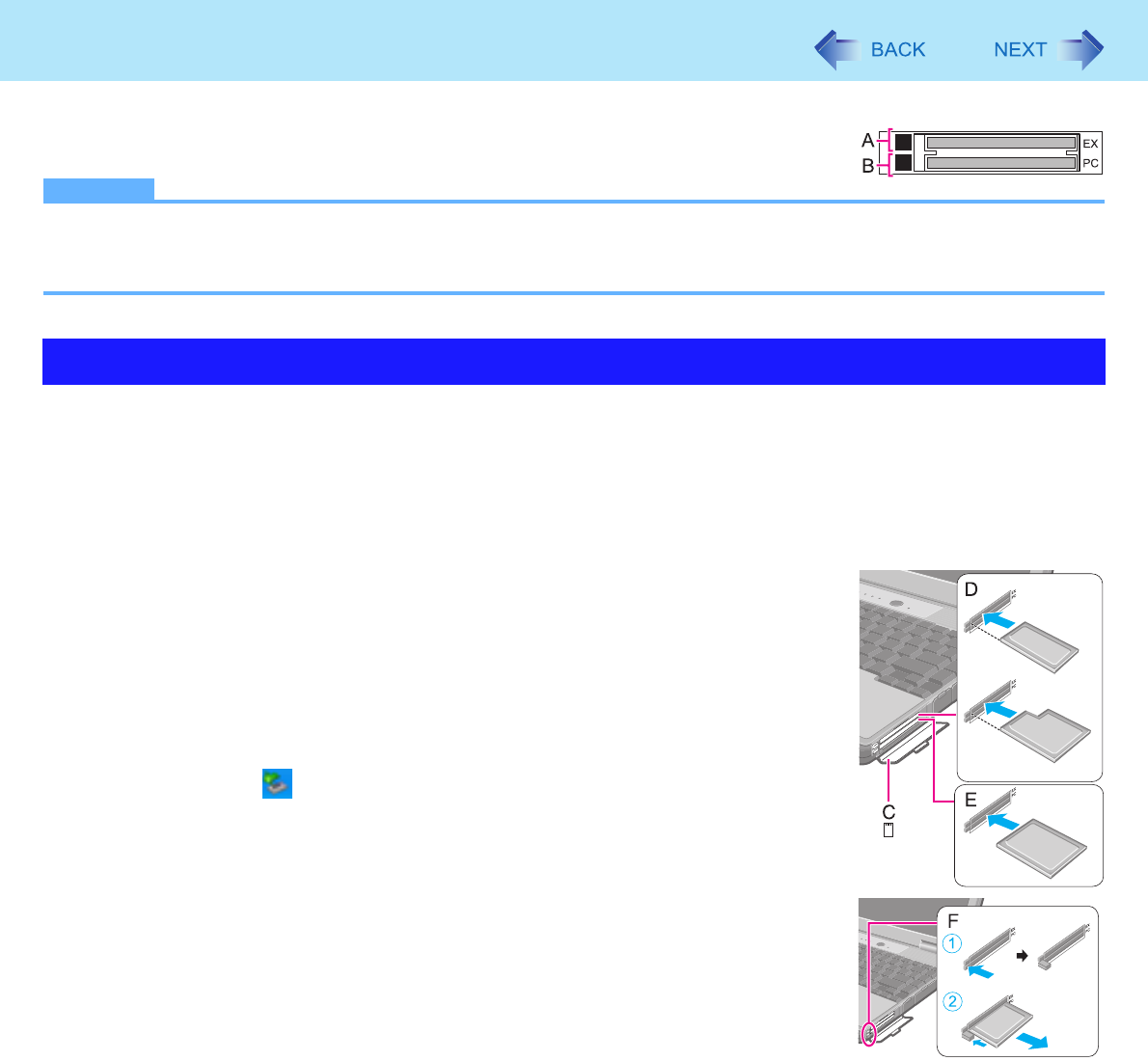
33
PC Card / ExpressCard
You can insert the following cards.
zExpressCard/34 or ExpressCard/54 to the ExpressCard slot (A)
zPC Card Type I (3.3 mm) or II (5.0 mm) to the PC Card slot (B)
NOTE
zThe following types of card are not supported:
PC Card Type III (10.5 mm), ZV card, SRAM card, FLASH ROM card (excluding ATA interface type), and other cards
that require 12V of operating voltage.
Preparation
Before connecting a card, first determine the media that contains the card driver (e.g., CD-ROM), then attach the
device for that media to the multimedia pocket. Once the installation screen for the card’s driver appears, equipment
you then connect to the multimedia pocket will not be recognized.
To insert the card
1Open the cover (C), and insert the ExpressCard (D) or the PC
Card (E) with the label side up until it securely fits in to the slot.
zFor further information, refer to the instruction manual of the card.
To remove the card
1Disable the card function.
ADouble-click on the notification area and select the card, then click [Stop].
BFollow the on-screen instructions.
zThis step is not necessary when removing the card after turning off the com-
puter.
2Open the cover and remove the card.
APress the eject button (F). The eject button pops out.
BPress the eject button (F) again so the card comes out of the slot.
CDraw the card straight out.
Inserting/Removing the Card

34
PC Card / ExpressCard
NOTE
zCheck the card’s specification to prevent the total operating current from exceeding the allowable limit. Otherwise mal-
function may occur.
Allowable Current: 3.3 V: 400 mA, 5 V: 400 mA
zSome types of cards cannot be used simultaneously.
zAfter repeating insertion and removal, some types of card will not be recognized. In this case, restart the computer.
zIf the computer freezes after resuming from standby or hibernation, remove and reinsert the card. If the problem per-
sists, restart the computer.
zWhen a card is inserted, power consumption increases. Remove the card when it is not in use, especially when oper-
ating by battery power.
zTo connect peripheral devices (SCSI, IEEE1394, etc.) using a PC Card or an ExpressCard, follow the steps below
(one example).
AConnect the peripheral device to the card.
BTurn on the power of device.
CInsert the card until it surely fits in the slot.
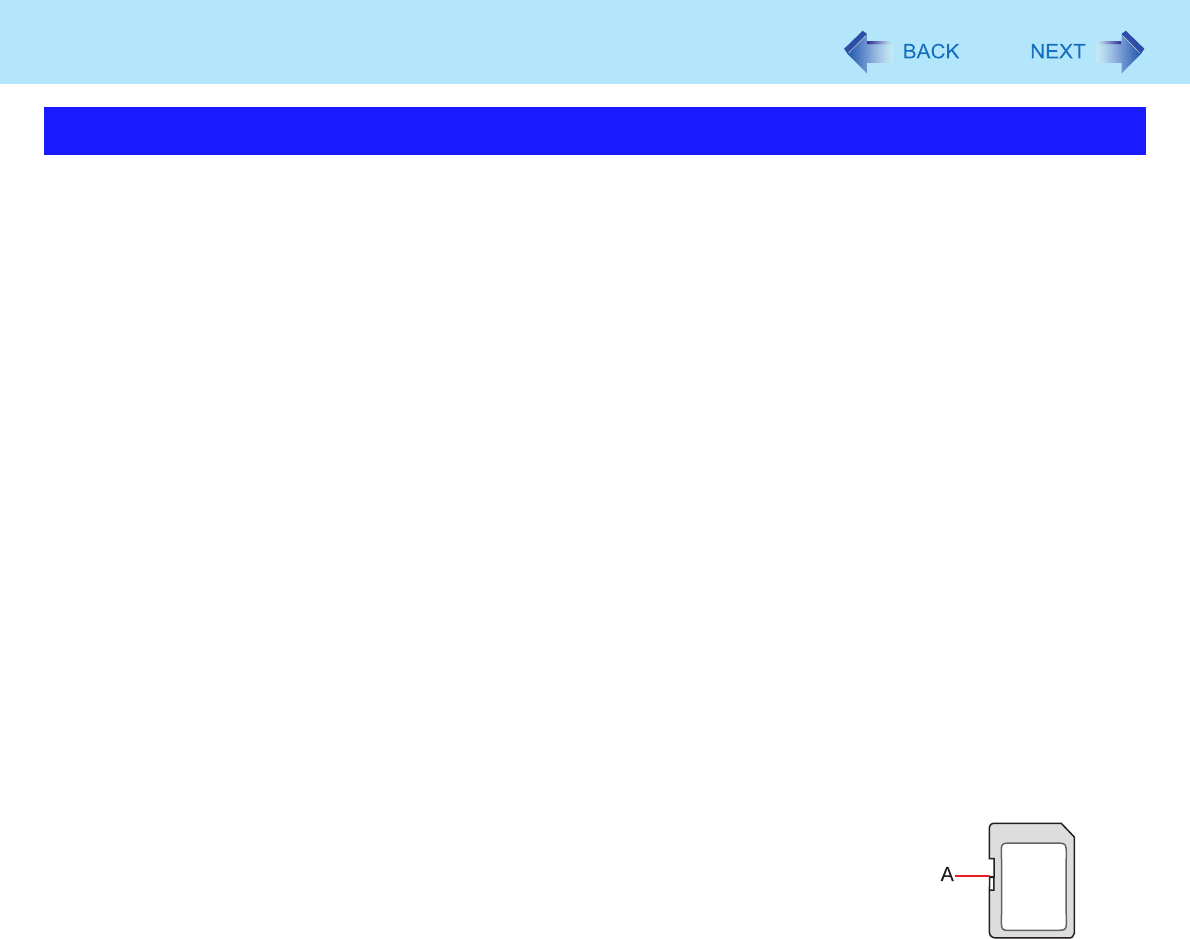
35
SD Memory Card
The SD Memory Card slot on this computer only accepts SD Memory Cards.
zThis computer does not support SDHC Memory Card (SD Memory Card with the capacity of 4 GB or more).
zWhen you use a miniSD Card or a microSD Card, set the card to a miniSD Card adaptor or a microSD Card adaptor, and
insert/remove the card with the adaptor. Be sure not to leave the adaptor in the card slot.
zThe SD Memory Card has a copyright protection function which is compatible with content on-demand services on the
Internet, etc.
zTo format the SD Memory Card on this computer, do not use [Format] of Windows, but use the SD Memory Card format
software.
You can download the software from the web site below.
http://panasonic.jp/support/global/cs/sd/download/sd_formatter.html
zTo use the SD Memory Card on other devices, format the card on the devices. For further information, refer to the instruc-
tion manual of the devices.
Handling and storage cautions
zStore the SD Memory Card in the case after removing it from the computer.
zDo not:
• Disassemble or modify the card.
• Hit, bend, or drop the card.
• Touch the terminals with fingers or metal object.
• Remove the labels of the card / Attach other labels or stickers to the card.
zDo not place the card in the following locations.
• In direct sunlight or in very hot location such as inside of a car.
• In very dusty or humid location.
• In location subject to corrosive gas, etc.
Data handling cautions
zSet the write-protect switch (A) to the LOCK position. Unlock the switch when recording
(checkout), saving, or editing data.
zWe recommend you to back up the important data to another storage medium.
zWhen disposing the card, we recommend you to physically destroy the card (using a ham-
mer, etc.) to prevent personal or confidential data leakage.
SD Memory Card Information
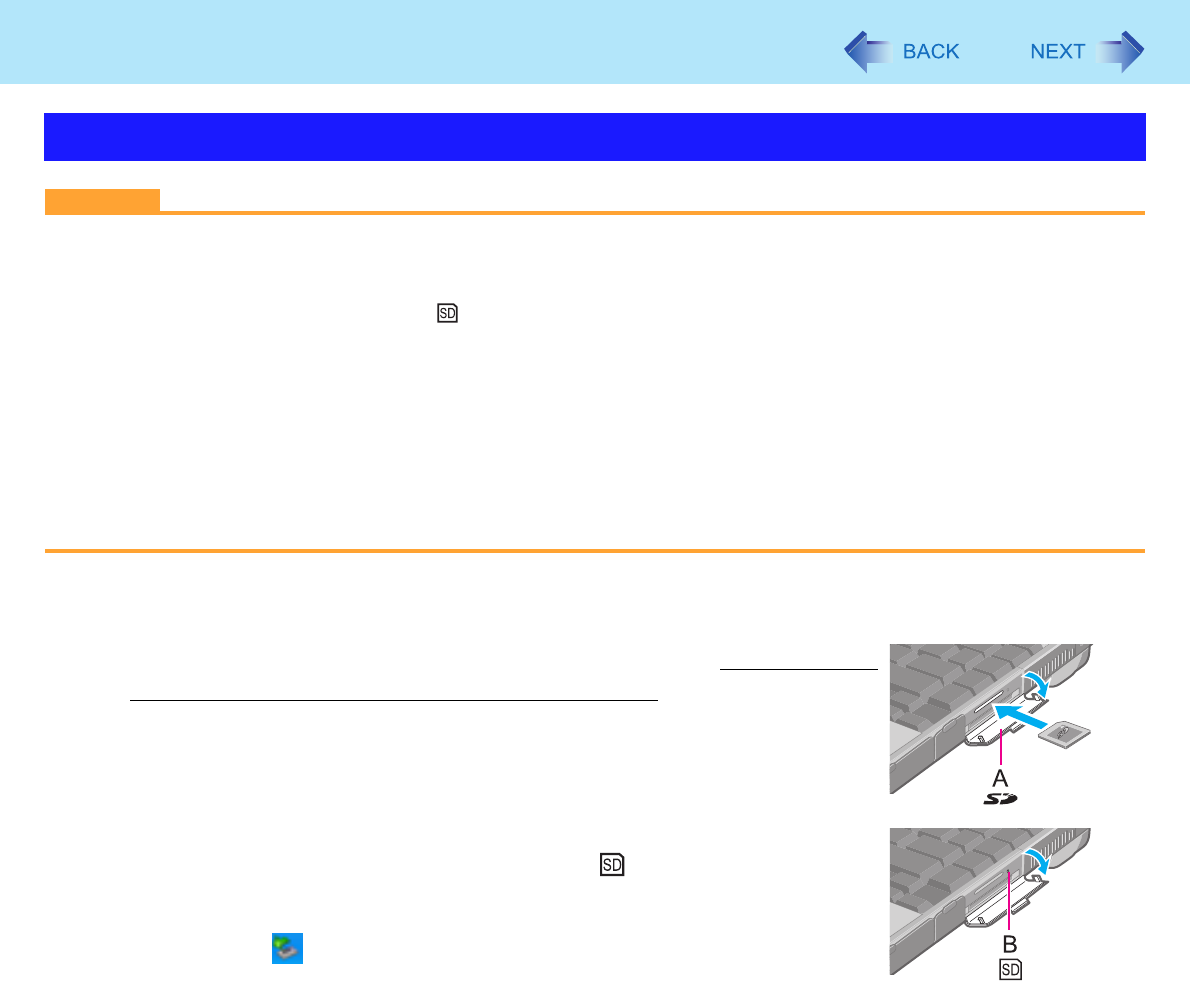
36
SD Memory Card
CAUTION
zDo not remove or insert the SD Memory Card until Windows has completed loading.
zDo not remove the card or turn off the computer in the following cases, otherwise the data may be corrupted.
• While the computer is in standby or hibernation.
• While the SD Memory Card indicator is on.
• While data is being read from or written to the card.
• Immediately after the writing operation. The computer may still continue the access to the card just after writing
operation. If you remove the card before the operation is completed, the data may be damaged or the card access
may no longer be performed normally.
zNote that Panasonic assumes absolutely no liability for any loss of data recorded by the user, or any other damages,
direct or indirect.
zDo not forcibly draw out the card, otherwise the slot may be damaged.
zInsert the card in the correct direction, otherwise the card and the slot may be damaged.
zAfter resuming from standby or hibernation, do not access the SD Memory Card for approximately 30 seconds.
To insert the card
1Open the cover (A), and insert the SD Memory Card with the label
side facing up and with the cut corner in front.
To remove the card
Preparation
zSave the data and close all applications.
zOpen the cover and confirm the SD Memory Card indicator (B) is off.
1Disable the card function.
ADouble-click on the notification area and click [Secure Digital Storage Device],
then click [Stop].
BFollow the on-screen instructions.
zThis step is not necessary when removing the card after turning off the computer.
Inserting/Removing the SD Memory Card

38
SD Security
Inserting a specific SD Memory Card can work as an alternative to entering password in the cases below. Format the card
and make the necessary settings.
zStarting up the computer
zResuming the computer from standby, hibernation or screensaver
zLogging on to Windows
NOTE
zYou can start up the computer by entering the Supervisor Password or User Password when you do not use the SD
Memory Card.
zUse the formatted SD Memory Card (Îpage 35).
zThis function works only with the SD Memory Card slot. It does not work with other devices such as an SD card
reader/writer connected through USB port.
zYou cannot use this function together with the fingerprint security (optional).
zYou can use the setup SD Memory Card as an ordinary card on the computer and other devices.
zYou can use a single setup SD Memory Card for multiple computers. However, when using the card to log on to Win-
dows, you need to use the same logon user name and the same password on all of the computers.
Preparation
zTo start up the computer
Set the Supervisor Password in the Setup Utility (Îpage 9). (You can also set it during the configuration procedure.)
zTo use the card to log on to Windows or to resume from standby, hibernation or screensaver
Set the Windows logon user account and the password in [Control Panel] in advance. For further information, refer to the
Windows Help.
1Log on to Windows as an administrator.
2Insert the SD Memory Card in the SD Memory Card slot.
If [Secure Digital storage device] appears, click [Take no action], then click [OK].
3Start the SD Card Setup program.
Click [start] - [All Programs] - [Panasonic] - [SD Card Setup].
4Click [Next] in the Welcome screen.
SD Card Setup
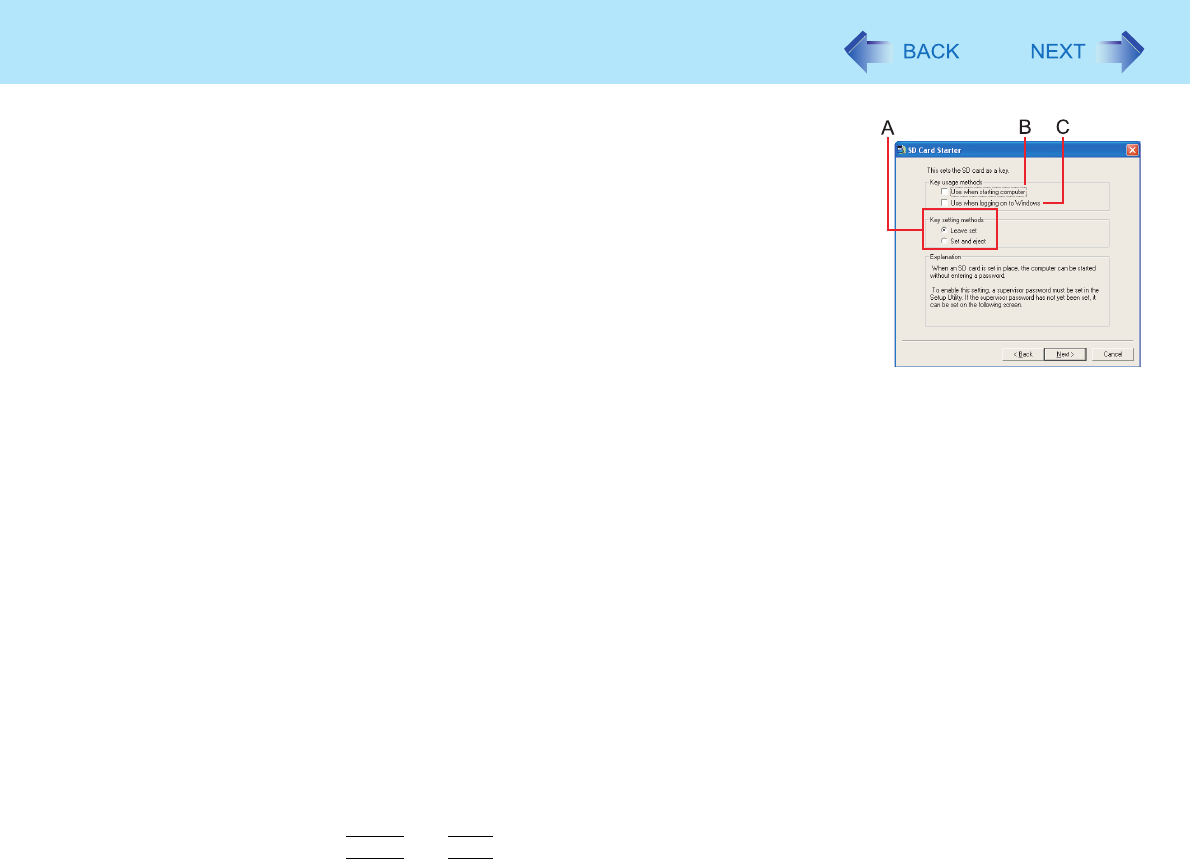
39
SD Security
5Select the trigger operation (A).
[Leave set]
Insert and leave the card in the slot.
(You can remove the card afterward.)
[Set and eject]
Insert the card and eject it.
When logging on to Windows or resuming from standby, hibernation or screen-
saver, eject the card after the beep sounds to indicate card recognition. If the
speakers are muted, beeps do not sound.
zMake the setting on each computer. You cannot use different settings on the
same computer even with different SD Memory Cards.
zTo select different settings for starting the computer and logging on to Windows:
In this screen, set the trigger operation to log on to Windows. After completing the SD Card Setup, start the
Setup Utility and select the setting to start up the computer in [SD Setting Method] of the [Security] menu
(Îpage 68).
6Make the necessary settings.
To start up the computer
The SD Memory Cards will be registered to the computer.
zYou can register up to two cards (To set up the second SD Memory Card: Îpage 40).
AAdd the check mark for [Use when starting computer] (B) and click [Next].
BClick [Restart the computer after entering settings] and click [Finish].
CEnter the Supervisor Password and click [OK].
zIf the Supervisor Password is not set, follow the on-screen instructions to set the Supervisor Password.
zYou can use up to 32 alphanumeric characters (including spaces).
• The case (upper/lower) is ignored.
• To input numbers for the password, use the numbered keys on the keyboard.
• You cannot use
Shift
and
Ctrl
to input a password.
To use the card to log on to Windows
The Windows logon user name and the password set in [Control Panel] are registered in the SD Memory Card.
AAdd the check mark for [Use when logging on to Windows] (C) and click [Next].
BClick [Restart the computer after entering settings] and click [Finish].
CEnter the Windows logon user name and the password.

40
SD Security
zAfter making this setting, the following functions will be disabled.
• Displaying the Welcome screen
• The Fast User Switching function
• Remote desktop connection
zWhen you add the check mark for [Do not check the user name], you can register a user name that is different
from the Windows user name. Click [Yes] at the confirmation message. When restarting the computer and log-
ging on to Windows, you will need to enter the Windows user name and the password without using the SD
Memory Card.
zA [PRIVATE] folder will be created in the SD Memory Card, and the encrypted Windows logon user name and
the password will be registered.
Do not delete [PRIVATE] folder. Doing so will cancel [Use when logging on to Windows].
To use both when starting the computer and when logging on to Windows
Add the check mark to both [Use when starting computer] and [Use when logging on to Windows], and follow the
above steps.
CAUTION
zDo not lose the setup card.
zDo not leave the setup card in the slot when you go away from the computer.
To change the settings / To set up the second SD Memory Card
AStart the SD Card Setup program (Îpage 38 Step1-3).
The screen is different from the initial setup screen.
BChange the settings.
[Setting for this computer]
You can change the settings registered in this computer.
[Setting for this SD card]
You can change the settings of the inserted SD Memory Card.
CClick [OK].
DMake the necessary settings.
zRefer to the initial setup procedure above.
zYou may need to enter the password to proceed the steps.
ERestart the computer.

41
SD Security
To disable the setup card
If you have lost the setup card, disable the card to avoid unauthorized startup or logon.
When using the card to start up the computer
AStart the SD Card Setup program. (Îpage 38 Step1-3)
The current settings will be displayed.
BRemove the check mark from [Use the SD card when starting the computer].
CClick [OK], and then follow the on-screen instructions.
All SD Memory Cards currently registered on this computer will no longer be usable to start up the computer.
zEven if you add the check mark again for [Use the SD card when starting the computer], the card will not be
usable to start up.
When using the card to log on to Windows
AChange the Windows logon password.
The card will no longer be usable to log on to Windows.
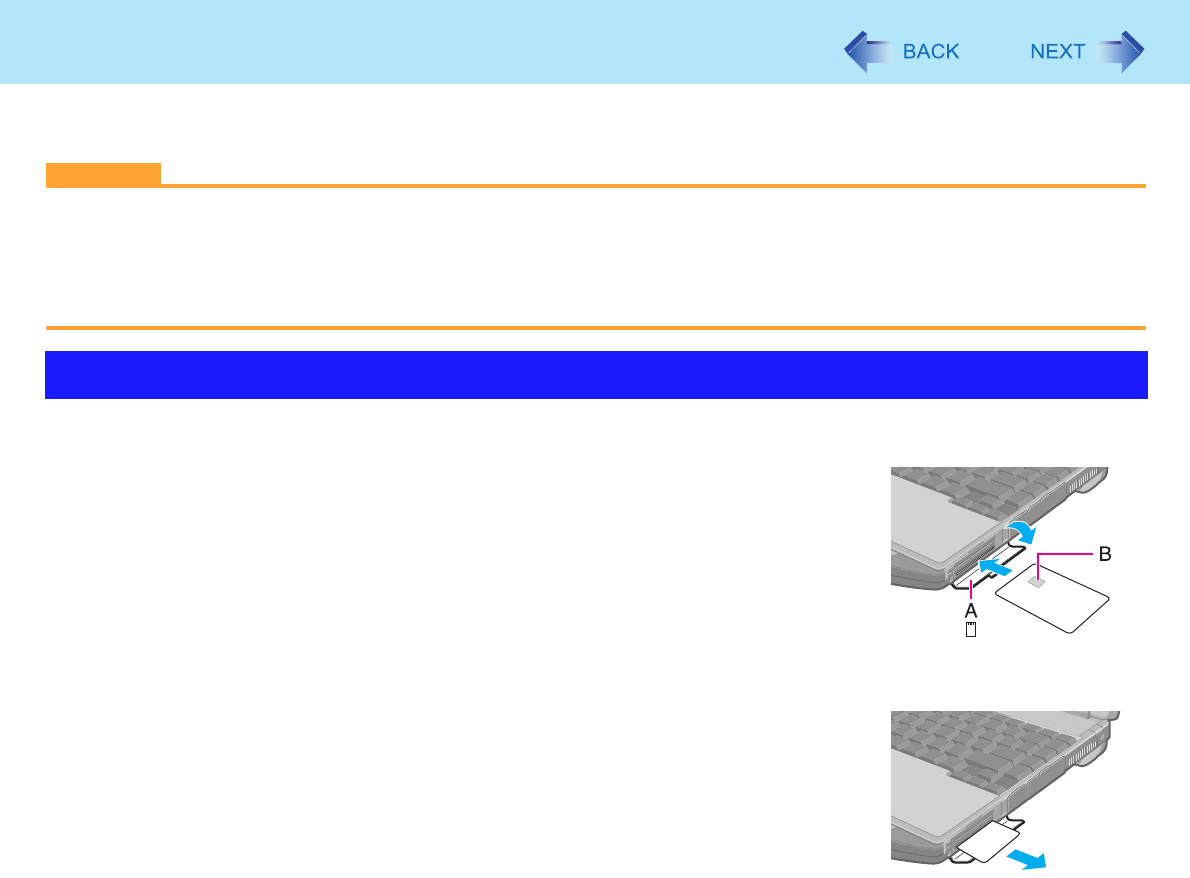
42
Smart Card
<Only for model with Smart Card slot>
You need software to use a Smart Card.
CAUTION
zDo not:
• Hit, bend, or drop the card.
• Touch the contact part with fingers or metal object.
• Place the card in very hot location for a long time.
• Remove the card immediately after inserting it.
To insert the card
1Open the cover (A), and insert the Smart Card with the contact
part (B) in front.
zInsert the card until it surely fits in the slot.
To remove the card
1Open the cover and draw the card straight out.
Inserting/Removing the Smart Card
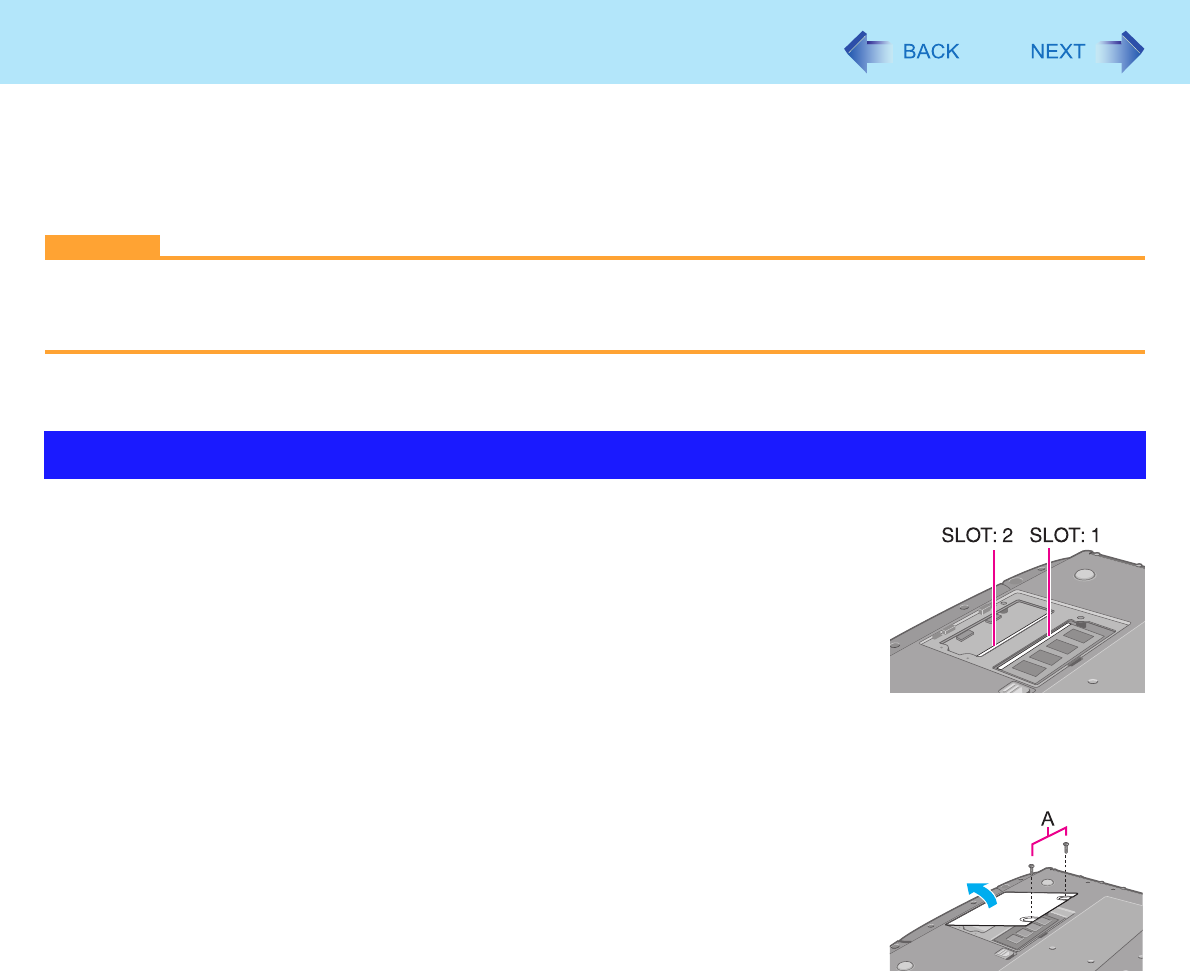
43
RAM Module
Use RAM modules that comply with the specifications below. Using any other module may cause malfunction or result in
computer failure.
RAM module specifications:
200 pins, SO-DIMM, 1.8 V, DDR2 SDRAM, PC2-5300
(For information of RAM module compatibility, contact Panasonic Technical Support.)
CAUTION
zRAM modules are extremely sensitive to static electricity and can be affected even by static electricity from the human
body. When inserting and removing RAM modules, do not touch the terminals or internal components, and do not
allow foreign particles to enter the slots. Doing so may cause damage, fire, or electric shock.
This computer has two RAM module slots.
zWhen using a RAM module, insert it in SLOT: 1. (At purchase, the RAM module is in
SLOT: 1.)
zWhen using an extra RAM module, insert it in SLOT: 2.
1Turn off the computer.
zDo not use standby or hibernation.
2Disconnect the AC adaptor and remove the battery pack (Îpage 17).
3Remove the screws (A) and the cover on the bottom of the com-
puter.
Inserting/Removing the RAM Module
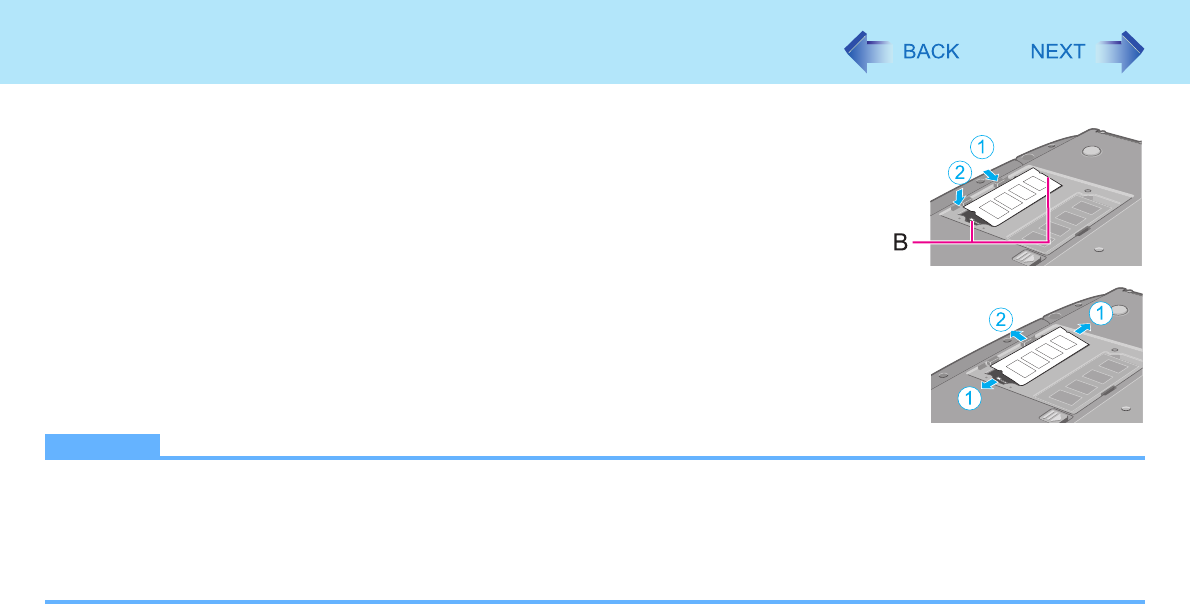
44
RAM Module
4Insert/Remove the RAM module.
zTo insert
ATilt the module slightly and insert it in the slot.
BPress down the module so that the right and left hooks (B) are locked.
zTo remove
ACarefully open the right and left hooks (B).
The module will rise.
BCarefully remove the module from the slot.
5Set the cover and battery pack.
NOTE
zIf it is hard to insert or to press down the RAM module, do not try forcibly but check the module’s direction.
zUse the appropriate screw driver so as not to strip the thread of screw.
zIf the RAM module is recognized correctly, the total size of the main unit memory and RAM module memory is dis-
played on the [Information] menu of the Setup Utility (Îpage 65).
If the RAM module is not recognized, power off the computer and insert it again.

45
Mini Port Replicator
You can use an optional mini port replicator (CF-VEBU06W). This device frees you from
being bothered by a lot of cable connections when you carry the computer. It also allows you
to connect various peripherals.
Connect the mini port replicator to the expansion bus connector (A).
For further information, refer to the instruction manual of the mini port replicator.
NOTE
When an external display is connected to the mini port replicator and the 1280 x 1024 or higher resolution is selected, the
characters may be blurred on the external display. In this case, select the lower resolution.
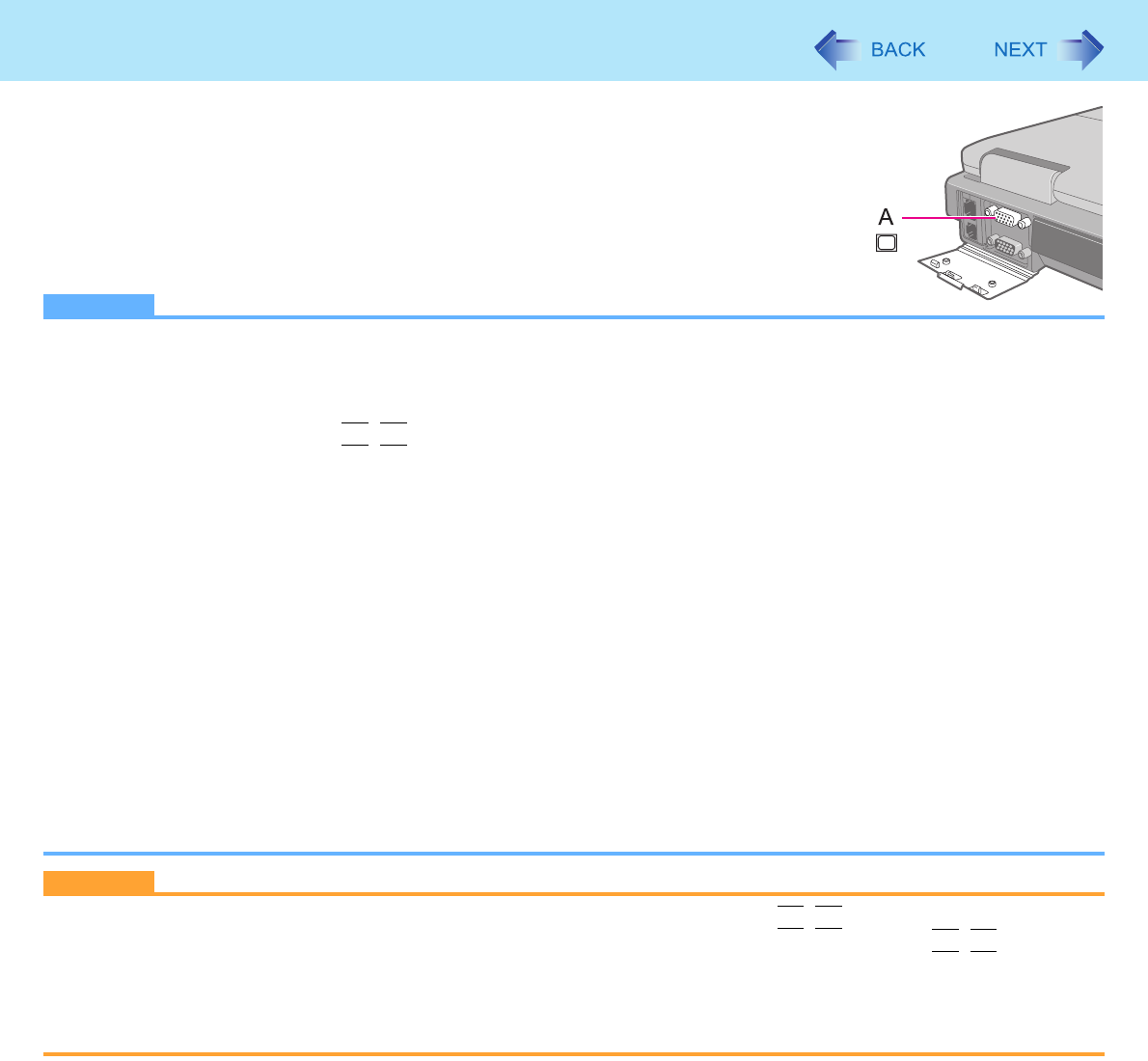
46
External Display
You can switch the output destination to an external display.
Connect the external display to the external display port (A).
NOTE
zAfter resuming from hibernation or restarting the computer, the output destination may not be the same as selected in
the previous status.
zWhen you change the display after Windows starts up, do not press any key until switching is complete.
zYou cannot use the simultaneous display until Windows starts up.
zDisplay switching by pressing
Fn
+
F3
may not work when you use the Fast User Switching function to switch the user.
In this case, log off all users and restart the computer.
zSimultaneous display and display switching do not work when [Command Prompt] screen is set to “Full Screen”.
zWhen you use the external display only, set the suitable number of colors, resolution, or refresh rate separately from
when you use the internal LCD only or when you use the simultaneous display.
Depending on the settings, some external displays may be distorted or may not display the mouse cursor correctly. In
this case, set the settings to lower value.
zWhen you use the simultaneous display, DVD-Video, MPEG files and other motion image files may not be played back
smoothly.
zCarefully read the instruction manual of the external display.
zWhen connecting an external display that does not conform to the Plug & Play standards, select the display driver
accordingly in the following menu, or use the driver disc supplied with the monitor.
[start] - [Control Panel] - [Appearance and Themes] - [Display] - [Settings] - [Advanced] - [Monitor] - [Properties] -
[Driver] - [Update Driver]
zIf a picture is not displayed normally, lower the level of [Hardware acceleration] in the following menu.
[start] - [Control Panel] - [Appearance and Themes] - [Display] - [Settings] - [Advanced] - [Troubleshoot]
zIf you connect an external display via the mini port replicator (CF-VEBU06W), the output switches to the mini port rep-
licator from the external display port.
CAUTION
zBefore disconnecting the external display, switch to the internal LCD by pressing
Fn
+
F3
. Otherwise the displayed
image quality may become different after disconnection (e.g., wrong resolution). In this case, press
Fn
+
F3
to reset
the image quality.
zThe screen may become distorted due to the following operations. In this case, restart the computer.
• Disconnecting an external display for which you have set high resolution or high refresh rate.
• Connecting/disconnecting an external display during computer operations.
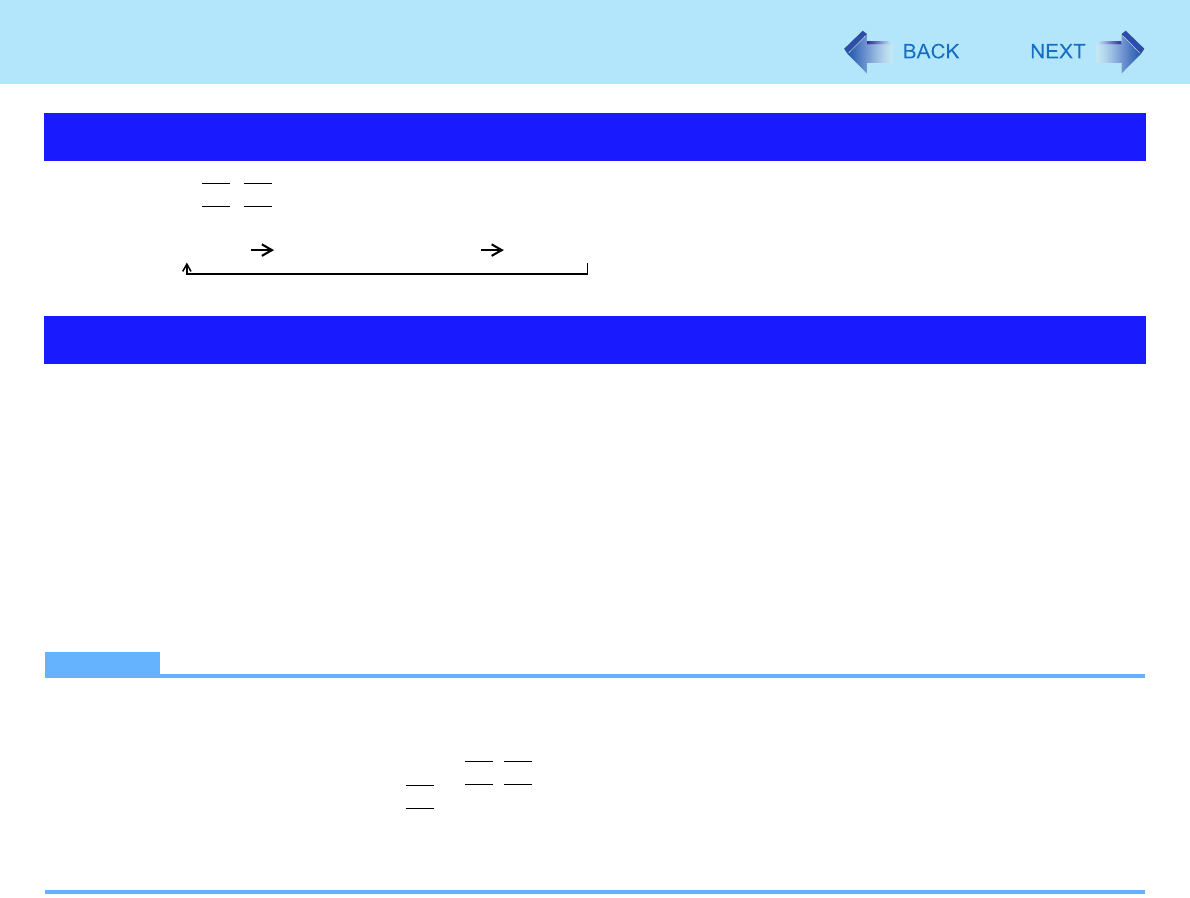
47
External Display
1Press
Fn
+
F3
.
Each time you press the key combination:
Internal LCD Simultaneous display External display
The extended desktop function allows you to use the working area across both the internal LCD and the external display. You
can drag an object from the internal LCD to the external display and vice versa.
1Display [Intel(R) Graphics Media Accelerator Driver for mobile] screen.
Click [start] - [Control Panel] - [Other Control Panel Options] - [Intel(R) GMA Driver for Mobile] - [Display Devices].
2Click [Extended Desktop], and make the settings for [Primary Device] and [Secondary
Device].
3Click [OK].
At the confirmation message, click [OK].
NOTE
zIt may not be possible to use the extended desktop with some software applications.
zWhen you click the maximize button, the window is displayed on one of the displays. You cannot move the maximized
window to the other display.
zYou cannot switch the display by pressing
Fn
+
F3
.
zThe popup menu icon displayed by
Fn
key combination appears only on the primary device.
z<Only for model with touchscreen>
Set the internal LCD to the primary device when using the touchscreen. The cursor will move on the primary device
when you touch the internal LCD.
Switching the Display
Extended Desktop
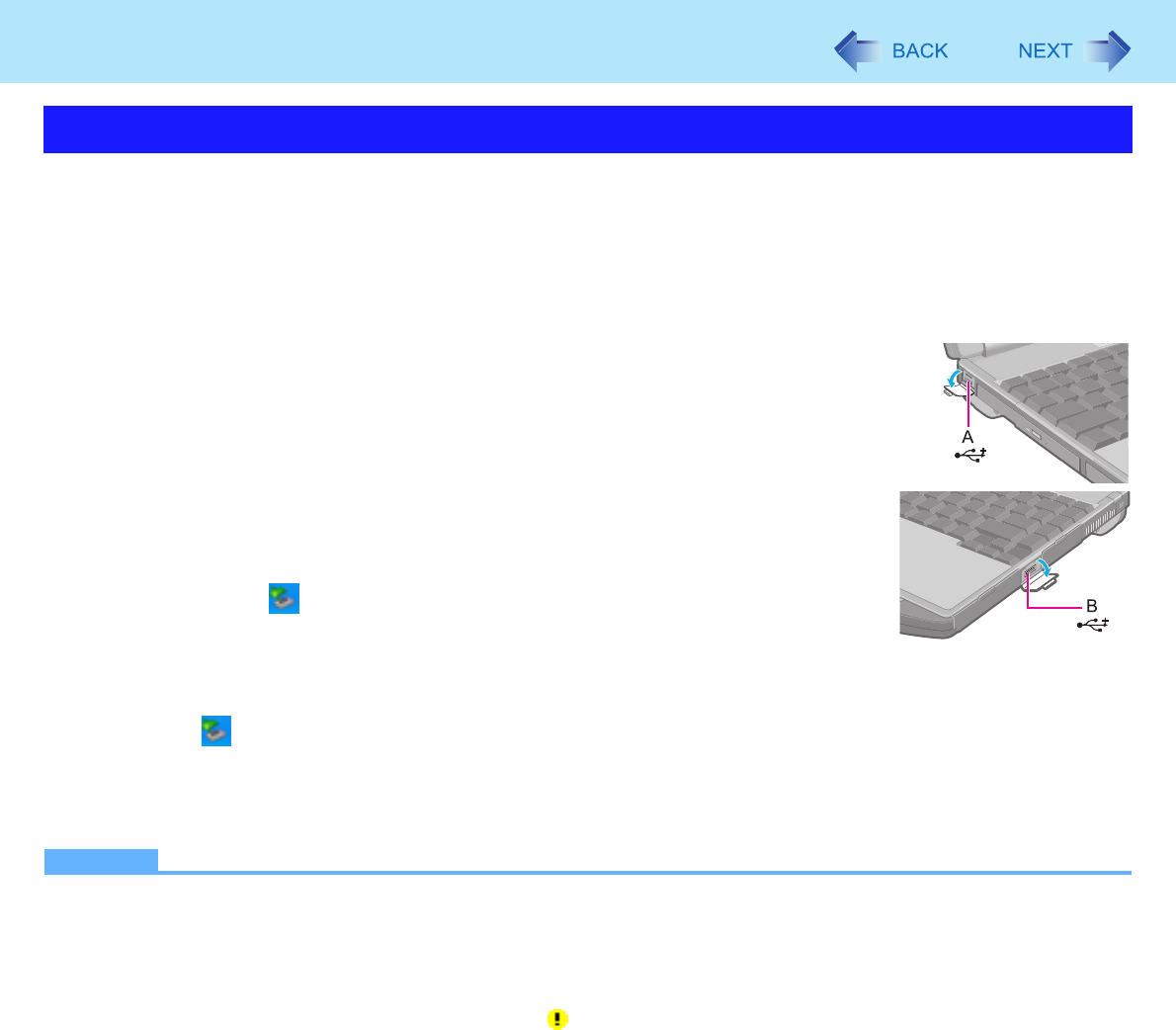
48
USB Devices
Preparation
Before connecting a USB device, first determine the media that contains the device’s driver (e.g., CD-ROM), then
attach the device for that media to the multimedia pocket. Once the installation screen for the device’s driver appears,
equipment you then connect to the multimedia pocket will not be recognized.
To connect the USB device
1Open the cover and connect the USB device to one of the USB
ports (A or B) on the computer.
For further information, refer to the instruction manual of the USB device.
To remove the USB device
1Disable the USB device.
ADouble-click on the notification area and select the USB device, then click
[Stop].
BFollow the on-screen instructions.
zThis step is not necessary when;
• Removing the device after turning off the computer.
• is not displayed.
• The device does not appear in the list in step A.
2Remove the USB device.
NOTE
zYou may need to install the driver for the USB device. Follow the on-screen instructions or refer to the instruction man-
ual of the USB device.
zYou may need to install the driver again when connecting the device to another port.
zWhen a USB device is connected, standby and hibernation may not function normally. If the computer does not start
up normally, remove the USB device and restart the computer.
zWhen the USB device is removed and then inserted, may appear in the Device Manager and the device may not be
correctly recognized. In this case, remove and connect the device again.
Connecting/Removing USB Devices
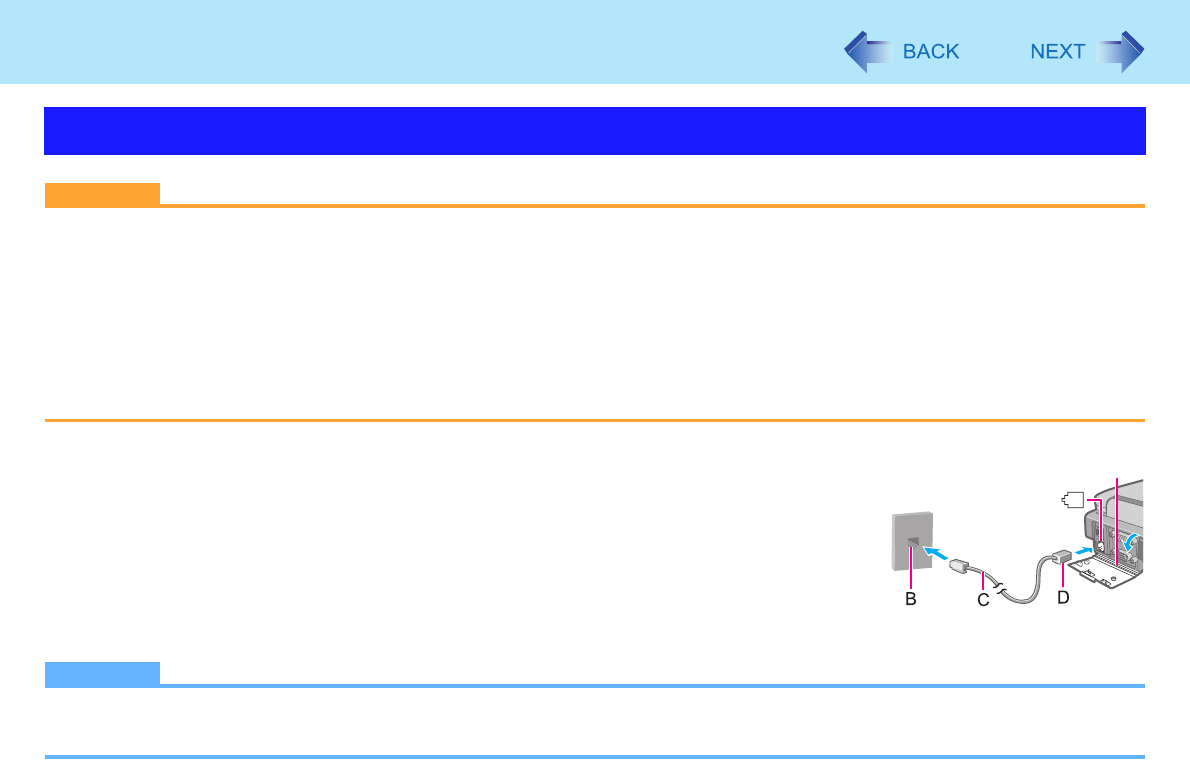
50
Modem
CAUTION
zDo not use the PBX internal phone lines installed in company offices. Doing so may lead to a fire or electric shock.
zYou cannot connect the modem to the following lines.
• Interphone
• Intercoms
•ISDN
zBe sure to connect the telephone cable into the modem port, not into the LAN port.
zUse a surge protector since the modem may be damaged by a sudden high voltage surge that may occur in the event
of a lightning strike.
1Open the cover (A), and connect the computer and the tele-
phone jack (B) using the telephone cable (included) (C).
zHold the cable so that the shape of the connector (D) matches the port, and
insert fully until it clicks.
2Click [start] - [Control Panel] - [Printers and Other Hardware] -
[Phone and Modem Options] and change the settings as neces-
sary.
NOTE
zDo not enter standby or hibernation during communications.
zTo remove the cable, press and hold the lever and pull out.
Connecting the Internal Modem with a Telephone Jack
A
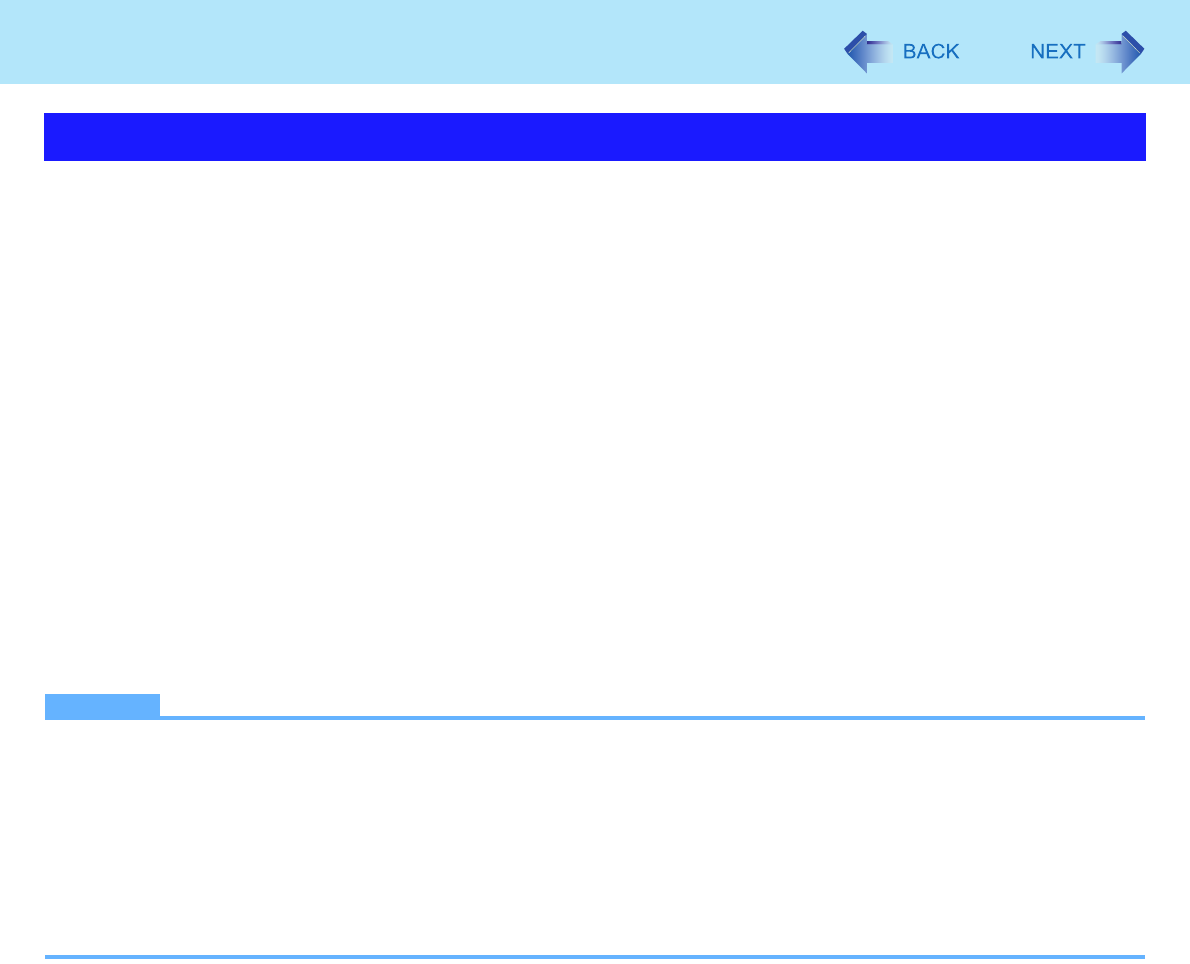
51
Modem
The computer automatically resumes from standby when the telephone connected to the modem rings.
You will need software to keep the computer in idle state waiting for a phone call, and if you prefer, to turn the computer to
standby again afterward. For further information, refer to the instruction manual of the software application.
To enable this function
1Click [start] - [Control Panel] - [Performance and Maintenance] - [System] - [Hardware] -
[Device Manager] - [Modems], and double-click the internal modem.
2Click [Power Management], add the check mark for [Allow this device to bring the com-
puter out of standby.], and click [OK].
To set the time to return the computer to standby
The computer will enter standby after the set time even when the communication is not completed. You can avoid such an
uncompleted communication if you select [Never], but the computer does not return to standby after resuming by a phone
call.
AClick [start] - [Control Panel] - [Performance and Maintenance] - [Power Options] - [Power Schemes].
BSet the expected communication time.
NOTE
zThis function does not work when the computer is off or is in hibernation.
zConnect the AC adaptor.
zThe screen remains dark after the computer resumes from standby. The previous screen display will be restored when
you touch the keyboard, touch pad or touchscreen (only for model with touchscreen).
zThe computer cannot resume if the telephone is not connected to the internal modem. (e.g., you cannot use a PC
Card modem.)
zThe computer needs some time to respond, so set the calling time longer than normal. If this is not possible on the
transmission side, reduce the number of rings before answering on the software that you are using to keep the com-
puter in idle waiting for the call.
Ring Resume Function
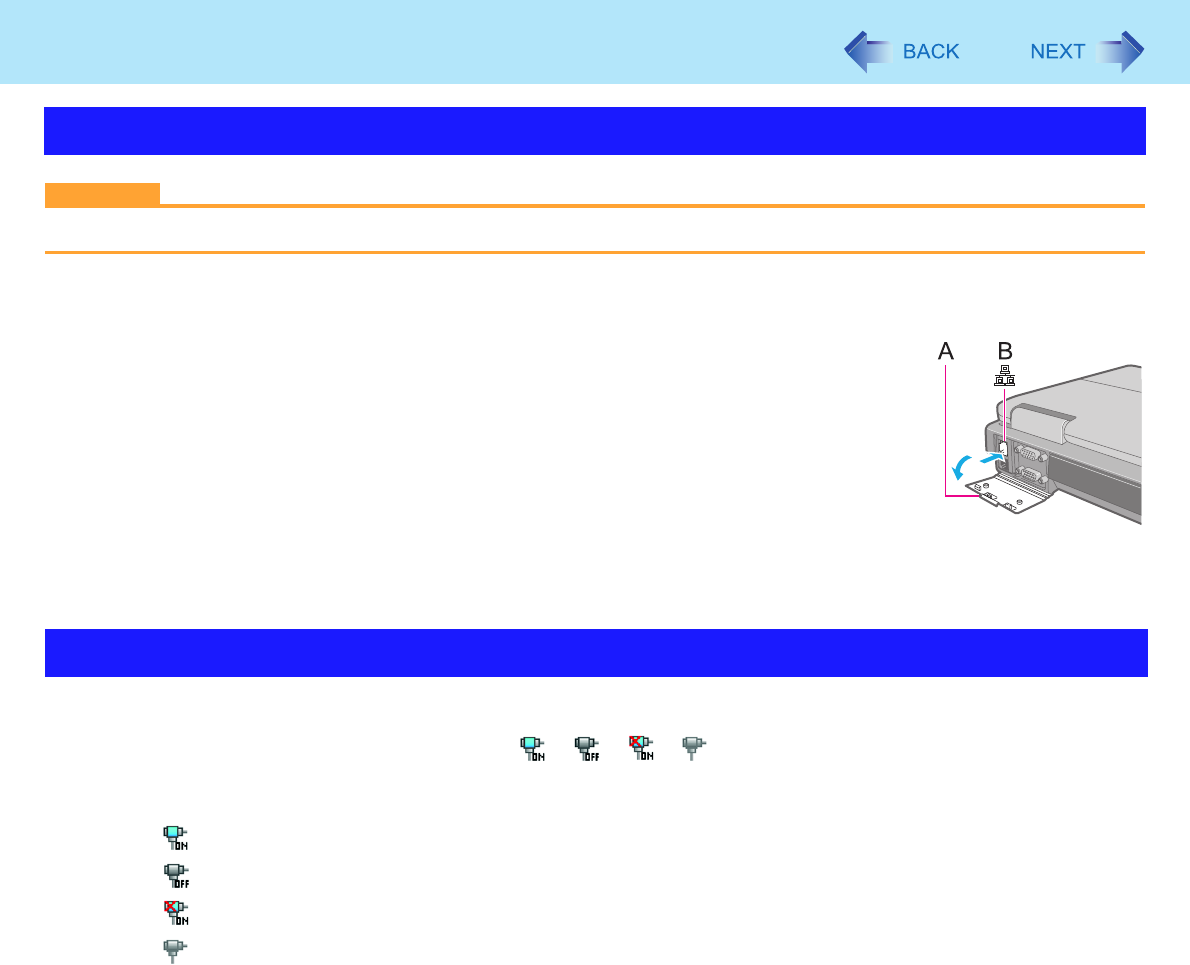
52
LAN
CAUTION
zDo not connect the telephone cable to the LAN port.
1Turn off the computer.
zDo not use standby or hibernation.
2Open the cover (A) and connect the cable.
Connect the LAN port (B) and the network system (server, HUB, etc.) by using a
LAN cable.
3Turn on the computer.
To check the Local Area Connection status
AClick [start] - [Connect To] - [Show all connections].
You can turn off the LAN device to reduce power consumption during battery operation.
1Click the LAN device power icon ( / / / ) on the notification area.
zIf the icon is not displayed on the notification area, click [start] - [All Programs] - [Panasonic] - [LAN Power-
Saving Utility].
z : The Local Area Connection is enabled and the LAN device is on.
: The Local Area Connection is enabled and the LAN device is off.
: The Local Area Connection is disabled and the LAN device is on.
: LAN is disabled in the Setup Utility (Îpage 67).
2Select the setting.
Connecting LAN
LAN Power-saving Function
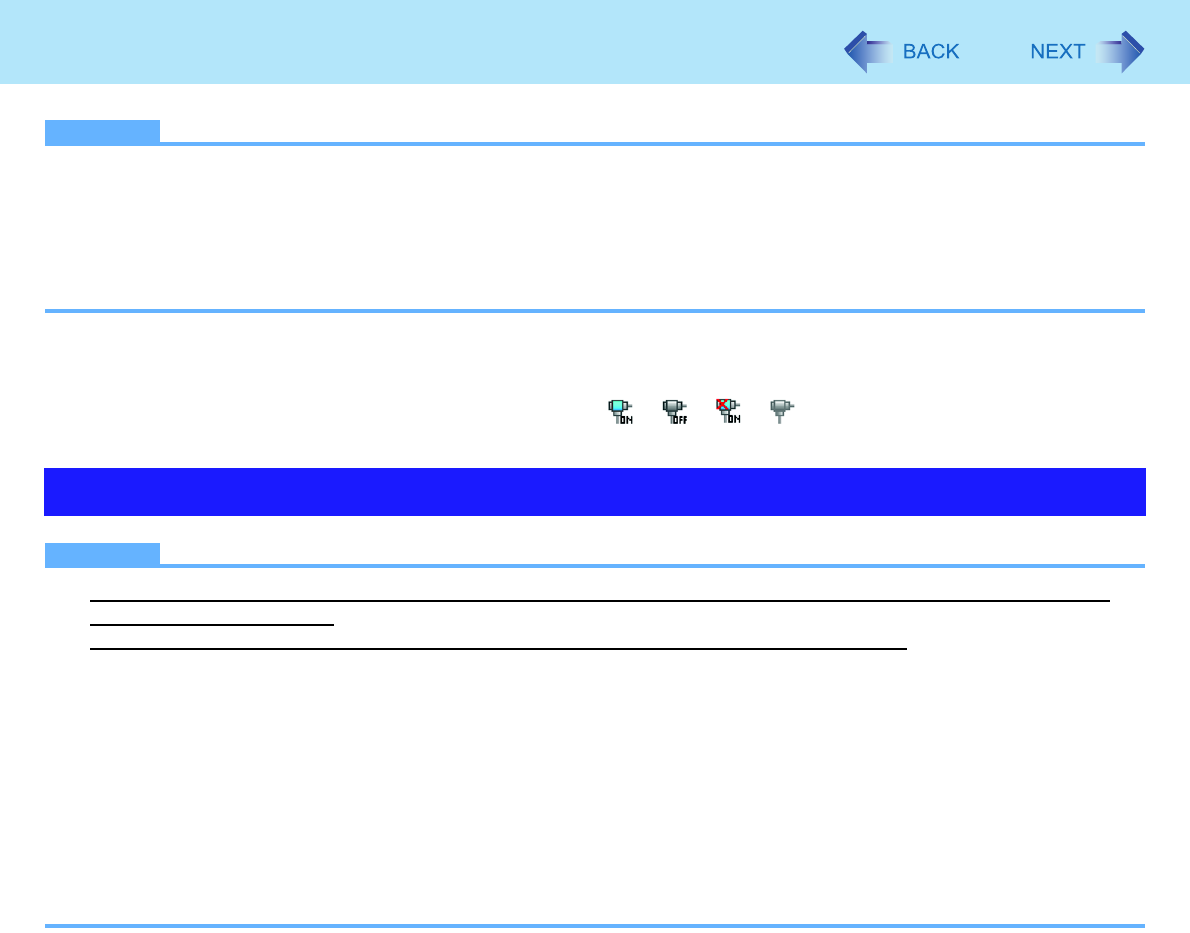
53
LAN
NOTE
zThis function does not work during AC operation. The LAN device will be turned on automatically when the AC adaptor
is connected.
zYou can set [Auto Off Setting for LAN] separately from [Manual Switching for LAN].
zTo check the Local Area Connection status, click [start] - [Connect To] - [Show all connections].
zDo not use this function when using the Power On by LAN/Wake Up from LAN function. When the LAN device is
turned off by using the LAN power-saving function, the computer does not wake up.
To check the LAN power-saving status
APlace the cursor over the LAN device power icon ( / / / ) on the notification area.
A tooltip appears.
NOTE
zWhen this function is enabled, power is consumed even the computer is in standby, hibernation, or powered off. Be
sure to use the AC adaptor.
When not using this function, perform the following procedure to reduce power consumption.
AClick [start] - [Control Panel] - [Performance and Maintenance] - [System] - [Hardware] - [Device Manager] -
[Network adapters] and double-click [Marvell Yukon 88E8055 PCI-E Gigabit Ethernet Controller], and then click
[Power Management].
BRemove check mark for [Allow this device to bring the computer out of standby.], and click [OK].
zEven when a password is set in the Setup Utility and [Password on boot] is set to [Enable], entering the password is
unnecessary for turning on or resuming the computer.
zThis function is off under the following conditions:
• When you turn the computer off by pressing the power switch for four seconds or longer (e.g., after a hung-up).
• When you reattach the AC adaptor and battery pack to the computer after removing them.
zThe screen remains dark after the computer resumes from standby. The previous screen display will be restored when
you touch the keyboard, touch pad or touchscreen (only for model with touchscreen).
Power On by LAN/Wake Up from LAN
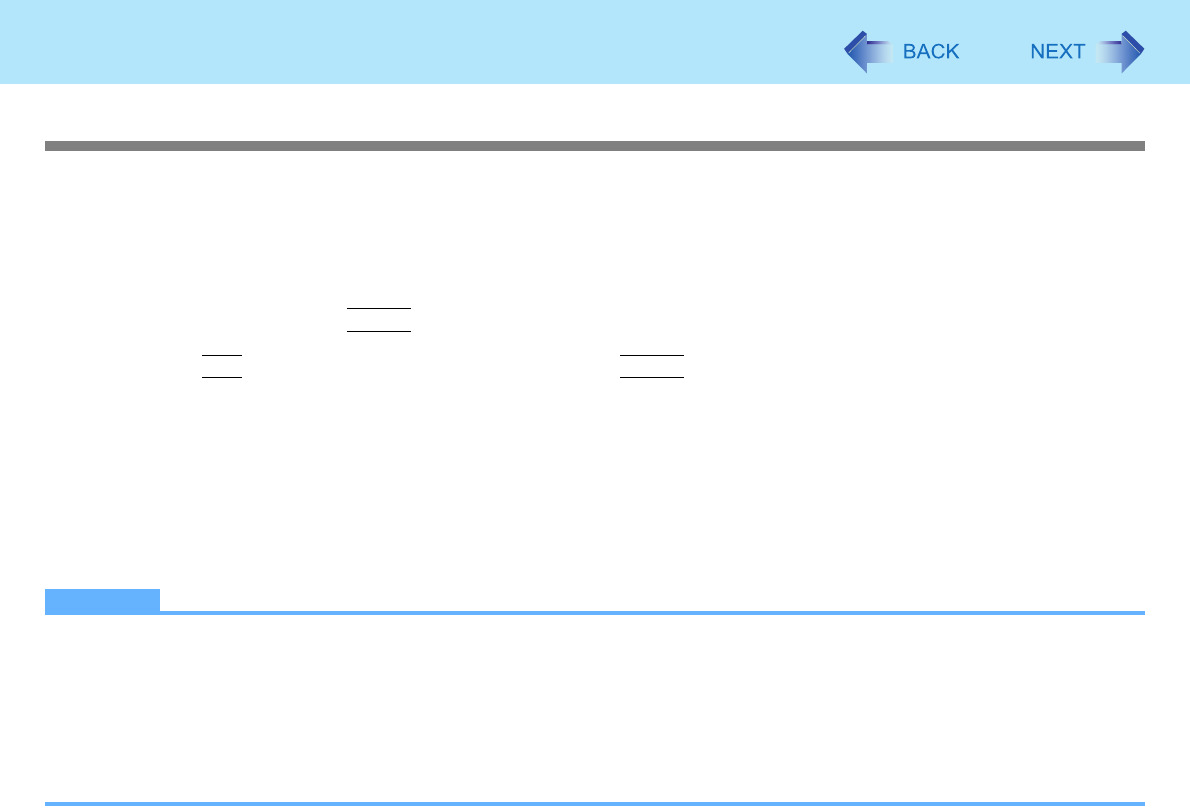
54
LAN
Enabling the Power On by LAN function
The computer automatically turns from off to on when the computer is accessed from the network server via the internal LAN
port.
1Select [Allow] in [Power On by LAN] in the [Advanced] menu of the Setup Utility (Îpage
67).
2In [Caution], press
Enter
.
3Press
F10
, and then select [Yes] and press
Enter
.
4Log on to Windows as an administrator.
5Click [start] - [Control Panel] - [Performance and Maintenance] - [System] - [Hardware] -
[Device Manager] - [Network adapters] and double-click [Marvell Yukon 88E8055 PCI-E
Gigabit Ethernet Controller], and then click [Advanced].
6Click [Wake From Shutdown] in [Property] and select [On] in [Value], and click [OK].
NOTE
zThe computer may accidentally turn on if the linkage status is changed. To prevent the accidental startup, make the
setting by the following steps.
AClick [start] - [Control Panel] - [Performance and Maintenance] - [System] - [Hardware] - [Device Manager] -
[Network adapters], and double-click [Marvell Yukon 88E8055 PCI-E Gigabit Ethernet Controller], and then click
[Advanced].
BClick [Wake Up Capabilities] in [Property] and select [Magic Packet] in [Value], and click [OK].
zIf you forcibly shut down Windows, the Power ON by LAN function will not work.

55
LAN
Enabling the Wake Up from LAN function
The computer automatically resumes from standby or hibernation when the computer is accessed from the network server via
the internal LAN port.
1Click [start] - [Control Panel] - [Performance and Maintenance] - [System] - [Hardware] -
[Device Manager] - [Network adapters] and double-click [Marvell Yukon 88E8055 PCI-E
Gigabit Ethernet Controller], and then click [Power Management].
2Add check marks for [Allow the computer to turn off this device to save power.] and
[Allow this device to bring the computer out of standby.], and click [OK].
NOTE
zThe computer may resume when another computer in the network makes unintentional access.
Using the following procedure, you can prevent accidental startup by unintentional access.
AClick [start] - [Control Panel] - [Performance and Maintenance] - [System] - [Hardware] - [Device Manager] -
[Network adapters] and double-click [Marvell Yukon 88E8055 PCI-E Gigabit Ethernet Controller], and then click
[Power Management].
BAdd a check mark for [Only allow management stations to bring the computer out of standby.], and click [OK].
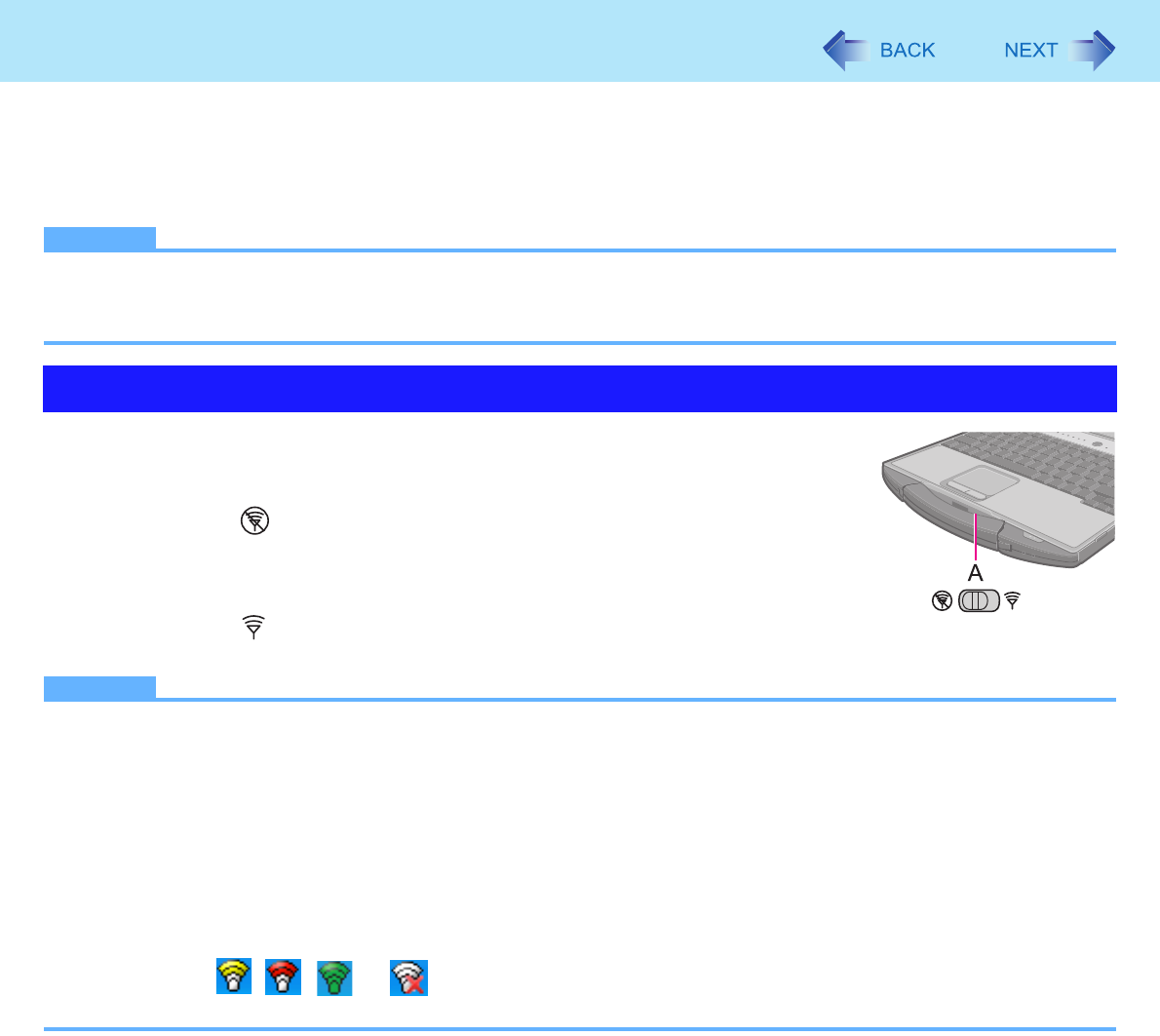
56
Disabling/Enabling Wireless Communication
<Only for model with wireless LAN, Bluetooth and/or wireless WAN>
There are three ways of disabling and enabling wireless communication.
zThe wireless switch on the front of the computer (below)
zThe wireless switch utility (Îpage 57)
zSettings in the [Advanced] menu of the Setup Utility (Îpage 67)
NOTE
zFor further information about Wireless LAN: Îpage 58
zFor further information about Bluetooth: Îpage 62
zFor further information about Wireless WAN: Refer to the instruction manual of the wireless device.
To disable all wireless communication
1Switch to (OFF)
To enable wireless communication
1Switch to (ON)
zIn the default setting, the wireless switch enables all wireless devices when it is set to ON.
NOTE
zIf you uninstall the Wireless Switch Utility, set the wireless switch to ON.
zDo not turn on/off the switch repeatedly at too short intervals.
zDo not restart, log off, or enter standby or hibernation immediately after turning on/off the switch.
zDo not turn on/off the switch while Windows is starting up.
zTo use wireless communication, set the wireless devices ([Wireless LAN] / [Bluetooth] / [Wireless WAN]) to [Enable]
(default) in the [Advanced] menu of the Setup Utility (Îpage 67).
zIt may take some time to turn off wireless communication after switching the wireless switch off.
zIf the IEEE802.11a setting is changed in [Device Manager] (Îpage 60), the display will be changed accordingly.
zYou can check the wireless LAN communication status in Intel® PROSet/Wireless Software. Perform either of the fol-
lowing procedures.
• Double-click , , , or on the notification area.
• Click [start] - [All Programs] - [Intel PROSet Wireless] - [Intel PROSet Wireless].
The Wireless Switch
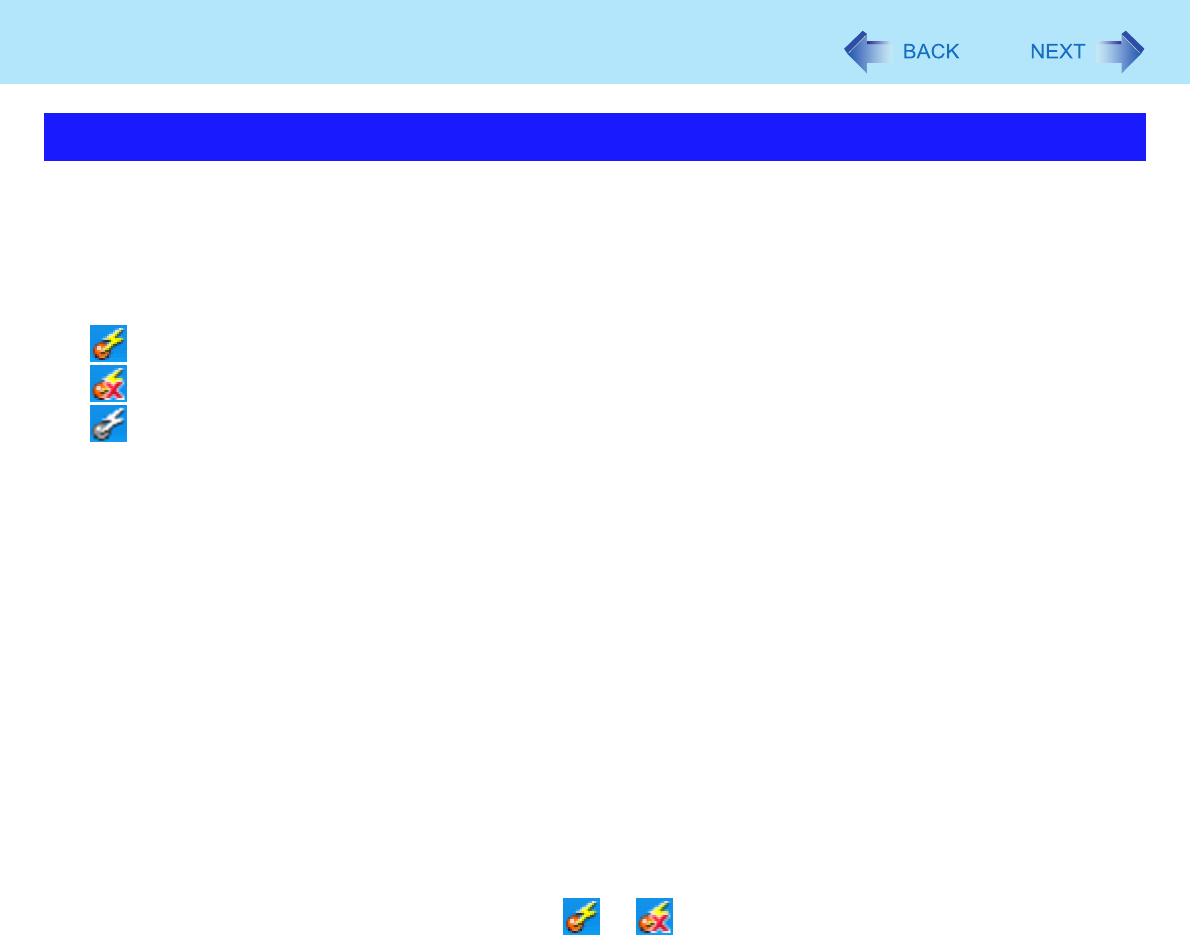
57
Disabling/Enabling Wireless Communication
This utility allows you to control the function of the wireless switch. This utility also allows you to enable or disable wireless
devices from a pop-up menu in the notification area. In the default setting, all wireless devices are enabled.
The Wireless Switch Utility icon
The icon appears in the notification area when the computer is turned ON. It shows the status of wireless devices.
• : Indicates that the wireless devices are enabled.
• : Indicates that the wireless devices are off.
• : Indicates that the wireless devices have been disabled in the Setup Utility.
To enable or disable particular wireless devices
1Click the Wireless Switch Utility icon to show the pop-up menu
2Select On or Off for the device you want to enable or disable.
To change the function of the Wireless Switch
In the default setting, the Wireless Switch enables all wireless devices when it is set to ON. You can change this function.
[Selects the device for which to turn the device status on each time with the dialog box.]
Display a dialog each time you set the Wireless Switch to ON so you can choose which wireless device to
enable.
[Turns on the following device.] (default)
Only selected devices are enabled when you set the Wireless Switch to ON.
[Turns on the device that was on immediately before the wireless switch was turned off the last time.]
When you turn on the wireless switch, the on/off settings that were selected when you last turned off the wireless
switch will be restored.
1Click the Wireless Switch Utility icon ( or ) on the notification area and click [Set-
tings].
2Select the setting you want to assign to the wireless switch.
3Click [OK].
The Wireless Switch Utility
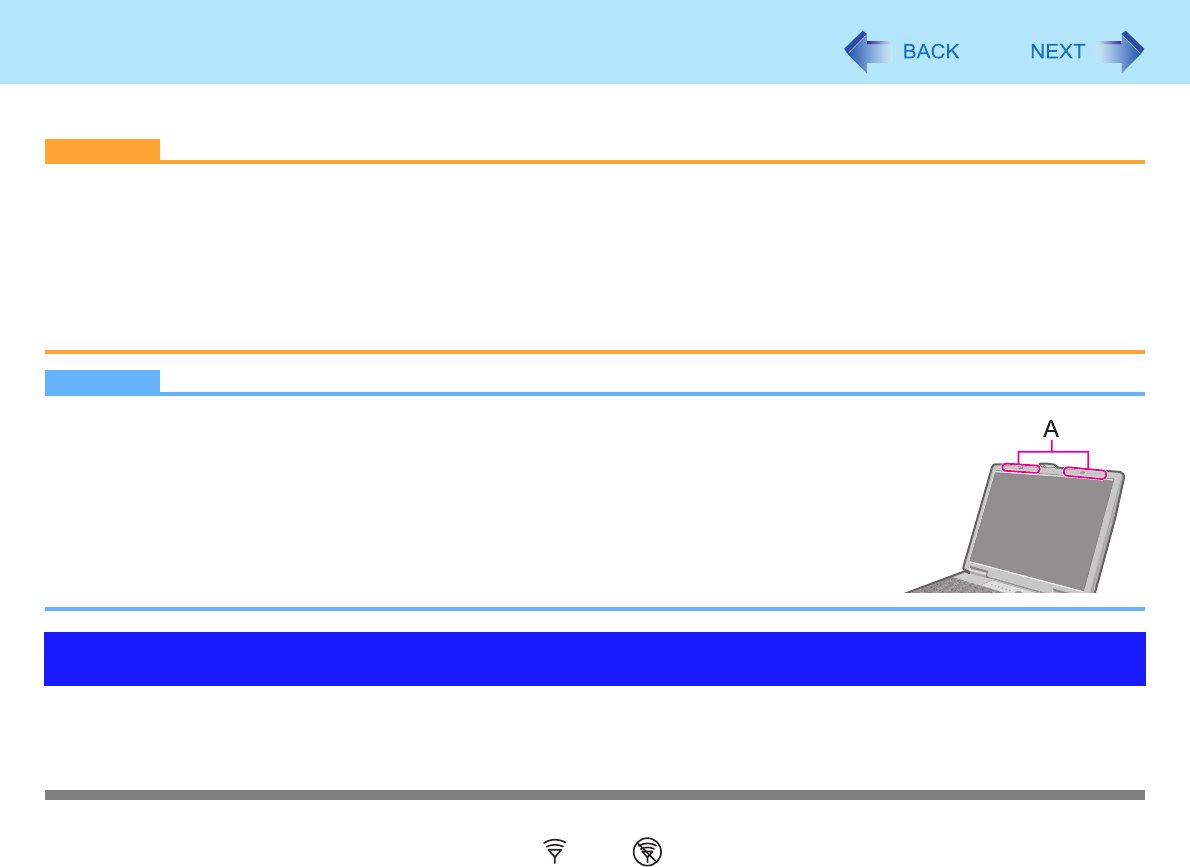
58
Wireless LAN
<Only for model with wireless LAN>
CAUTION
zDo not use wireless LAN on airplanes, in hospitals, or in other locations where wireless LAN signals may
affect peripheral devices.
Follow the instructions of airline companies and hospitals. If you use the computer in these locations, turn off the wire-
less LAN.
zTo avoid unauthorized access to the computer through wireless LAN
We recommend you to make security settings such as encryption before using wireless LAN. Otherwise the hard disk
data such as the shared files can be exposed to the risk of unauthorized access.
NOTE
zCommunication is established through the wireless LAN antenna (A). Do not block the
antenna area with your hand or body.
zYou cannot use the wireless LAN function together with the Fast User Switching function.
zThe transmission rate will be lower when a microwave oven is used near by.
zTo use wireless LAN, set [Wireless LAN] to [Enable] (default) in the [Advanced] menu of the
Setup Utility (Îpage 67).
zIt may take some time to turn off wireless LAN after switching the wireless switch to off.
Before using a wireless LAN, turn the wireless LAN communication on.
Turning on/off the wireless LAN communication
1Slide the wireless switch to turn on / off wireless LAN. (Îpage 56)
Using the Wireless LAN Function
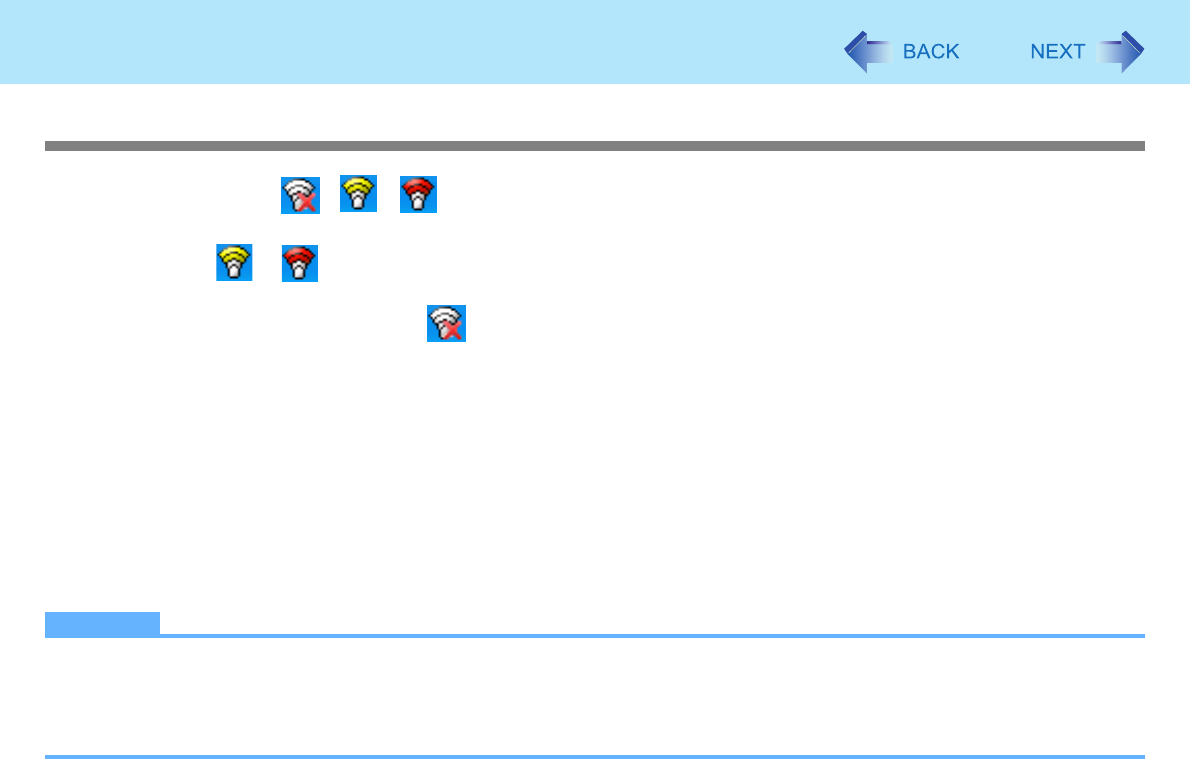
59
Wireless LAN
Setting the profiles
1Double-click / / on the notification area.
The [Intel(R) PROSet/Wireless] screen appears.
zWhen or is displayed, skip step 2.
2When you double-clicked in step 1, slide the wireless switch to turn on.
3Click [Profiles] and click [Add].
4Enter the profile name and wireless network name (SSID), and make other necessary
changes, then click [Next].
5Make necessary settings and click [OK].
6Select the profile you set and click [Connect].
7Click [Close].
NOTE
zYou need to set the profile for each user.
zThe settings depend on the network environment. For further information, ask the system administrator or the person
in charge of the network.
zFor further information of Intel® PROSet/Wireless software, refer to [Help] in the menu bar.
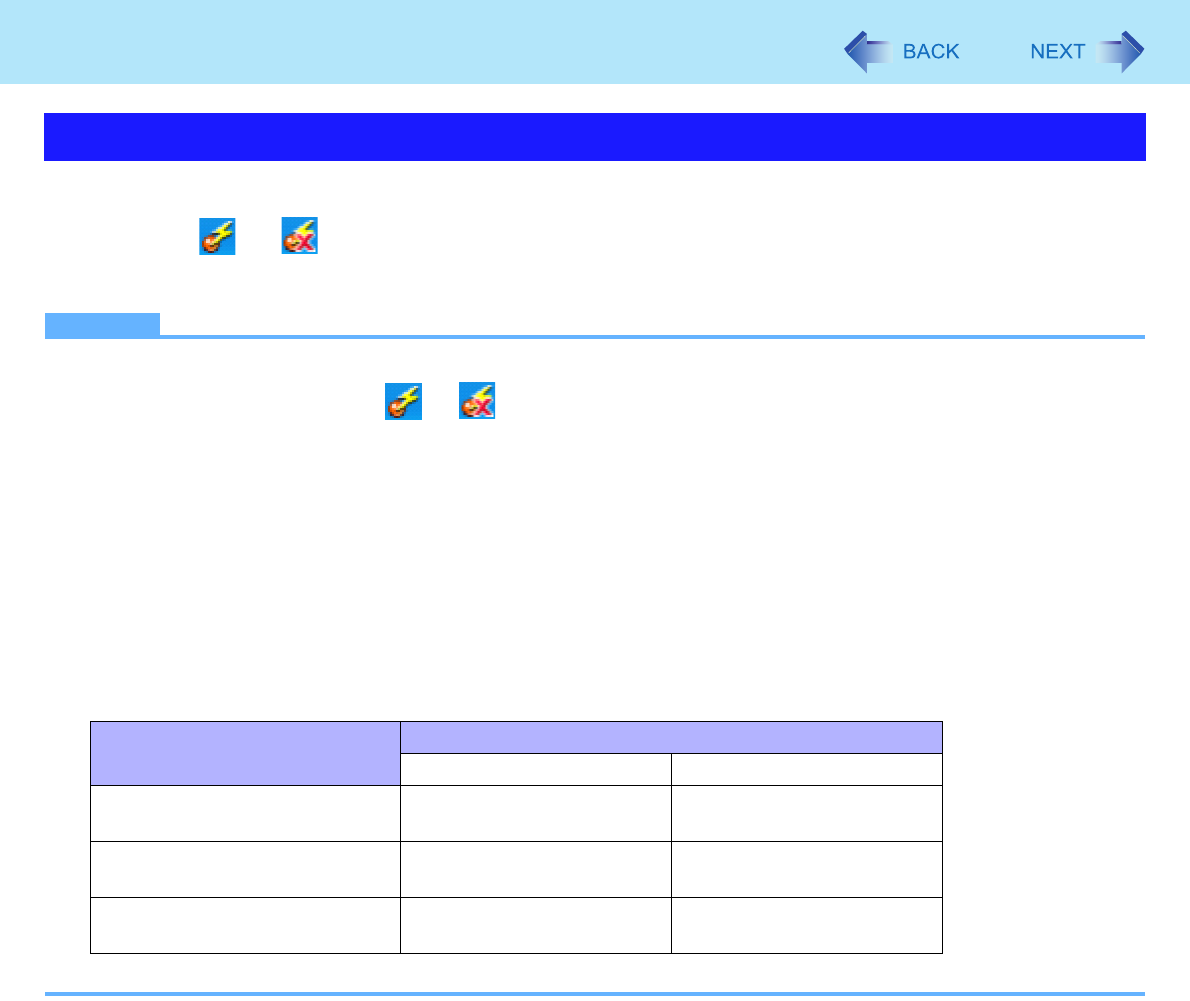
60
Wireless LAN
This section is available for countries except U.S.A. For U.S.A., do not change to [802.11a Enabled].
1Click or on the notification area.
2Click [802.11a Disabled] or [802.11a Enabled].
NOTE
zIn some countries, communication using IEEE802.11a (5 GHz wireless LAN) standard is restricted by law.
zThe Wireless Switch Utility icon ( or ) indicates the on/off status of wireless LAN and/or Bluetooth and/or
wireless WAN, not the setting of IEEE802.11a.
zIf IEEE802.11a is enabled or disabled while the computer is connected to an IEEE802.11b/g access point, the connec-
tion will be temporarily interrupted.
zYou can also change the IEEE802.11a setting in [Device Manager].
AClick [start] - [Control Panel] - [Performance and Maintenance] - [System] - [Hardware] - [Device Manager].
BClick [Network adapters] and double-click [Intel(R) Wireless WiFi Link 4965AG].
CClick [Advanced], and then click [Wireless Mode] in [Property].
DRemove the check mark from [Use default value] in [Value], and select the settings (e.g., [802.11a and 802.11g]).
EClick [OK].
If you turn on/off 802.11a using the popup menu of Wireless Switch Utility, the setting in [Device Manager] will be
accordingly changed as below.
Enabling/Disabling the Wireless LAN Standard IEEE802.11a (802.11a)
Settings in Device Manager Settings in Wireless Switch Utility
When 802.11a is enabled When 802.11a is disabled
[802.11a, 802.11b and 802.11g]
[802.11b and 802.11g] a+b+g is enabled b+g is enabled
[802.11g only]
[802.11a and 802.11g] a+g is enabled g is enabled
[802.11a only]
[802.11b only] a is enabled b is enabled
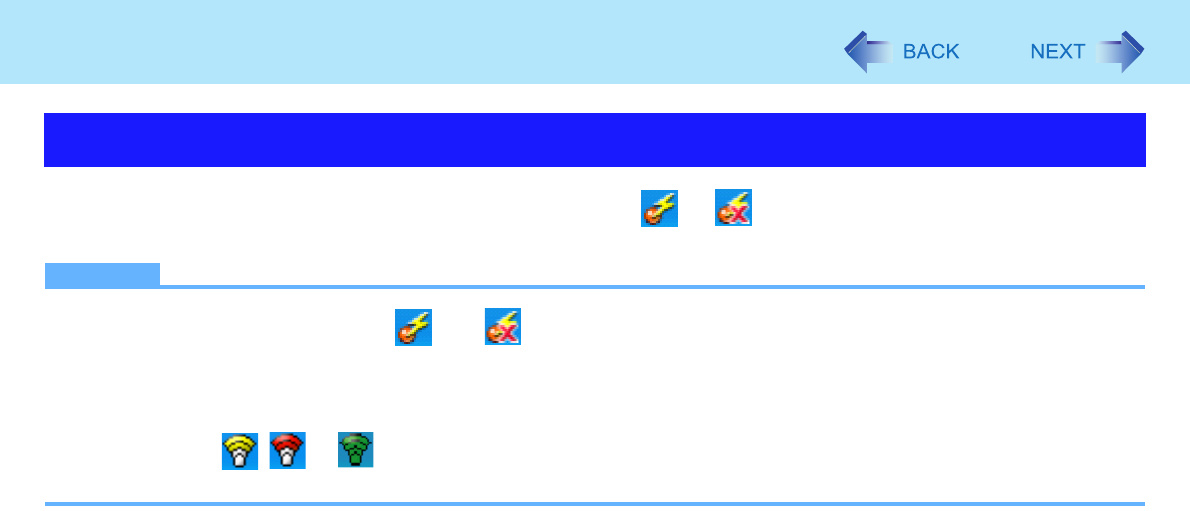
61
Wireless LAN
APlace the cursor over the Wireless Switch Utility icon ( or ) on the notification area.
A tooltip appears.
NOTE
zThe Wireless Switch Utility icons ( and ) indicate the on/off status of wireless communication, not the
IEEE802.11a setting.
zIf the setting is changed in [Device Manager], the display will be changed accordingly.
zPerform either of the following procedures to check the status in Intel® PROSet/Wireless Software.
• Double-click , or on the notification area.
• Click [start] - [All Programs] - [Intel PROSet Wireless] - [Intel PROSet Wireless].
To check the wireless LAN network status
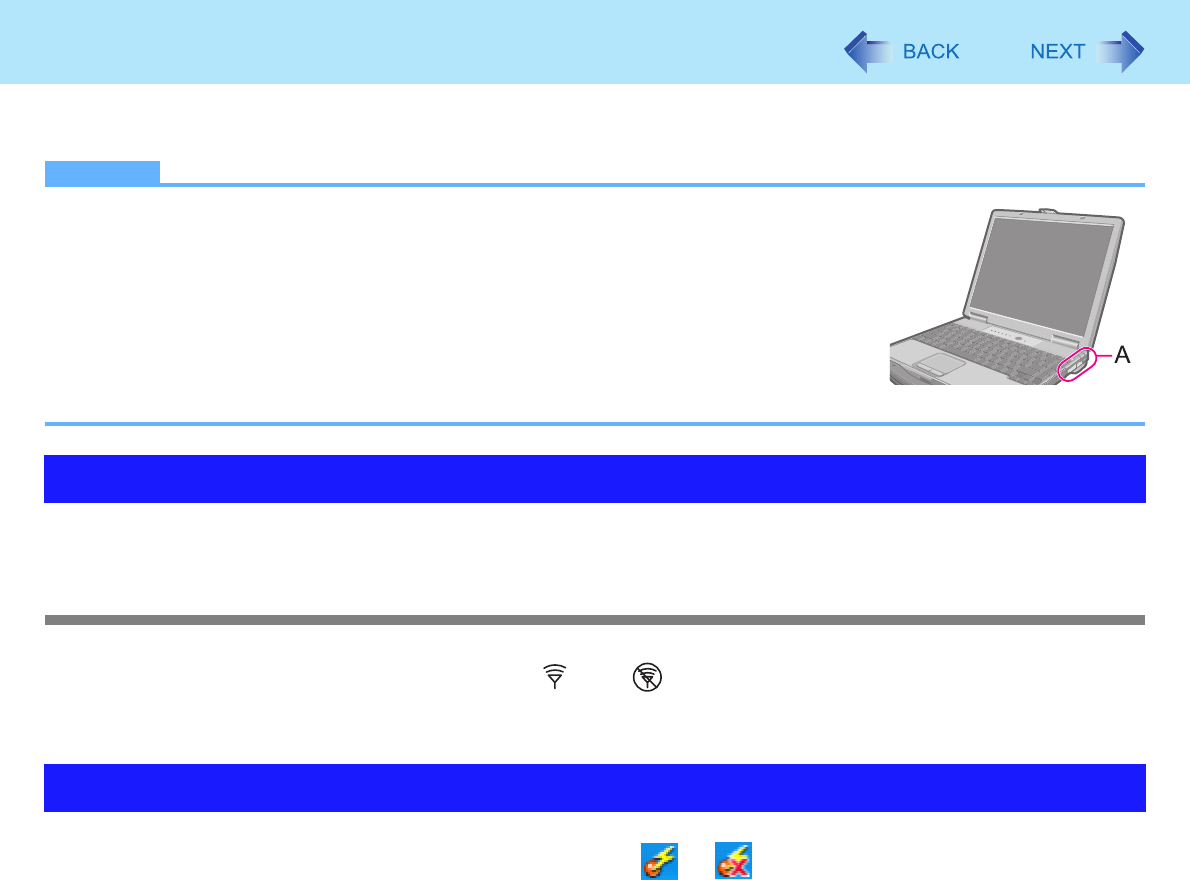
62
Bluetooth
<Only for model with Bluetooth>
You can access internet and other Bluetooth devices without connecting cables.
NOTE
zCommunication is established through the Bluetooth antenna (A). Do not block the antenna
area with your hand or body.
zTo use Bluetooth, set [Bluetooth] to [Enable] (default) in the [Advanced] menu of the Setup
Utility (Îpage 67).
zThe transmission rate will be lower when a microwave oven is used near by.
zIt may take some time to turn off Bluetooth after switching the wireless switch to off.
zWhen you uninstall the Bluetooth Driver, turn Bluetooth off.
Before using a Bluetooth, turn the Bluetooth communication on.
Turning on/off the Bluetooth communication
1Slide the wireless switch to turn on / off Bluetooth. (Îpage 56)
APlace the cursor over the Wireless Switch Utility icon ( or ) on the notification area.
A tooltip appears.
To access the online manual
AClick [start] - [All Programs] - [Bluetooth] - [User’s Guide].
Using the Bluetooth Function
To check the Bluetooth communication status
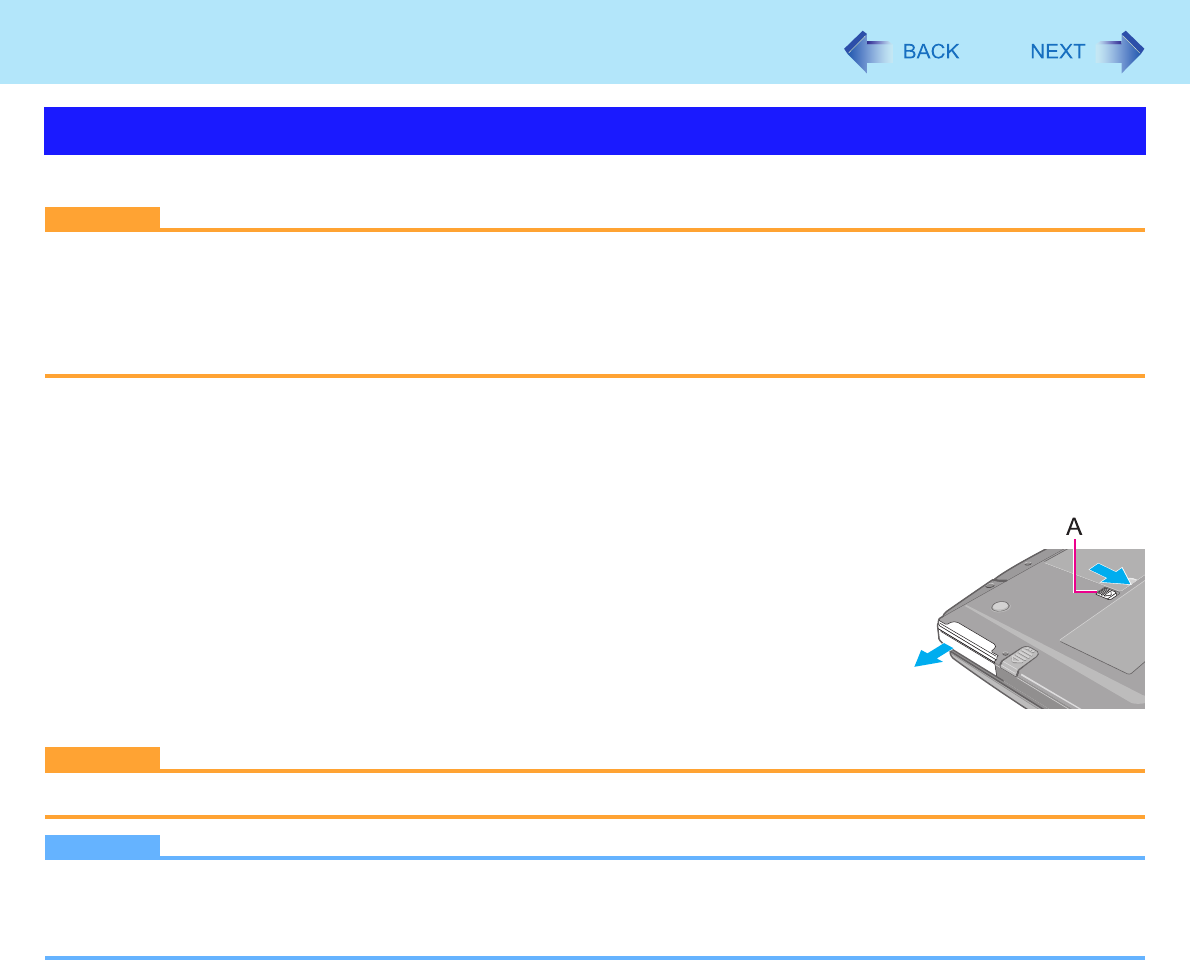
63
Hard Disk Drive
To change your hard disk drive, contact Panasonic Technical Support.
CAUTION
zBack up all the important data before removing the hard disk drive.
zIf you need to read the hard disk data on another computer for repair or any other purpose, set [Hard Disk Lock] to
[Disable] in the [Security] menu of the Setup Utility (Îpage 68) before removing the hard disk drive.
zCarefully remove/insert the hard disk drive since the hard disk drive is extremely sensitive to shock. Note that static
electricity may affect some internal components.
1Turn off the computer and disconnect the AC adaptor.
zDo not use standby or hibernation.
2Remove the battery pack (Îpage 17).
3Insert/Remove the hard disk drive.
zTo remove
Slide and hold the latch (A), and carefully slide the hard disk drive out of the slot.
zTo insert
Insert the hard disk drive until it clicks.
4Insert the battery pack (Îpage 17).
CAUTION
zConfirm that the hard disk drive is surely locked so that it does not fall when you carry the computer.
NOTE
zYou can erase the data before changing the hard disk drive. (⇒ Operating Instructions “Hard Disk Data Erase Utility”)
zYou can check that the hard disk is recognized or not in the [Information] menu of the Setup Utility (Îpage 65). If the
hard disk is not recognized, turn off the computer and insert it again.
Inserting/Removing the Hard Disk Drive

64
Setup Utility
You can make the settings of the computer’s operating environment (password settings, startup drive selection, etc.)
1Turn on or restart the computer.
2Press
F2
several times while [Panasonic] boot screen is displayed soon after the com-
puter starts the startup procedure.
When [Enter Password] is displayed, enter your password.
When you start the Setup Utility with Supervisor Password
zYou can make the settings of all items of the Setup Utility.
When you start the Setup Utility with User Password
zNote the following:
• In the [Advanced] and [Boot] menus, you cannot make the settings of all items.
• In the [Security] menu, you can change only the User Password when [User Password Protection] is set to
[No Protection]. You cannot delete the User Password.
• In the [Exit] menu, you cannot make the setting of [Get Default Values] and [Load Previous Values].
•
F9
(Setup Defaults) does not function.
Starting the Setup Utility
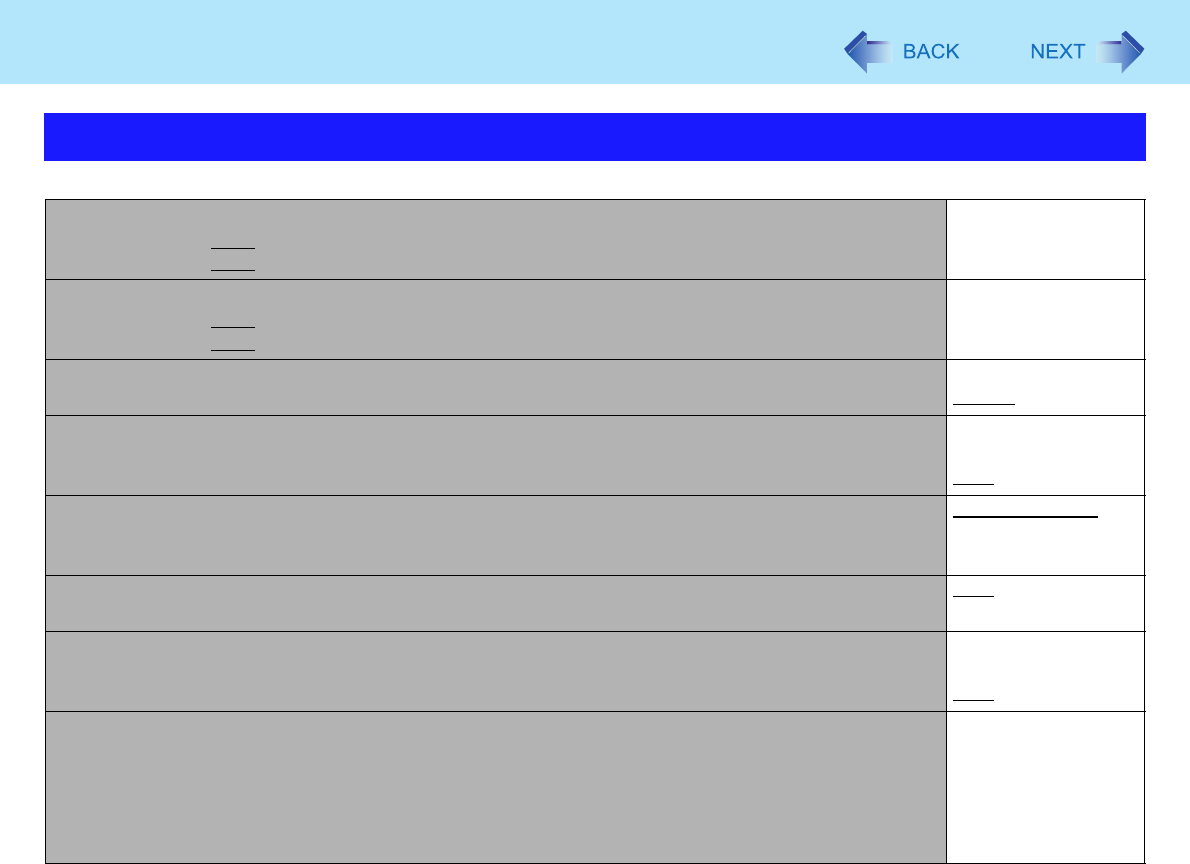
66
Setup Utility
Underlined items are the factory presets.
Main Menu
System Time
• 24-hr. style.
• You can use
Tab
to move the cursor.
[xx:xx:xx]
System Date
• Month/Day/Year.
• You can use
Tab
to move the cursor.
[xx/xx/xxxx]
Touch Pad Disable
Enable
Touchscreen Mode
• Only for model with touchscreen
Touchscreen Mode
Tablet Mode
Auto
Display
• The display during the Windows start-up process. When an external display is not connected,
the information appears on the internal LCD even though the [External Monitor] is selected.
External Monitor
Internal LCD
DVD Drive Speed High
Low
Environment Normal Temperature
High Temperature
Auto
Current Status
• Only when [Environment] is set to [Auto].
Depending on the
battery status, either
“Normal
Temperature” or
“High Temperature”
is displayed.
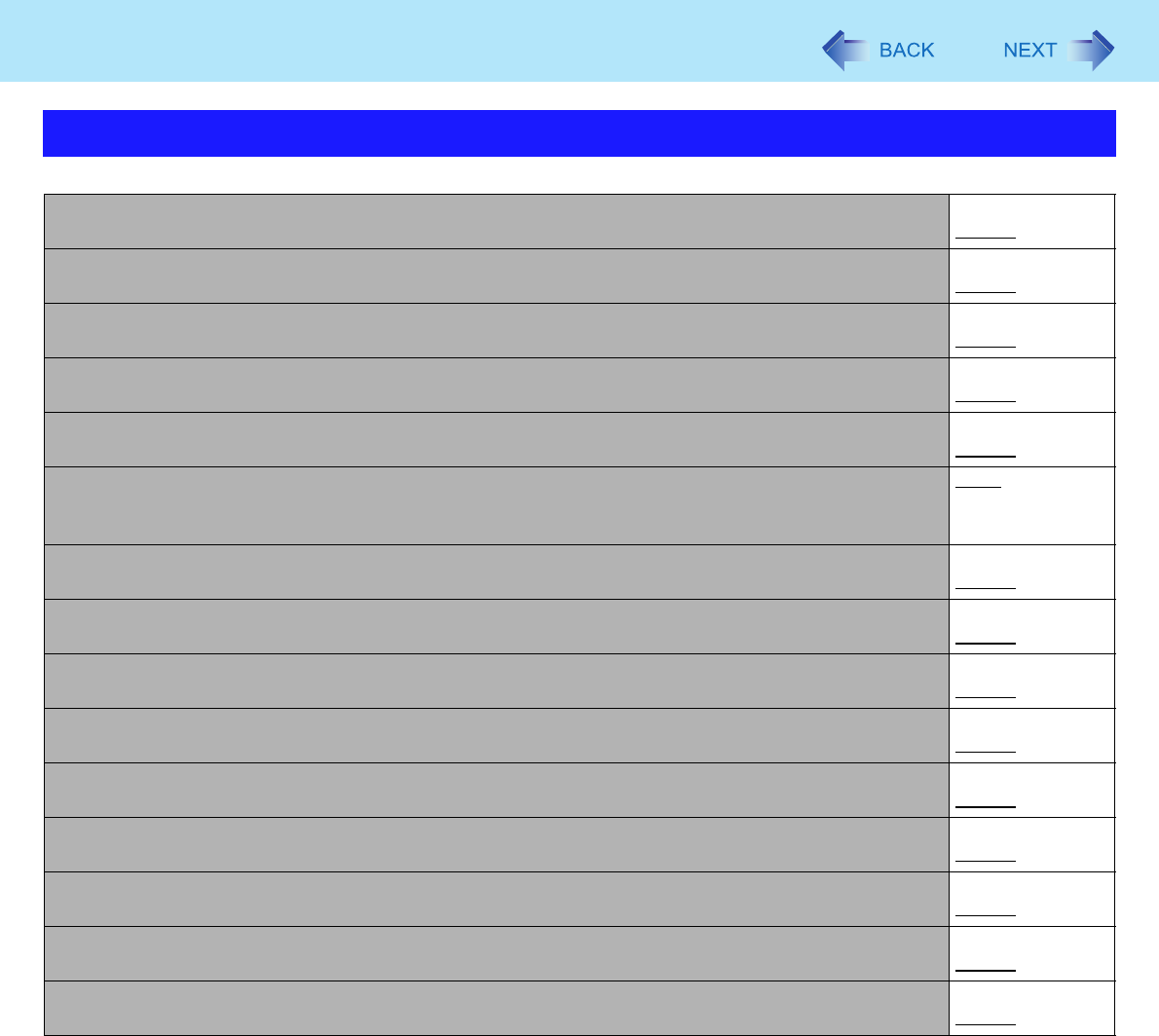
67
Setup Utility
Underlined items are the factory presets.
Advanced Menu
Core Multi-Processing Disable
Enable
Intel(R) Virtualization Technology Disable
Enable
Serial Port Disable
Enable
Modem Disable
Enable
LAN Disable
Enable
Power On by LAN
• Can be changed only when [LAN] is set to [Enable].
• To use [Power On by LAN], make additional settings in [Device Manager] (Îpage 53)
Deny
Allow
Wireless LAN
• Only for model with wireless LAN
Disable
Enable
Wireless WAN
• Only for model with wireless WAN
Disable
Enable
Bluetooth
• Only for model with Bluetooth
Disable
Enable
PC Card Slot Disable
Enable
ExpressCard Slot Disable
Enable
SD Slot Disable
Enable
Smart card
• Only for model with Smart Card slot
Disable
Enable
USB Port Disable
Enable
Legacy USB Support
• Can be changed only when [USB Port] is set to [Enable].
Disable
Enable
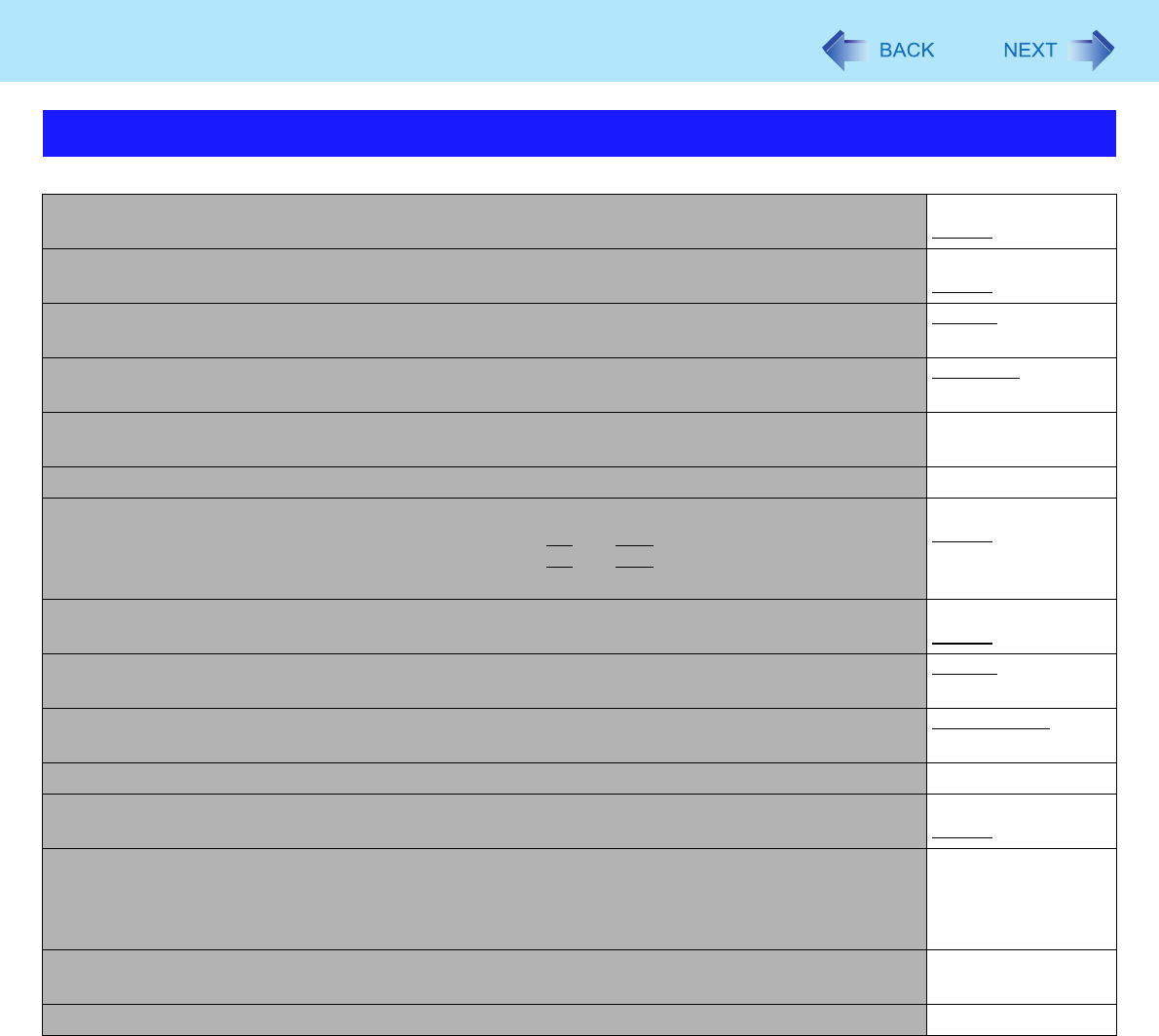
68
Setup Utility
Underlined items are the factory presets.
Security Menu
Execute-Disable Bit Capability
• [Enable] indicates that this computer supports hardware-based Data Execution Prevention (DEP).
Disable
Enable
Password on boot Disable
Enable
SD Startup
• Only when [Password on boot] is set to [Enable] and one or more SD card is registered
Disable
Enable
SD Setting Method
• Only when [SD Startup] is set to [Enable]
Leave Set
Set and Eject
XClear registered SD card
• Only when one or more SD card is registered
Enter the sub-menu.
XSet Supervisor Password Enter the sub-menu.
Setup Utility Prompt
• When [Setup Utility Prompt] is set to [Disable], the message “Press F2 for Setup / F12 for LAN” is
not displayed on [Panasonic] boot screen. However,
F2
and
F12
will work even if the message
is not displayed.
Disable
Enable
Boot First Menu Disable
Enable
Hard Disk Lock Disable
Enable
User Password Protection No Protection
Protected
XSet User Password Enter the sub-menu.
DVD Operation Disable
Enable
XEmbedded Security (TPM) Sub-Menu
• Only for model with TPM
• For information on TPM, refer to the Installation Manual of “Trusted Platform Module (TPM)”.
Click [start] - [Run] and input [c:\util\drivers\tpm\readme.pdf], and click [OK].
Enter the sub-menu.
XFingerprint Security Sub-Menu
• Only for model with Fingerprint Reader
Enter the sub-menu.
XComputrace (R) Sub-Menu Enter the sub-menu.
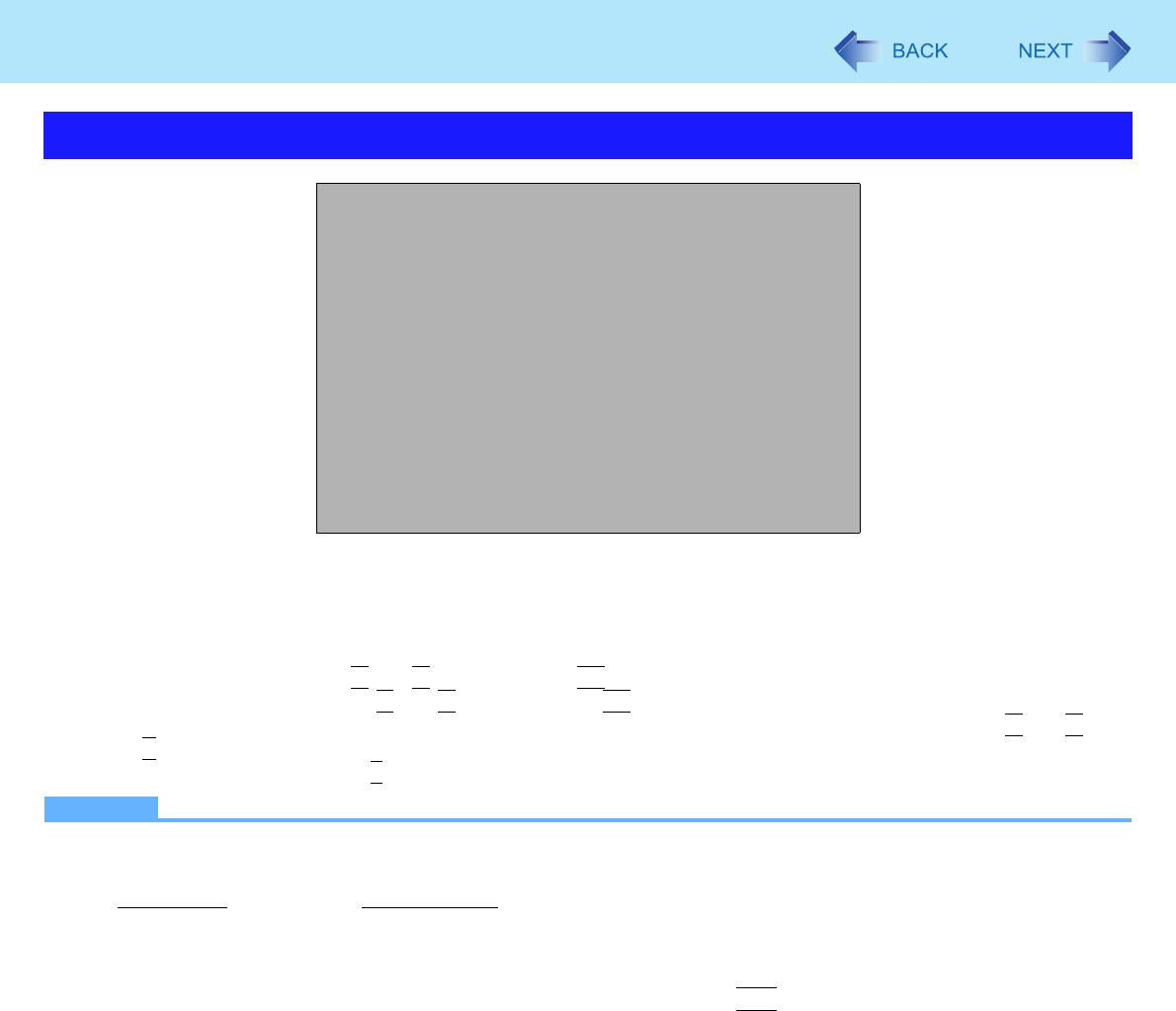
69
Setup Utility
*1 Use the Panasonic USB floppy disk drive (optional: CF-VFDU03)
*2 The devices under [Excluded from boot order] are not booted.
To change the boot order
To move up, select the device with Ï and Ð, and then press
F6
.
To move down, select the device with Ï and Ð, and then press
F5
.
To move the device from [Excluded from boot order] to [Boot priority order] or vice versa, select the device with Ï and Ð, and
then press
X
.
To return to the default setting, press
1
.
NOTE
zThe default order is [USB FDD] -> [Hard Disk] -> [Optical Drive] -> [PCI LAN].
zTo boot from the following devices, make the settings as below.
zYou can select the boot device during start-up of the computer, too. Press
Esc
soon after [Panasonic] boot screen is
displayed. [Boot Menu] appears and you can select the device. [Boot Menu] appears only when [Boot First Menu] in
Boot Menu
Boot priority order:
1: USB FDD:*1
2: Hard Disk: xxxxxxxxxx
3: Optical Drive: xxxxxxxxxx
4: PCI LAN: xxxxxxxxxx
5:
6:
7:
8:
Excluded from boot order:*2
: USB KEY
: USB HDD
: USB LS120
: USB CDD
To boot from You need to set
• USB connected device : [USB Port] and [Legacy USB Support] to [Enable] (Îpage 67)
• LAN : [LAN] to [Enable] (Îpage 67)
• Multimedia pocket device : [DVD Operation] to [Enable] (Îpage 68)
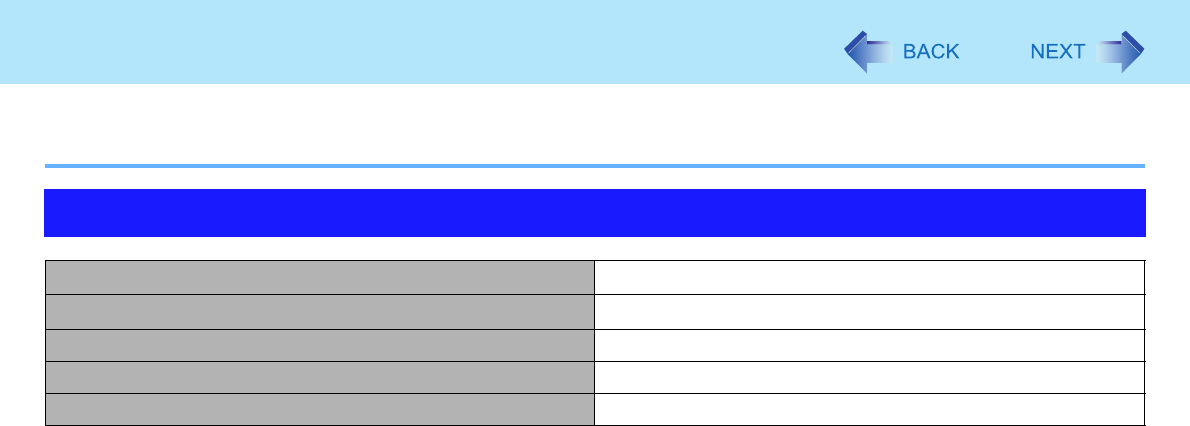
70
Setup Utility
the [Security] menu is set to [Enable] (Îpage 68). When you change the setting in the [Boot] menu, [Boot Menu] will
be changed accordingly.
Exit Menu
Save Values & Exit To save the changes to CMOS and reboot.
Exit Without Saving Changes To exit without saving the changes to CMOS.
Get Default Values To return the settings to the default values.
Load Previous Values To load the previous values from CMOS.
Save Current Values To save the changes to CMOS.
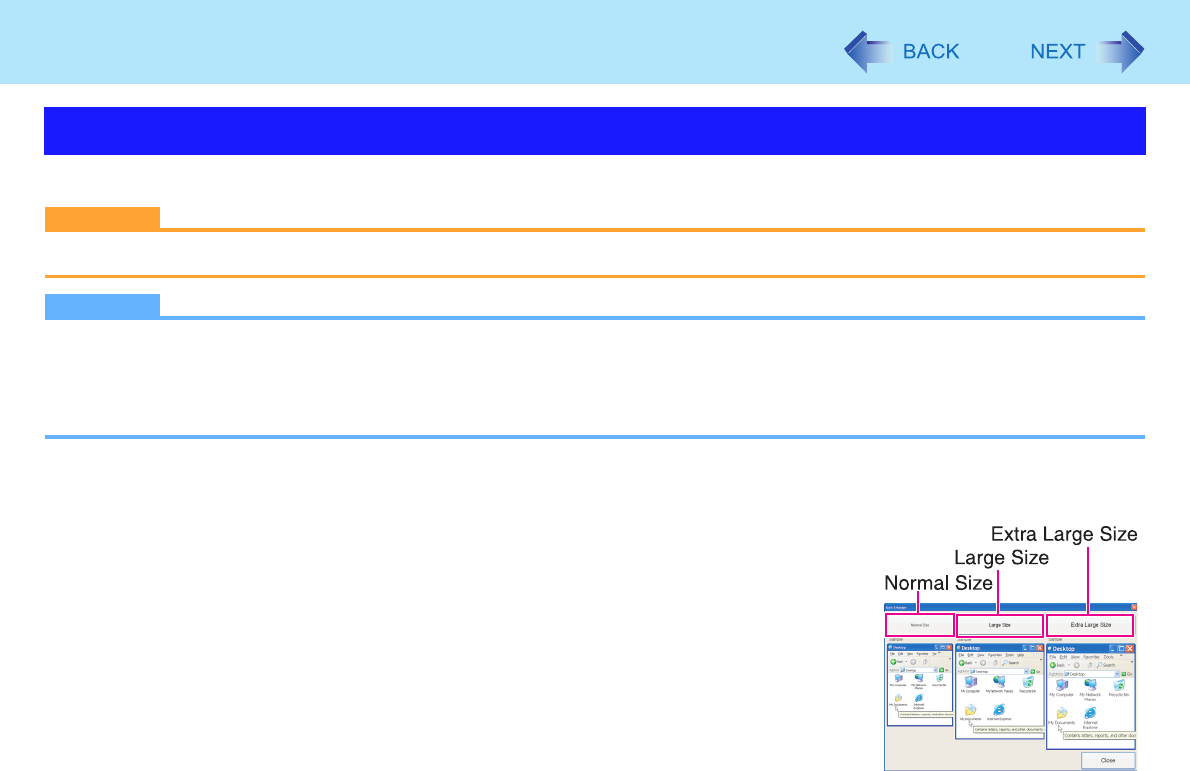
71
Icon Enlarger
You can enlarge the screen items such as characters, icons, title bars and mouse cursor.
CAUTION
z“Icon Enlarger” will not start up if the display resolution is set lower than 1024 x 768 dots.
NOTE
zA part of the enlarged menu or some screen items may be hidden. In this case, overlay the cursor to display pop-ups,
scroll the screen, or use other functions to display the hidden items.
zThe Icon Enlarger setting affects the website characters displayed by Internet Explorer and the e-mail characters in
Outlook Express. Some characters of website and e-mail may not be enlarged.
Preparation
Close all of the applications before using “Icon Enlarger”.
1Click [start] - [All Programs] - [Panasonic] - [Icon Enlarger].
2Select the size.
3Click [OK].
The screen will be displayed in the selected size.
Enlarging the screen items
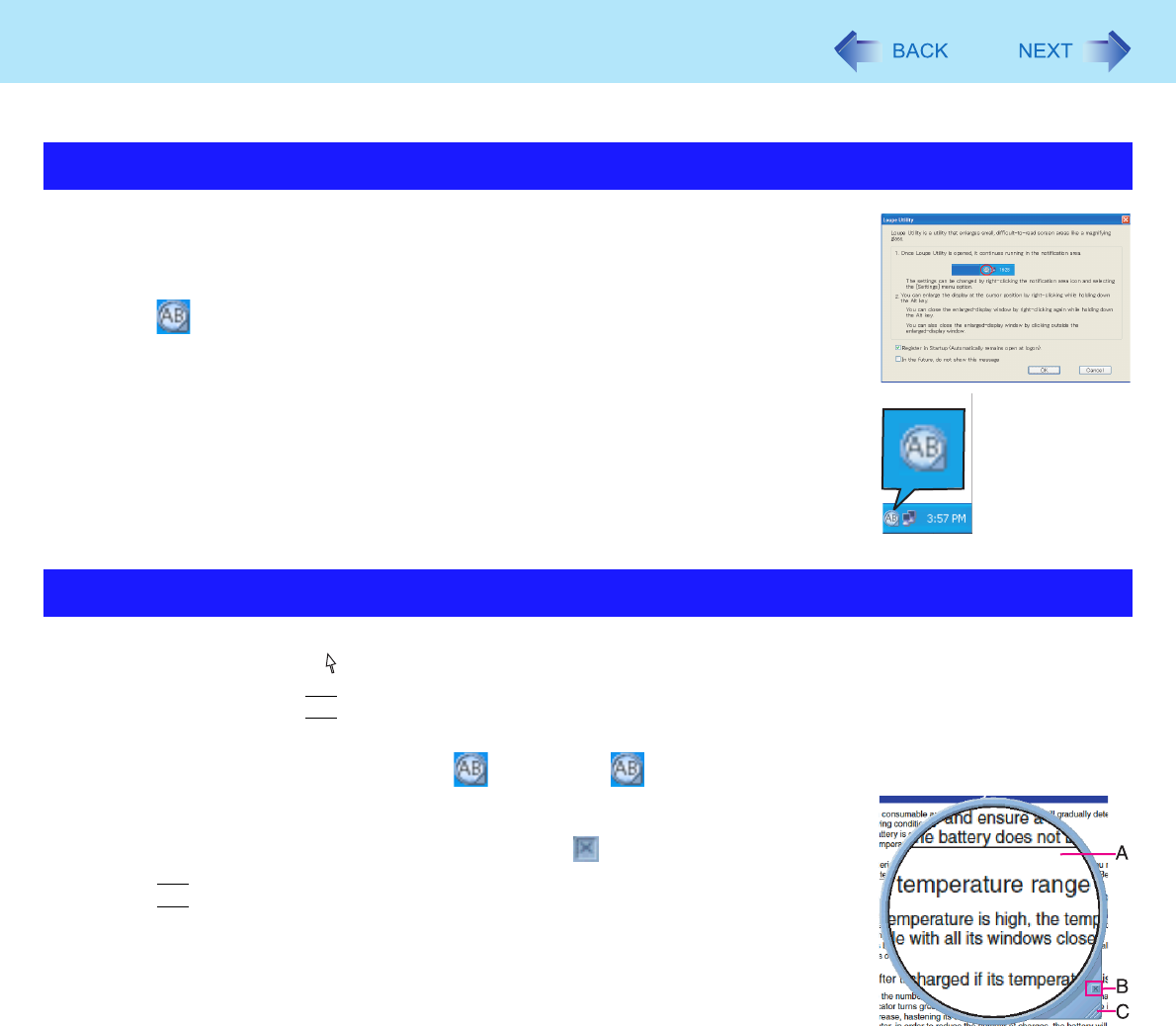
72
Loupe Utility
You can magnify the specific part of the screen.
1Click [start] - [All Programs] - [Panasonic] - [Loupe Utility].
2Click [OK].
z appears on the notification area.
1Point the cursor at the part of the screen you want to magnify.
2Press and hold
Alt
, and right-click.
zThe part pointed by the cursor is magnified.
zAlternatively you can double-click , or right-click and click [Show Loupe].
3Drag the loupe window (A) to move the magnified part.
zTo hide the loupe window, click the Hide button (B).
Alternatively you can click any part out of the loupe window, or press and hold
Alt
and right-click.
zTo change the loupe window size, drag the bottom-right corner (C).
The size range you can enlarge/shrink depends on the screen’s resolution.
Activating the Loupe Utility
Using the Loupe Utility
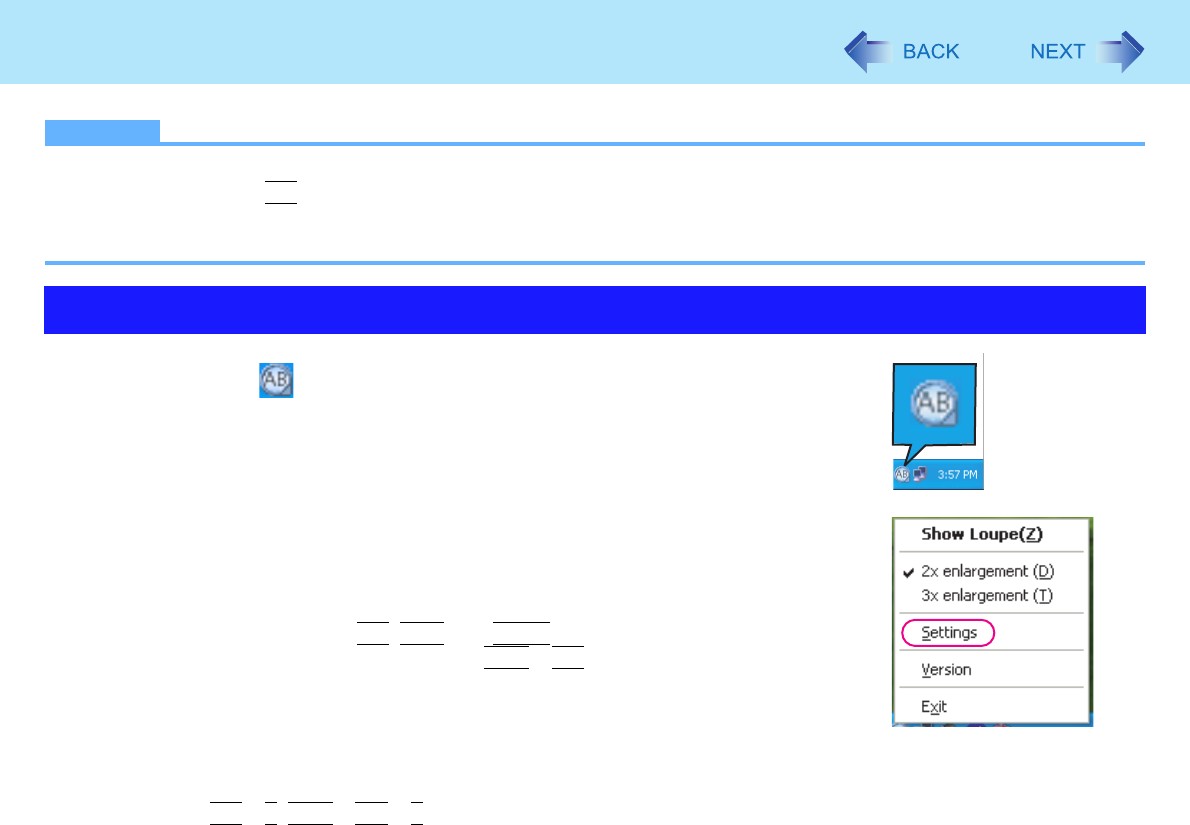
73
Loupe Utility
NOTE
zThe magnified text or image in the loupe window is fixed at the moment that the part is magnified (e.g., at the moment
you press and hold
Alt
and right-click). To reflect the change you made on the original screen to the loupe window,
click the loupe window.
zThe Loupe Utility does not work with some applications.
1Right-click on the notification area.
2Click [Settings].
[Show/hide shortcuts assignment]
zWhen using the external mouse/touch pad
AClick [Mouse/Touch pad]
BClick a combination of
Alt
,
Ctrl
, and
Shift
, and add the check mark. (Multiple
keys can be combined; for example,
Ctrl
+
Alt
)
CSelect either [Right click] or [Left Click] to use in combination with the key(s)
selected in B above.
zWhen using the keyboard
AClick [Keyboard].
BClick the text box and then press the key used for the shortcut.
(e.g.,
Alt
+
Z
,
Ctrl
+
Alt
+
Z
, etc.)
[Window shape]
Select the shape of the loupe window.
[Autorun]
Add a check mark to run the Loupe Utility when Windows starts up.
[Restore Defaults]
Click to restore the default settings.
3Click [OK].
Setting the Loupe Utility

74
DMI Viewer
This computer conforms to the specifications of the Desktop Management Interface (DMI). You can use the DMI Viewer to
access the computer’s information including the CPU, memory and supported system.
1Click [start] - [All Programs] - [Panasonic] - [DMI Viewer].
The DMI Viewer screen appears.
2Click the item to display the detailed information.
To save the information as a text file
ATo save the item that is displayed
Click [File] - [Save Selected Data...] .
To save all items
Click [File] - [Save All Data...].
BSelect the folder, input the file name, then click [Save].

75
Recover Pro
Recover Pro is a data backup software application developed by Phoenix Technologies Ltd. It provides 3 types of backup as
follows:
• Quick Backup: Scheduled backup of the updated data
• File Backup: File backup at file save and change
• Complete Backup: Backup of the entire data on the internal hard disk
For further information, refer to the software’s online manual.
1Log on to Windows as an administrator.
2Close all the applications.
zDisable antivirus software
3Click [start] - [Run] and input [c:\util\rcvpro\setup.exe], and click [OK].
Follow the on-screen instructions.
zAfter the computer restarts, Recover Pro starts initialization. Do not touch keys or switch including hot key, during
initialization until an instruction message appears.
CAUTION
zBe sure to use the internal hard disk drive to create the backup area. Never use disk or device other than the internal
hard disk drive.
zSome software (security software, backup software, encryption software, or hard disc accessible specific software,
etc.) may be incompatible with Recover Pro.
For further information, refer to:
http://www.phoenix.com/en/Customer+Services/White+Papers-Specs/Recover+Pro/default.htm
zWhen using Personal Secure Drive (refer to the Installation Manual of “Trusted Platform Module (TPM)”), do not exe-
cute File Backup for Personal Secure Drive.
NOTE
zIf you select [Typical] in installation, approximately 40% (max.) of the hard disk drive space is allocated as the backup
area.
zYou cannot change the size of backup area after creation.
To access the online manual
AClick [start] - [All Programs] - [Phoenix Applications] - [Docs], and double-click [UserGuides].
BDouble-click the file of Recover Pro user’s guide or Phoenix Always user’s guide.
Installing Recover Pro

76
Technical Information
Close the communications software before using the power saving function.
zIf the power saving function (standby or hibernation) is activated while communications software is used, the network con-
nection may be interrupted, or the performance may be adversely affected. In this case, restart the computer.
zIn a network environment, set the [System standby] and [System hibernates] settings to [Never].
Click [start] - [Control Panel] - [Performance and Maintenance] - [Power Options] - [Power Schemes].
The Windows files included in the retail version of the Windows CD-ROM for OS are contained in the following folders:
c:\windows\docs, c:\windows\dotnetfx, c:\windows\i386, c:\windows\support, c:\windows\valueadd
Network Connections and Communications Software
Using the Windows Associated Files
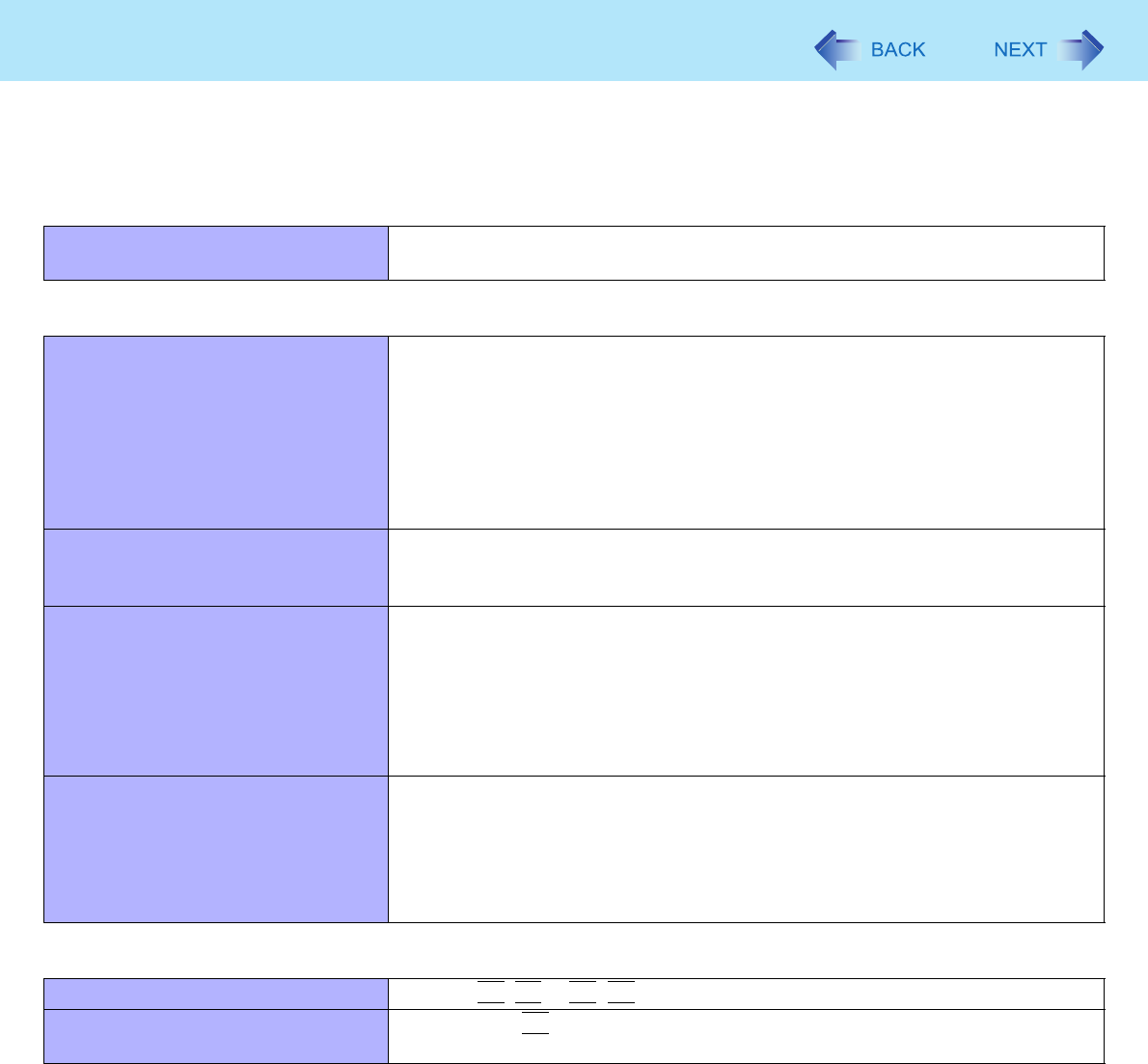
77
Troubleshooting (Advanced)
Refer to the following instructions when a problem occurs. If the remedies indicated in the chart do not solve the problem,
contact Panasonic Technical Support. For a software problem, refer to the instruction manual of the software.
• To check the computer’s usage status (Îpage 85).
Shut Down
Cannot shut down or restart Windows. zRemove USB devices.
zIt may take one or two minutes to shut down.
Standby/Hibernation
Cannot enter standby or hibernation. zRemove USB devices temporarily. If the problem persists, restart the computer.
zIt may take one or two minutes to enter standby or hibernation.
zThe computer may not enter standby when the computer is communicating via
modem.
zThe computer does not enter standby or hibernation immediately after resum-
ing. Wait approximately one minute.
zWhen a disc formatted using B’s CLiP is in the DVD drive, the computer will not
enter standby or hibernation. Remove the disc.
Cannot enter standby or hibernation
automatically.
zDisconnect peripheral devices.
zWhen a disc formatted using B’s CLiP is in the DVD drive, the computer will not
enter standby or hibernation. Remove the disc.
The computer does not resume. zIf you press and hold the power switch for four seconds or longer, the power will
be turned off forcibly and the computer will not resume. In this case, all unsaved
data will be lost.
zYou disconnected the AC adaptor and the battery pack while the computer was
in standby mode. If the computer’s power supply is disconnected in standby
mode, unsaved data will be lost and the computer will not resume.
zThe battery is exhausted. Standby and hibernation consume some power.
The computer will not automatically
enter standby/hibernation mode.
zIf you connect to a network using wireless LAN function, select the profile and
connect to the access point(Îpage 59).
zIf you do not use wireless LAN function, turn off wireless LAN function(Îpage
58).
zMake sure that you are not using any software that regularly accesses the hard
disk.
Sound
No sound. zPress
Fn
+
F4
or
Fn
+
F6
to cancel mute.
Distorted sound. zPerforming
Fn
key combinations sometimes causes sound distortion. Stop and
restart playback.
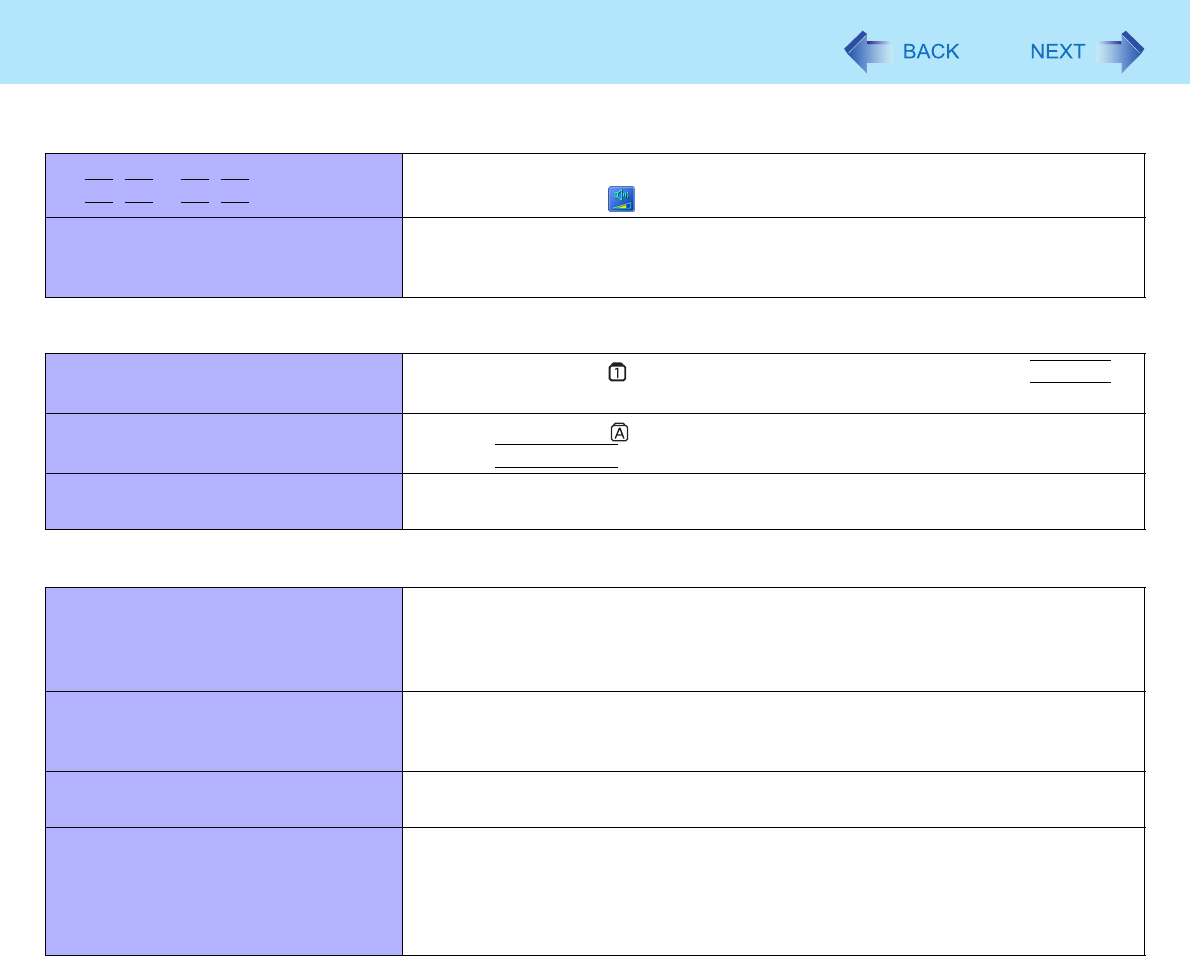
78
Troubleshooting (Advanced)
Cannot change the volume by press-
ing
Fn
+
F5
or
Fn
+
F6
.
zActivate the Windows sound function. When it is not active, the volume does
not change even if is displayed.
“There was an error updating the reg-
istry” appears when Sound Recorder
is started.
zSound Recorder is started by a limited account user whose language setting is
not the same as the administrator user who last started Sound Recorder. This
does not affect the operation.
Keyboard
Only numbers can be input. zWhen the indicator is on, the keyboard is in ten-key mode. Press
NumLk
to
cancel.
Only capital letters can be input. zWhen the indicator is on, the keyboard is in Caps Lock mode.
Press
Caps Lock
to cancel.
Cannot enter special characters (ß, à,
ç, etc.) and symbols.
zUse the character map. Click [start] - [All Programs] - [Accessories] - [System
Tools] - [Character Map].
Disc Operation
The DVD drive does not work nor-
mally.
zSet [DVD Operation] to [Enable] in the [Security] menu of the Setup Utility
(Îpage 68).
zClean the lens (Îpage 21).
zCheck the disc condition (Îpage 22).
Cannot play back TV programs
recorded on a commercial DVD
recorder.
zFinalize the disc on the DVD recorder when the program was recorded in video
mode on DVD-R/RW or in VR mode on DVD-RW.
A blue background appears on the
screen when playing a MPEG image.
zYou opened the DVD drive or removed the MPEG disc while it was operating.
Re-insert the MPEG disc and close the DVD drive.
The DVD drive vibrates excessively or
makes noise.
zInsert the disc correctly.
zCheck the disc condition (Îpage 22).
zSet [DVD Drive Speed] to [Low] in the [Main] menu of the Setup Utility (Îpage
66).
zWhen writing to a CD using B’s Recorder, set the writing speed at [8x] or less.
Sound
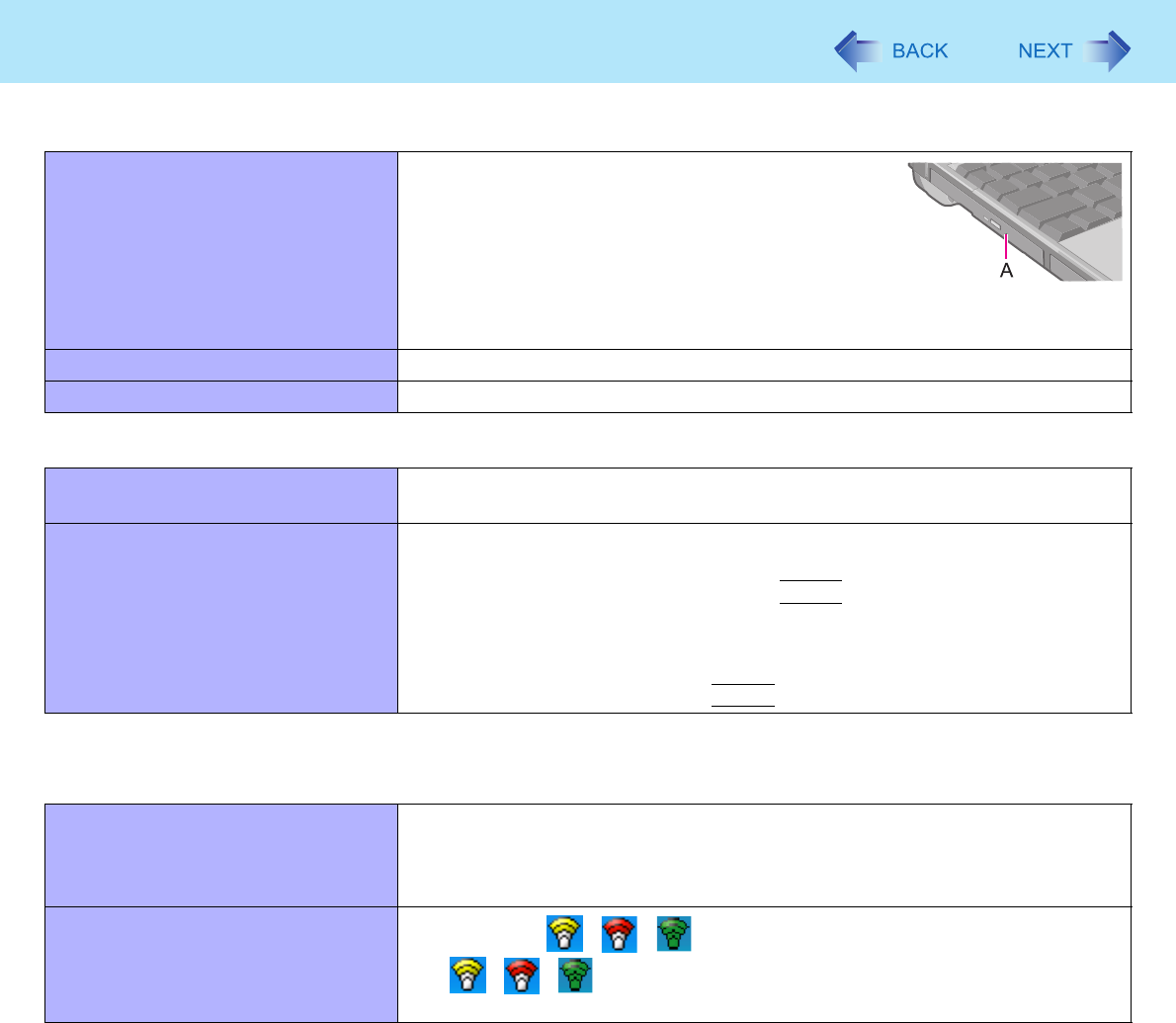
79
Troubleshooting (Advanced)
Cannot eject a disc. zTurn on the computer.
To remove a disc when the computer is powered
off, insert a pointed object (e.g., the bent-out tip of
a paper clip, or the tip of a pencil or ballpoint pen)
into the emergency hole (A). Pushing it completely
to the end will free the tray so that it can be pulled
out. (The position of the emergency hole differs
depending on the drive.)
The disc tray does not close. zDo not touch the eject button when closing the tray.
Other disc operation problems. zUse another drive or media.
Network
Cannot connect to network. zSet [LAN] / [Modem] to [Enable] in the [Advanced] menu of the Setup Utility
(Îpage 67).
Cannot check the computer’s MAC
address.
zFollow the steps below.
AClick [start] - [All Programs] - [Accessories] - [Command Prompt].
BInput [ipconfig /all], and press
Enter
.
CWrite down the 12-digit string of alphanumeric displayed in the
“Physical Address” line of the LAN or the wireless LAN (only for model
with wireless LAN).
DInput [exit], and press
Enter
.
Wireless Communication (Only for model with wireless LAN/Bluetooth/wireless
WAN)
Cannot connect to network. zSlide the wireless switch to turn on the wireless devices.
zSet the device ([Modem] / [Wireless LAN] / [Bluetooth] / [Wireless WAN]) to
[Enable] in the [Advanced] menu of the Setup Utility (Îpage 67).
zRestart the computer.
Access point is not detected. zConfirm that / / is displayed on the notification area.
If / / is not displayed on the notification area, turn on the wireless
communication.
Disc Operation
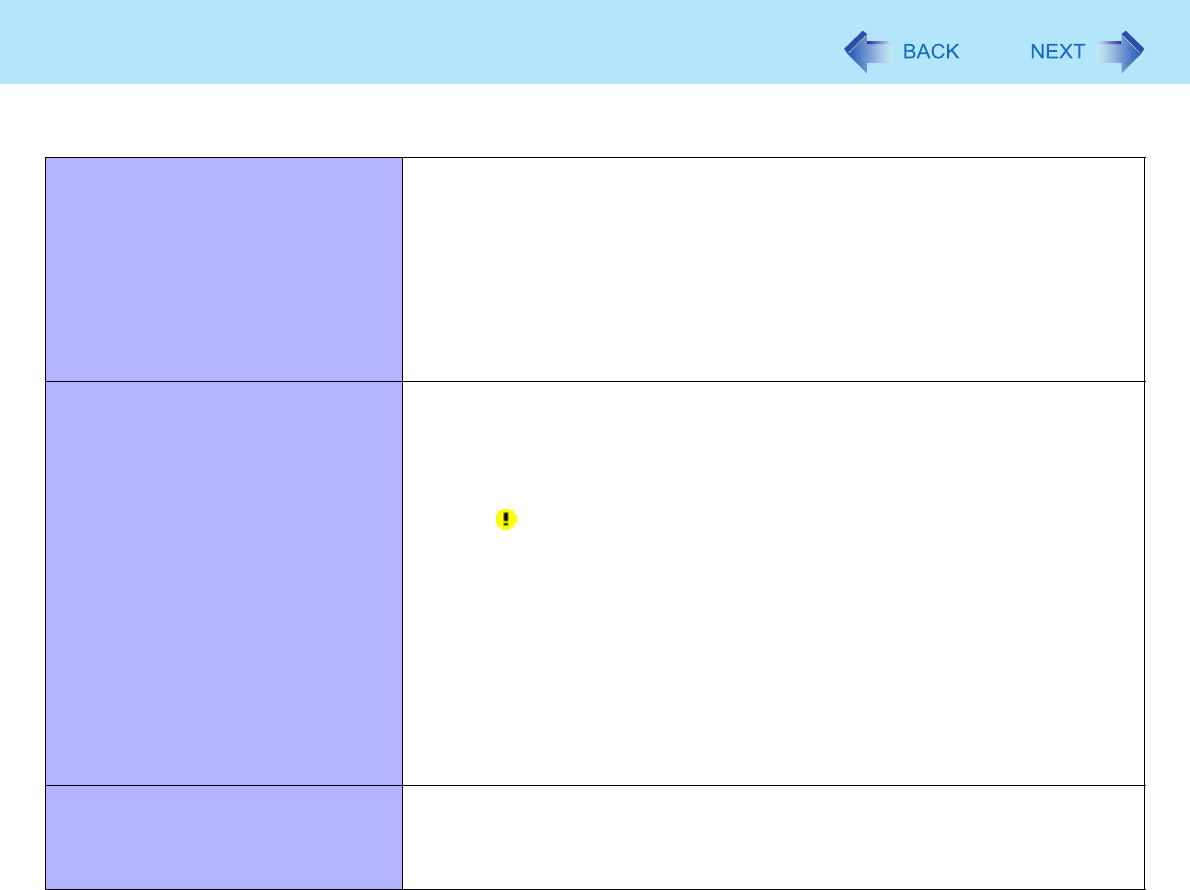
80
Troubleshooting (Advanced)
Connecting Peripherals
An error occurs while installing the
driver.
zWhen you install a driver of card or peripheral device, make sure that the driver
is compatible with the operating system. If it is not compatible, malfunction may
occur. For information about the driver, contact the manufacturer of the periph-
eral device.
zBefore connecting peripheral equipment, first determine the media that
contains the peripheral device’s driver (e.g., CD-ROM), then attach the device
for that media to the multimedia pocket. Once the installation screen for the
device’s driver appears, equipment you then connect to the multimedia pocket
will not be recognized.
A peripheral device does not work. zInstall the driver.
zContact the manufacturer of the device.
zWhen operation resumes from standby or hibernation, devices such as a
mouse, modem and PC Card may not function properly. In this case, restart the
computer or reinitialize the device.
zWhen is displayed in the Device Manager, remove and insert the device. If
the problem persists, restart the computer.
zWhen you set [USB Port] to [Disable] in the [Advanced] menu of the Setup Util-
ity (Îpage 67), USB ports of mini port replicator are also disabled.
zThe computer may not recognize the connection/removal of some devices, or
may not operate normally with some devices.
AClick [start] - [Control Panel] - [Performance and Maintenance] -
[System] - [Hardware] - [Device Manager].
BSelect the device and remove the check mark for [Allow the computer
to turn off this device to save power] in [Power Management]. (This
item may be unavailable for some types of devices.)
The connected mouse does not work. zCheck the mouse connection.
zInstall the driver compatible with the connected mouse.
If the mouse does not work even after installing the driver, set [Touch Pad] to
[Disable] in the [Main] menu of the Setup Utility (Îpage 66).

81
Troubleshooting (Advanced)
USB floppy disk drive does not work
as a boot drive.
zYou can use only the Panasonic CF-VFDU03 USB floppy disk drive (optional).
zConnect the floppy disk drive directly to a USB port of the computer. Do not
connect it via a USB hub or USB connector of the mini port replicator.
zSet [USB Port] and [Legacy USB Support] to [Enable] in the [Advanced] menu
of the Setup Utility (Îpage 67).
zMove up [USB FDD] to the top of [Boot priority order] in the [Boot] menu of the
Setup Utility (Îpage 69).
zTurn off the computer and connect the USB floppy disk drive, and then restart
the computer.
The RAM module is not recognized. zInsert the RAM module correctly.
zUse the compatible RAM module (Îpage 43).
zCheck the [Information] menu in the Setup Utility (Îpage 65). If the RAM mod-
ule is not recognized, turn off the computer and reinsert the RAM module.
You do not know the address map for
IRQ, I/O port address, etc.
zTo check the current address map, click [start] - [Control Panel] - [Performance
and Maintenance] - [System] - [Hardware] - [Device Manager] - [View] -
[Resources by type].
The device connected to the serial port
does not work.
zCheck the connection.
zThe device driver may not work. Refer to the instruction manual of the device.
zDo not connect two mouse devices simultaneously.
zSet [Touch Pad] to [Disable] in the [Main] menu of the Setup Utility (Îpage
66).
zSet [Serial Port] to [Disable] in the [Advanced] menu of the Setup Utility
(Îpage 67).
Cannot print. zCheck the printer connection.
zTurn on the printer.
zThe printer is not online.
zNo paper is in the printer tray or there is a paper jam.
zTurn on the printer and connect it to the computer, and then restart the com-
puter.
zCheck the network connection if the printer is connected via network.
Connecting Peripherals
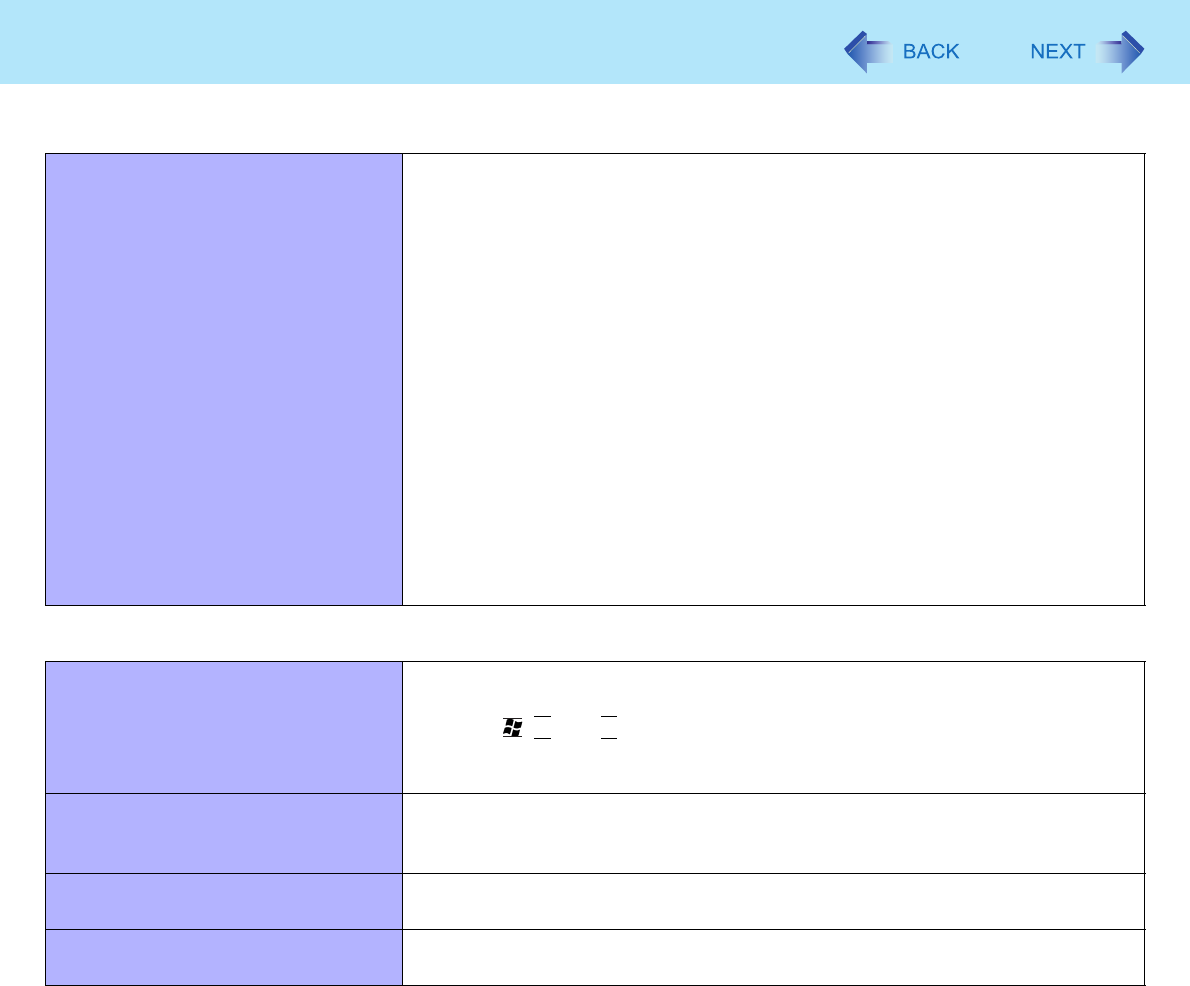
82
Troubleshooting (Advanced)
LAN transmission speed slows down
noticeably.
Poor performance during data trans-
mission via a PC Card (e.g., distorted
video image when writing to a DV
camera using an IEEE1394 PC Card).
<Only for model with wireless LAN>
Wireless LAN connection is cut.
zThese problems may occur due to performance loss that results from the CPU
power-saving function. Log on to Windows as an administrator and follow the
steps below.
AClick [start] - [Run] and input [c:\util\cpupower\setup.exe], and click
[OK].
Follow the on-screen instructions.
BClick [start] - [All Programs] - [Panasonic] - [CPU Idle Setting].
CClick [Performance] and click [OK], then click [Yes].
The computer is restarted.
zIf the problem persists, click [start] - [Control Panel] - [Performance
and Maintenance] - [Power Options] - [Power Schemes], select
[Always On] in [Power schemes], and click [OK].
• The above remedy is effective for performance loss resulting from the CPU
power saving function, but not for other causes (e.g., noise generated by high
CPU load such as video playback).
• The above remedy slightly reduces the battery operation time. Normally it is
recommended to select [Battery (Windows XP Standard)] in [CPU Idle
Setting] and to select [Portable/Laptop] in [Power schemes].
Touch Pad / Touchscreen (only for model with touchscreen)
The cursor does not work. zConnect the external mouse correctly.
zRestart the computer using the keyboard.
(Press ,
U
, and
R
to select [Restart].)
zIf the computer does not respond to keyboard commands, read “No response”
(Îpage 84).
Cannot input using the touch pad. zSet [Touch Pad] to [Enable] in the [Main] menu of the Setup Utility (Îpage 66).
zThe drivers for some mice may disable the touch pad. Check your mouse’s
operating instructions.
Cannot point the correct position using
the included stylus.
zPerform the touchscreen calibration (Îpage 5).
Cannot input using the touchscreen zSet [Touchscreen Mode] to [Auto] or [Touchscreen Mode] in the [Main] menu of
the Setup Utility(Îpage 66)
Connecting Peripherals

83
Troubleshooting (Advanced)
PC Card / ExpressCard
A card does not work. zInsert the card correctly.
zThe card does not conform to the card standard.
zRestart the computer after installing a driver (of card or other device).
zSet [PC Card Slot] and [ExpressCard Slot] to [Enable] in the [Advanced] menu
of the Setup Utility (Îpage 67).
zThe port settings are not correct.
zRead the instruction manual of the card or contact the manufacturer of the card.
zRemove the card and insert it again (Îpage 33).
zThe driver is not compatible with the operating system.
SD Memory Card
Cannot use an SD Memory Card. zSet [SD Slot] to [Enable] in the [Advanced] menu of the Setup Utility (Îpage
67).
zThis computer does not support SDHC Memory Card (SD Memory Card with
the capacity of 4GB or more).
Cannot use SD security function. zSetup the SD Memory Card (Îpage 38).
zYou cannot use SD security together with fingerprint security (optional).
Cannot log on using the SD Memory
Card.
zThe user name and password set in the SD Memory Card are not correct.
Enter the correct user name and password, and log on to Windows without
using the SD Memory Card. Set the correct user name and password in [SD
Card Setup] (Îpage 38).
Smart Card (only for model with Smart Card slot)
Cannot use a Smart Card. zInsert the Smart Card correctly.
zSet [Smart card] to [Enable] in the [Advanced] menu of the Setup Utility
(Îpage 67).
zTo use a Smart Card, you need a special software and driver.

84
Troubleshooting (Advanced)
Fast User Switching Function
Some applications do not work prop-
erly.
zWhen switching to a different user with the Fast User Switching function, the
following problems may occur.
• Some applications may not work properly.
• Key combination with
Fn
may not work.
• The display settings may not be possible.
• A serial mouse may not work.
• The B’s CLiP icon does not appear on the notification area and disc writing is
not possible.
• <Only for model with wireless LAN>
Wireless LAN cannot be used.
• <Only for model with Bluetooth>
Bluetooth cannot be used.
In these cases, log off all users without using Fast User Switching function and
perform the operation once more. If the problem persists, restart the computer.
Others
No response. zPress
Ctrl
+
Shift
+
Esc
to open Task Manager and close the software appli-
cation.
zAn input screen (e.g., password input screen at startup) may be hidden behind
another window. Use
Alt
+
Tab
to check.
zShut down by pressing and holding the power switch for four seconds or longer,
and turn on the computer and open the application again. If it no longer works
normally, delete and reinstall it.
Click [start] - [Control Panel] - [Add or Remove Programs].
A motion image file cannot be played
using Windows® Media Player and the
message [Codec required] appears.
zSome motion image files require a Codec that is not installed as standard. In
this case, connect to the Internet and try playback of the file again. The Codec
may automatically be downloaded so you may be able to play it.
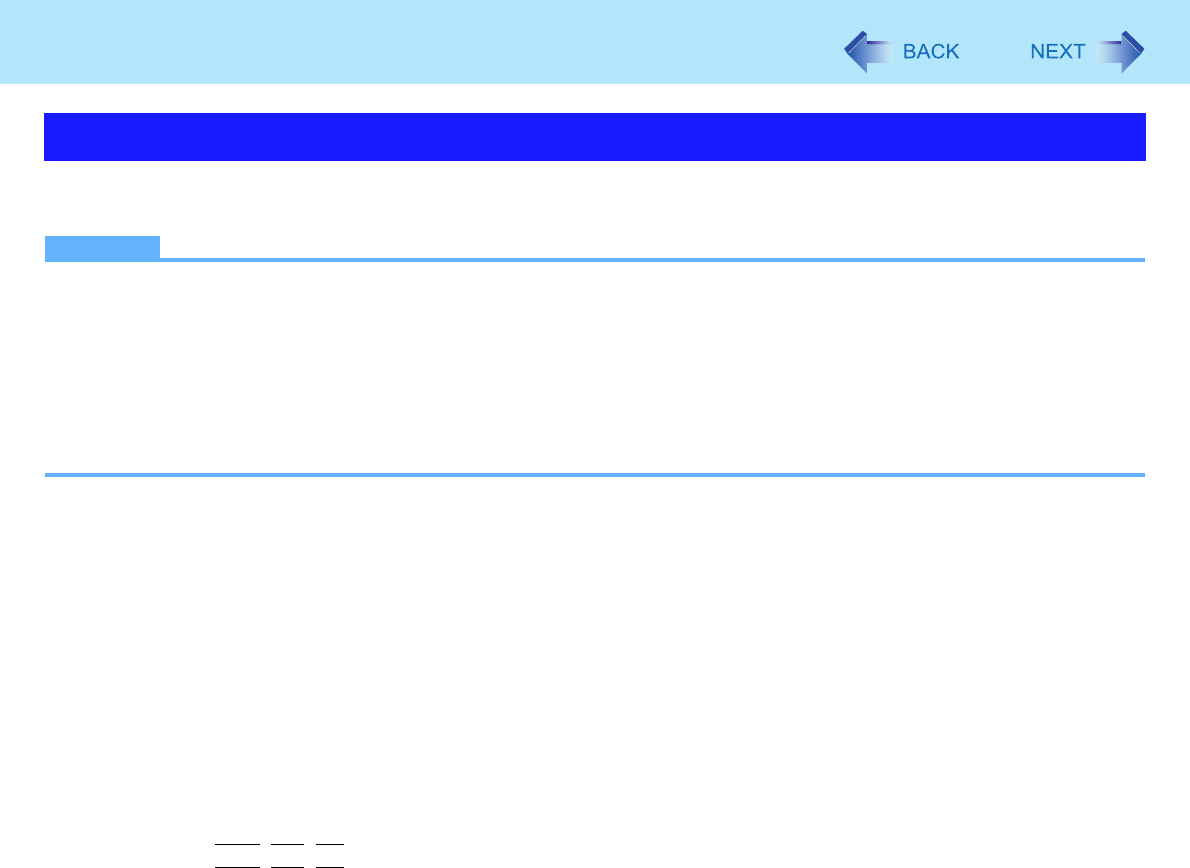
85
Troubleshooting (Advanced)
You can check the computer’s usage status in the PC Information Viewer. You may need this information when calling Pana-
sonic Technical Support for advice.
NOTE
zThis computer periodically records the management information including the hard disk information such as number of
hours powered-on, number of times powered-on, internal temperature, replacement sector. The maximum data vol-
ume for each record is 750 byte. These information are only used for estimating the cause when the hard disk goes
down by any possibility. They are never sent to outside via network nor used for any other purpose except for the pur-
pose described the above.
To disable the function, add the check mark for [Disable the automatic save function for management information his-
tory] in [Hard Disk Status] of PC Information Viewer, and click [OK].
zAs long as it is activated, the PC Information Viewer will appear in front of all other screens.
1Click [start] - [All Programs] - [Panasonic] - [PC Information Viewer] - [PC Information
Viewer].
2Select the item to display the detailed information.
To save the information as a text file
ADisplay the information you want to save.
BClick [Save].
CSelect the file save range option and click [OK].
DSelect the folder to save the information, input the file name, and click [Save].
To save a copy of the screen as an image file
ADisplay the screen you want to save.
BPress
Ctrl
+
Alt
+
F8
.
CWhen the screen copy message appears, click [OK].
The screen image is saved in [My Documents] folder.
zAlternatively you can save a copy of the screen in the following procedure.
Click [start] - [All Programs] - [Panasonic] - [PC Information Viewer] - [Screen Copy].
zIf automatic saving of the management information record has not been disabled, the records already recorded are
also saved.
Checking the Computer’s Usage Status

86
Troubleshooting (Advanced)
NOTE
zThe image is a bitmap file in 256 colors.
zWhen using the extended desktop (Îpage 47), a copy of the primary device screen is saved.
zThe default key combination to copy is
Ctrl
+
Alt
+
F8
. You can change it in the following procedure.
AClick [start] - [All Programs] - [Panasonic] - [PC Information Viewer].
BRight-click [Screen Copy] - [Properties] and click [Shortcut].
CClick [Shortcut key] and press the key(s) you want to use for the shortcut.
DClick [OK].

87
zCopyright
This manual is copyrighted by Matsushita Electric Industrial Co., Ltd. with all rights reserved. No part of this manual may
be reproduced in any form without the prior written permission of Matsushita Electric Industrial Co., Ltd. No patent liability
is assumed with respect to the use of the information contained herein.
© 2007 Matsushita Electric Industrial Co., Ltd. All Rights Reserved.
zDisclaimer
Computer specifications and manuals are subject to change without notice. Matsushita Electric Industrial Co., Ltd.
assumes no liability for damage incurred directly or indirectly from errors, omissions or discrepancies between the com-
puter and the manuals.
zTrademarks
• Microsoft, Windows and the Windows logo are registered trademarks of Microsoft Corporation of the United States and/
or other countries.
• Intel, Core, Viiv, Centrino and PROSet are either registered trademarks or trademarks of Intel Corporation.
• SD Logo is a trademark.
• Adobe, the Adobe logo and Adobe Reader are either registered trademarks or trademarks of Adobe Systems
Incorporated in the United States and/or other countries.
• PhoenixBIOS, Phoenix Always and Recover Pro are trademarks and/or registered trademarks of Phoenix Technologies
Ltd.
• Bluetooth™ is a trademark owned by Bluetooth SIG, Inc., U.S.A. and licensed to Matsushita Electric Industrial Co., Ltd.
• WinDVD™ is a trademark of InterVideo, Inc.
• Panasonic is a registered trademark of Matsushita Electric Industrial Co., Ltd.
• Names of products, brands, etc., appearing in this manual are trademarks or registered trademarks of their respective
own companies.
PCE0219B_XP
